organisms and its environment
- Books Name
- A TEXT OF BIOLOGY - CLASS XII
- Publication
- ACME SMART PUBLICATION
- Course
- CBSE Class 12
- Subject
- Biology
ORGANISM AND ITS ENVIRONMENT (Major Ecosystems)
The large natural ecosystem which is distinct in its climatic conditions and has its specific group of climax plants and associated animals constitutes a biome.
Regional and local variations within each biome lead to the formation of a wide variety of habitats.
Rainfall, temperature range, nature of soil, barriers, latitude and altitude determine the nature and extent of biomes.
Major Biomes of India :
1. Tropical Rain forests:
In India, tropical rain forests are found mainly along western ghats and in North-Eastern Himalayas.
Dipterocarpus and Hopea are the most common tree species in Indian rain forests.
They show 30-40 m tall canopy with 4 -5 strata.
These possess highest standing crop among all biomes.
Buttress and leaf drip tip are common.
Woody climbers and epiphytes grow profusely in these forests.
The soil of such forests is highly leached and has low base content, so nutrient storage in soil is low.
They require mean annual temperature of 23 -27°C and 2000 -3500 mm rainfall.
2. Tropical Deciduous forests:
They occur in the northern and southern parts of our country in plains and low hilly areas.
Sal, teak, tendu, khair and chiraunji are common trees of these forests.
These forests show a short structure of 10-20 m.
During rainy season, the forest is lush green with dense foliage, whereas, in summer forest is largely leafless.
The soil of these forest is rich in nutrients due to less leaching.
They require a mean annual temperature of 22-32°C and mean annual rainfall of 900-1600mm.
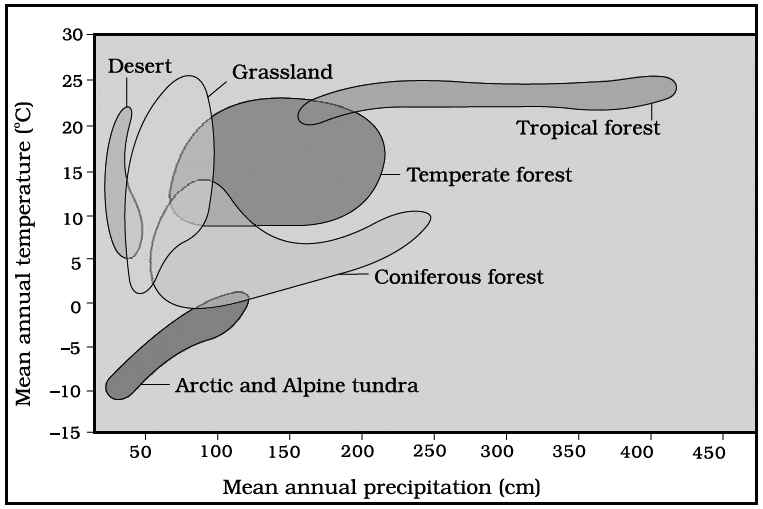
Fig. : Biome distribution with respect to annual temperature and precipitation
3. Desert:
In these biomes the vegetation is very sparse due to extremes of temperature and very little rainfall (below 10 cm).
Hot deserts are characterised by high rate of evapotranspiration and albedo.
In cold deserts, the conditions are physiologically xeric and they exhibit permafrost while in hot deserts the conditions are physically xeric.
Important trees of Indian desert are Prosopis cineraria, Acacia sp., Salvadora sp. and Tamarix sp. common succulents are species of Euphorbia and many members of family Cactaceae. Cenchrus is an abundant grass of these biomes.
4. Coastal Biome :
Coastal areas are zones of transition between oceanic and terrestrial habitats, so are very sensitive.
These are detritus based biomes, where plants have to adapt for salinity and water logged conditions.
Mangrooves are the major types alongwith salt marshes or swamps.
Mangrooves are characterized by presence of pneumatophores and viviparous seed germination.
Common examples are Rhizophora, Sonneratia, Avicennia and Laguncularia. Besides this Phoenix, Pandanus and Casuarina are also found commonly in coastal areas.
5. Temperate Broad Leaf Forests:
Between 1500 m -2400 m altitude in western Himalayas predominated by oaks. e.g., Quercus floribunda , Q. lanuginose etc.
They require mean annual temperature of 6 -20°C and mean annual rainfall of 1000-2500 mm.
Show peak leaf fall during summer but never become leafless.
These have four strata with 25-30 m height and are rich in epiphytic flora.
Herbaceous layer is least developed and grasses are generally lacking.
6. Temperate Needle Leaf or Coniferous Forest:
Between 1700-3000 m altitude.
They require mean annual temperature of 6-15° C and mean annual rainfall of 500-1700 mm.
Taller trees (30-35 m) with evergreen canopy.
Predominated by economically valuable gymnospermous trees, like -Pine (Pinus wallichiana), Deodar (Cedrus deodara) , Silver fur (Abies pindrow), Spruce (Picea smithiana) and Cypress (Cupressus torulosa).
Some Important Biomes of the World -A Brief Account
A. Tundra :
It is located in the north of timber line or 60º N latitude below the polar ice.
It is absent in southern hemisphere.
It extends across North America, Europe and Asia.
Also called as arctic tundra.
Subsoil remains frozen except upper few inches in the summers.
The condition is called permafrost.
Vegetation is scanty, low growing and devoid of trees and thus, the region is termed arctic desert.
Common plants found here are grasses, sedges, mosses and lichens with occasional occurence of dwarf birches (Betula) and willows (Salix).
B. Taiga (North coniferous/temperate needle leaf forest) :
It stretches as an east west band just south of tundra across North America, Europe and Asia. It is also found in southern hemisphere.
Mean annual rainfall is 50-170 cm. In winter, average maximum temperature is 6°C and nights are long and chilly.
Summers are pleasant with average maximum temperature of 20°C and with long hours of day light.
The characteristic feature of this biome is the presence of numerous lakes.
Dominant climax vegetation of this biome comprises of tall evergreen conifers with needle-like leaves, capable of tolerating fluctuations in temperature and light intensity.
C. Chapparal (Mediterranean scrub forest) :
The biome extends along the Mediterranean, Pacific coast of North America, Chile, South Africa and South Australia.
Natural fires are characteristic of this biome.
Rainfall is very limited, occurs only in winter.
The climate remains dry in the rest of the year.
D. Grasslands:
(a) Savanna: Tropical gras.sland with well developed grass cover interspersed with scattered shrubs and small trees.
(i) Distributed in warmer parts of India, Africa and Australia.
(ii) Appear in areas with highly seasonal climate having distinct wet and dry periods.
(iii) Abundance of C4 photosynthetic grasses.
(iv) Common grasses of Indian savannas are -Dichanthium, Sehima, Phragmites, Saccharum, Cenchrus, Imperata and Lasiurus. Common trees and shrubs are -Zizyphus, Prosopis, Capparis, Acacia and Butea.
(b) Temperate grasslands : The temperate grasslands are present in North America (Canada and U.S.A.), South America, Eastern Europe, Central Asia, South Africa and Australia. These are of different types depending upon the constituent flora in different countries, such as Prairies (Canada and the USA), Pampas (South America), Steppes (Europe and Asia), Veldts (South Africa), Tussocks (New Zealand) and Dawns (Australia).
Aquatic Biomes
The aquatic ecosystems range from ocean to small ponds or lakes showing wide range of variations regarding salinity, depth and temperature.
Consequently the organisms show lot of diversity in their adaptations to the surroundings.
Aquatic biomes are of four main types:
1. Oceanic or marine biomes:
Oceanic biomes occupy more than two third of the earth's surface.
The marine environment is characterized by high concentration of salts (about 3.5% in open sea) and mineral ions (mostly Na+ and Cl– ions followed by sulphur, magnesium and calcium).
The productivity of oceanic biome is less than that of most the terrestrial biomes.
The ocean basin is always like a wash basin or inverted hat and is differentiated into continental shelf, continental slope and ocean floor.
(i) Continental shelf: It extends from coastline to about 160 km in the sea, including a gradual sloping area with depth varying from 8-200m. It has high productivity.
(ii) Continental slope: It extends beyond continental shelf formed by abrupt steepening of angle of slope. It is characterized by presence of ridges, trenches and basins of mud and sand.
(iii) Ocean floor: It is nearly horizontal with deep trenches at places. It is bottom area of open sea.
Oceanic biome is divided into three major ecosystems-open sea, coastal region and estuary.
(i) Open sea: It includes the area of sea beyond continental shelf and is divided into 3 zoneseuphotic, disphotic and abyssal zone depending upon the degree of light penetration. On the basis of environment, it has two parts-pelagic (open water zone) and benthic (bottom zone).
Both producers and consumers occur in photic zone in abundance, whereas only few producers alongwith consumers occur in disphotic zone. The abyssal zone is characterized by the presence of consumers, scavengers and decomposers, while producers are absent.
(ii) Coastal region : It is the area of continental shelf and is usually divided into 3 zones: intertidal, littoral and neritic zones.
Intertidal zone is alternately exposed and covered with water. Beaches belong to this zone. Very few plants grow in sandy beaches. Crabs and few burrowing animals occur.
Littoral zone : It represents the floor area of continental shelf. This zone is characterized by strong wave action. Main producers of this area are brown and red algae like Laminaria, Macrocystis, Nereocystis and Gelidium.
Neritic zone : It comprises the coastal part (near shore area). It contains phytoplankton.
(iii) Estuary : Ecotone areas where river mouth meets the oceanic water. This area shows wide fluctuations in salinity due to mixing of fresh and sea-water. Estuary constitutes one of the most productive ecosystems. It includes both fresh water and marine organisms.
2. Ponds and lakes:
These are stationary fresh water bodies (Lentic ecosystems) on land occur in almost all biomes.
Ponds vary in size and may be natural or man-made depressions which get filled with rain or run off water.
These may be seasonal or permanent.
The lakes are much larger than ponds and have size of several hundred hectares with depth upto 100 meters.
Lakes develop in nature due to three reasons-(i) result of glaciation, (ii) natural or man-made depressions getting filled with water (iii) formed by cut off water from main stream of river and may be termed ox-bow or cut-off lakes.
3. Streams and Rivers:
These are flowing fresh water bodies (Lotic ecosystems) which differ in physical and chemical conditions, oxygen content, temperature, speed and volume of water.
River beds having sand are less in productivity than the ones having mud and stones.
Planktons are very rare in higher reaches due to fast moving water, while these appear in lower reaches when water flow slows down.
4. Marshes:
These are temporarily produced low lying areas, few cms in depth, containing turbid water.
These are common on the side of road, railway track, rivers, streams and inside forests.
Planktons are little due to turbidity of water and temporary nature.
Amphibious plants are common.
MAJOR ABIOTIC FACTORS
The most important key elements that lead to so much variation in the physical and chemical conditions of different habitats are temperature, light, water and soil.
(A) Temperature
Ecologically it is the most relevant factor, as temperature variation affects the enzyme kinetics, basal metabolic activities and the physiological functions of the organisms.
So thermal tolerance decides the geographical distribution of different species to a large extent as for example ; mango trees do not and cannot grow in temperate countries like Canada and Germany, snow leopards are not found in kerala forests and tuna fish are rarely caught beyond tropical latitudes in the ocean.
Based upon thermal tolerance, organisms are of two types:
(i) Stenothermal : Such organisms live in areas where the temperature is uniform throughout the year. The organisms cannot tolerate large temperature variation.
(ii) Eurythermal : Such organisms can tolerate large changes in temperature.
The organisms are classified into four temperature groups on the basis of their occurrence in different climatic zones:
(i) Megatherms : Organisms are adapted to high temperature throughout the year as found in tropical zone.
(ii) Mesotherms : They are adapted to mild winters and high summer temperature. The organisms live in subtropical zone.
(iii) Microtherms: They live in temperate areas where the winter temperature is low but the summer temperature is moderate.
(iv) Hekistotherms: The organisms are adapted to brief summer period of below 10°C and long snowy winter period. This condition occurs in arctic or alpine zone.
Some Rules Based Upon Effects of Temperature
(i) Bergman's Rule: Warm blooded animals (birds and mammals) have larger body size in cold climate than in hotter areas.
(ii) Allen's Rule: Extremities (legs, ears, tail and mouth) of warm blooded animals become smaller in colder areas as compared to animals of warmer areas.
(iii) Rensch's Rule: In colder climate, birds possess narrow and acuminate wings as compared to broader wings of birds found in warmer areas.
(iv) Jordan's Rule: As the temperature is lowered, some fishes possess larger size with larger number of vertebrae.
Thermoperiodicity
Thermoperiodicity or thermoperiodism is the response of living organisms to regular changes of temperature.
It is of two types, diurnal and seasonal.
(i) Diurnal Thermoperiodicity : It is response of organisms to daily changes of temperature. Generally, day time temperature is higher, while night time temperature is lower.
(ii) Seasonal Thermoperiodicity : It is response of organisms to seasonal changes in temperature. Alongwith photoperiodicity, it controls phenology of plants. Phenology is the occurrence of seasonal activities in relation to change in environmental conditions.
Thermal Stratification in Lakes
The occurrence of temperature variations in different horizontal layers as in a deep water body is called thermal stratification.
A deep water body like lake has three temperature strata -epilimnion, metalimnion and hypolimnion.
(a) Epilimnion: Upper stratum, with highest dissolved oxygen concentration. This area is warmer during summers.
(b) Hypolimnion: Lower stratum of water characterised by a temperature gradient of less than 1°C per meter. It contains more dense, cooler and relatively quite water.
(c) Metalimnion: It is transitional stratum of marked thermal fluctuations between hypolimnion and epilimnion. Its middle layer is characterised by temperature gradient of more than 1°C per meter of depth called as thermocline. The term thermocline refers to plane or surface of maximum rate of fluctuations in temperature of metalimnion.
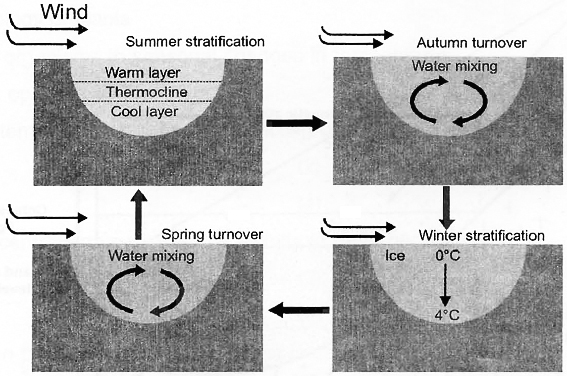
Fig. : Thermal stratification in a temperate lake
(B) Water
Next to temperature, water is another important factor influencing the life of organisms.
It is an important component of protoplasm which is a general solvent.
Water is also present over more than 71% surface of earth as oceans, lakes, rivers, ice caps and glaciers.
Sea water has high percentage of salt content (3.5%).
Water present on land is called fresh water. Its salt content is low i.e., less than 0.5%.
The salt concentration (measured as salinity in parts per thousand) is less than 5 percent in inland water, 30 -35 percent for sea and more than 100 percent in some hypersaline lagoons.
Some organisms are tolerant to a wide range of salinities (euryhaline), but others are restricted to a narrow range (stenohaline).
Regular movement of water amongst various regions and components of biosphere viz. aquatic systems, air and land constitutes water cycle.
Water comes over land or water body as precipitation or rainfall.
The total global rainfall is equal to 4.46 G.
Precipitation comes from water vapours present in air.
At any time atmosphere contains only 0.13 G of water vapours (1 G or geogram = 1020 gram).
(C) Light
Light has a wide range of spectrum.
Electromagnetic spectrum is a complete range of oscillating waves that travel together through space at a speed of 3 × 105 km/sec.
At 83 km above Earth's surface, solar radiation carries energy equivalent to 2 cal/cm2/min. This value is called as solar constant.
Short wave radiations are Cosmic Rays (with wavelength less than 10–5 nm), gamma rays (10–3 to 10–5 nm), X-rays (10–1 to 10–2 nm) and UV rays (100 to 400 nm).
All the short wave radiations are extremely harmful. Most of them are trapped in ionosphere and mesosphere.
UV rays are also harmful. They are of three types :

UV-C and about half of UV-B radiations are absorbed by ozone layer of stratosphere.
A large amount of the rest is dissipated by particles of troposphere, only a small amount reaches on the Earth.
Light affects photosynthesis, growth, reproduction, movements, stratification, photoperiodism and phenology in plants, whereas, it affects migration, reproduction, development, pigmentation, locomotion and periodic activity in animals.
Light Zonation of Lakes :
Littoral zone Exposed to wave action and is highly productive
Limnetic zone Open water body, rich in planktons.
Euphotic zone Receives maximum light above light compensation point.
Disphotic zone Receive diffuse light at or below light compensation point. Also known as twilight zone.
Profundal (Dark) zone No light
Benthic zone It is the bottom zone of perpetual darkness.
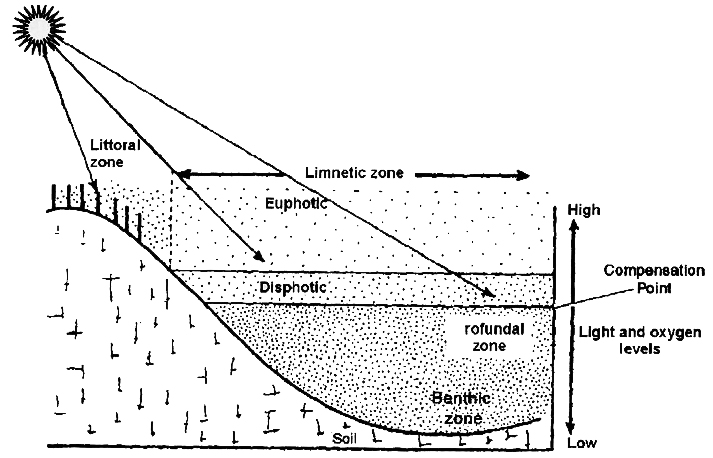
Soil Composition
Soil consists of four components, two solid and two non-solid.
The solid components are mineral particles and organic matter.
The two non-solid components are air and water.
A fifth component of variable nature is soil organisms.
The proportion of different components is
Mineral Particles 40%
Organic Matter 10%
Air 25%
Water 25%
Chief characteristics of the soil are studied with the help of soil profile.
Type of soil profile depends upon climate and vegetation of the area.
The smallest three dimensional volume of soil required to study its profile is called pedon.
Most soils possess 3-4 horizons and a number of sub horizons.
A soil horizon is a horizontal layer approximately parallel to soil surface that possesses distinctive properties which are unlike the ones present in adjoining regions. In general, a profile consists of O, A, B, C & R horizons.
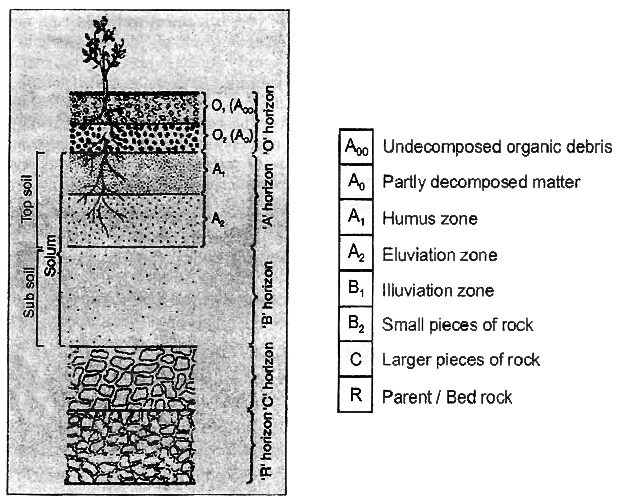
Weathering
It is the breaking of rocks into fine particles as present on the soil.
Weathering occurs due to the following methods:
(i) Physical Weathering: It is caused by alternate heating and cooling, alternate wetting and drying, action of frost, snow, rain and wind.
(ii) Chemical Weathering: Oxidation, reduction, carbonation and solubilization reactions to break the rock.
(iii) Biological Weathering : By Lichens, Mosses.
Humification
It is addition of organic matter or humus into weathered rock.
Humification is essential for starting biological activity and nutritional cycling.
Humus is dark coloured amorphous substance, is slightly acidic, colloidal and acts as reservoir of nutrients.
Main functions of humus are biogeochemical cycling, preventing soil from compaction, helping in formation of soil crumbs, improving aeration and water holding capacity of soil.
It also makes soil spongy, therefore, easy for penetration by the roots.
Eluviation and Illuviation
These two processes bring about transport and deposition of materials in the soil.
Eluviation is washing down of materials from upper strata.
Eluviation helps in enriching the different layers of soil with minerals.
Illuviation is deposition of washed down minerals in lower strata.
Mineral Matter
It consists of inorganic substances present as particles of different sizes and composition.
(i) Gravel: It is made of fine pebbles with a size of 2-10 mm.
(ii) Sand: It consists of grains of quartz or silicon dioxide (Si02). Size varies from 0.02-2.0 mm. Sand is chemically inert. It allows quick percolation of rain or irrigation water. Aeration is good.
(iii) Silt: It is formed of fine grains of quartz. The size is 0.002-0.02 mm. It is chemically inert.
(iv) Clay: It is made of Al, Fe and Si. The size is below 0.002 mm. Clay particles are chemically active and have fine interspaces that can hold abundant water but aeration is poor.
Soil Porosity
It is percentage of interspaces present per unit dry weight of soil.
The value of soil porosity is 30% in sandy soils, 45% in loam soil and 50% in clay soil.
There are two types of soil pores, micropores and macropores.
Micropores are small sized interspaces having a diameter of 20 µm or below.
They hold water by capillarity. Macropores are interspaces with a size of more than 20 µm.
Soil Air
It is air present in macropores with a size between 20-50 µm.
A good soil should have 25% air by volume.
Soil air is required for respiration of roots and several microorganisms.
Soil air is richer in CO2 and poorer in O2.
Soil Types
(a) Red Soils: These are acidic laterite soils which are deficient in lime, magnesium, phosphorus and potassium, but rich in organic matter, iron and aluminium. Such soils support tea, coffee, rubber, cardamom, areca nut and p'addy cultivation.
(b) Black soils : Also called black cotton soils/regurs with dark brown or black colour from organic matter, clay/hydrated iron and aluminium silicate and have undifferentiated B-horizon (A-C soil).
(c) Terai/Babar soils: Mostly colluvial and highly productive.
Residual soils develop in situ. Transported soils are brought from other places through gravity (colluvial), running water (deposited at flood plains and called alluvial), wind (eolian = aeolian) and glacier (glacial soil).
Soil Texture
Three main types.
(a) Sandy soils:
The soils contain about 80% or more of sand, the remaining being silt and clay. Sandy soils are porous and loose. Water holding capacity is poor. Chemical nutrition is little.
(b) Clay soils: They are soils having 40-50% of clay, the rest being silt. Sand is little. Clay soils have abundant capillary pores. Therefore, water holding capacity is high. Inorganic nutrients are available in good quantity. However, aeration is poor.
(c) Loam soils: The soils contain 20% clay, 40% sand and 40% silt. These have good mineral nutrition, aeration and hydration. Therefore, loam soils are the best for plant growth.
Soil pH
It determines the type of soil microorganisms, solubility of different minerals and type of plants which can grow.
In alkaline soils (pH above 7), there is reduced availability of Zn, Mn, Cu and Fe.
In acidic soils there is abundance of iron, Mn and Al, but deficiency of Ca, Mg and K.
Certain soils possess excess of salts especially those of Na and Mg.
They are called Saline soils. Salinity increases with excessive irrigation.
Soil Organism
A number of organisms live inside soil.
It includes bacteria, actinomycetes, fungi, algae, parts of higher plants, protozoa, rotifers, nematodes, insects, earthworms, molluscs and burrowing vertebrates. They form the living components of soil.
(E) Topography
Topography i.e., surface configuration of an area (physical features like hills, plains or slopes) also influences the distribution of organisms. For example,
(i) The centre and edge of a pond or a stream
(ii) Exposed side and underside of a rock
(iii) North and South face of a ridge or a mountain are usually inhabited by different species of organisms.
RESPONSE TO ABIOTIC FACTORS
Change in one environmental factor leads to change in others also i.e., all factors are integrated.
An organism would have evolved various mechanisms to maintain its internal environment at homeostasis to perform its physiological and biochemical functions in response to changing external factors of environment.
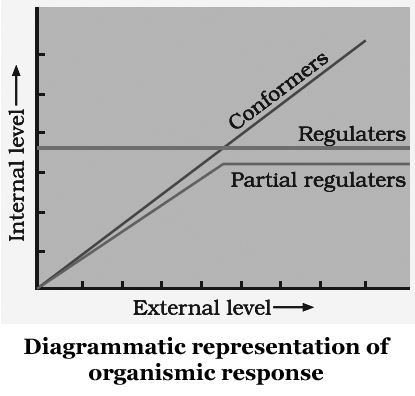
This constancy is necessary for its overall fitness or maximum performance. This may be maintained naturally or artificially.
There appears various possibilities of responses, such as :
(i) Regulate: It is maintenance of homeostasis by physiological or behavioural means like thermoregulation and osmoregulation. e.g., all birds and mammals and a few lower vertebrate and invertebrates; but plants do not have such mechanisms.
Evolutionary success of mammals is believed largely due to their regulation ability.
(ii) Conform: These organisms cannot maintain thermal and osmotic balance with environment. e.g., approximately 99% of animals and nearly all plants. Thermoregulation is energetically expensive especially for small animals having large surface area relative to their volume, due to this, very small animals are rare in polar regions.
Some species have ability to regulate upto a limited range, beyond which they simply conform (partial regulators).
For localised or short outburst of stressful conditions the organisms have two alternatives, like migration or suspended growth.
(iii) Migrate: Temporary movement of organisms from stressful area to more favourable area in terms of food, shelter, spawning or climate.
e.g., Siberian crane migration from Siberia to Keoladeo National Park (Bharatpur, Rajasthan). Locust migrates for food and salmon fish migrates for egg spawning. Ungulate migration in Africa is for food .
(iv) Suspend: It is the stage in life cycle where an organism changes its developmental, physiological, structural, biochemical behaviour to pass through unfavourable conditions. e.g., Thick walled spores in bacteria, fungi and lower plants.
Dormancy in seeds and other vegetative parts in higher plants.
Hibernation (winter sleep) is shown by organisms which are unable to migrate, like Bears.
Aestivation: It is metabolic inactivity of organism during hot dessicating summers. e.g., snails and fishes.
Diapause : Stage of temporary suspension of development under unfavourable conditions. e.g., Zooplanktons in lakes and ponds.
ADAPTATION
It is an attribute of the organism that enables it to survive and reproduce in its habitat. Adaptations may be morphological, physiological or behavioural and are either fixed genetically or remain epigenetic.
Some adaptations are given below :
(i) Seals have a thick layer of fat (blubber) below the skin to reduce loss of body heat.
(ii) Altitude sickness can be expressed at high altitude where body does not get enough oxygen due to low atmospheric pressure and causes nausea, fatigue and heart palpitations. Under these conditions, body increases RBC production, decreases binding capacity of Hb and increases breathing rate. These physiological adaptations allow organisms to respond quickly to stressful conditions.
(iii) Archaebacteria can flourish at temperature exceeding 100°C while humans can perform the metabolism in a narrow range (37ºC).
(iv) Antarctic fishes can survive below 0°C and a variety of invertebrates and fishes are adapted biochemically to survive great depths with crushing pressure. In Antarctic fishes, body fluid contain antifreeze solutes.
(v) Desert lizards lack the physiological ability to cope with extreme temperature but manage the body temperature by behavioural means.
(vi) Kangaroo rat of North American desert fulfil water demands by internal oxidation of fats and it also has the ability to concentrate its urine.
Water Based Adaptations (Plant Specific)
On the basis of dependence of plants on water and relations of plants to water, Warming (1909) recognised three kinds of plant communities:
(1) Hydrophytes, (2) Mesophytes and (3) Xerophytes
1. Hydrophytes
Plants growing in water or in water saturated soil are called hydrophytes. They require abundance of water to complete their life cycle. These are of basic three types:
A. Submerged: Submerged plants are those in which the leaves are entirely beneath the water e.g., Hydrilla, Vallisneria, Potamogeton and Ceratopyllum.

B. Floating: In floating plants leaves float on the water surface, but roots and stem may remain in water, or float on water like the leaves. On the basis of root fixation, these are classified into two groups.
(i) Free floating: They change their position due to water current, because their roots are not embedded in soil. Leaves float on the water surface and stem and roots are also free from substratum e.g., Wolffia, Lemna, Eichhornia, Pistia.
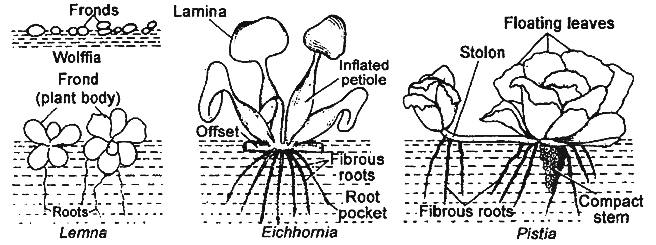
(ii) Rooted floating: In these plants leaves float but the roots adhere to bottom soil particles e.g., Nelumbium speciosum, Nymphaea stel/ata, Jussiaea, Trapa etc.
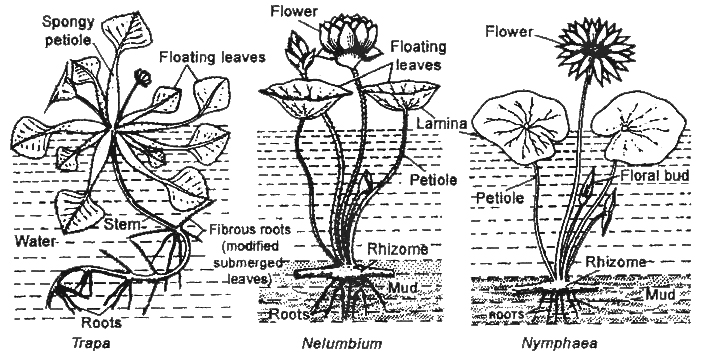
C. Amphibious plants: The basal part of the body (roots and lower portion of stem) is embedded in water saturated soil. The remaining body (upper part of stem and leaves) lie straight up, emerging in the air. Occasionally due to rain, leaves also may be immersed into water e.g., Typha, Ranunculus, Polygonum, Cyperus etc.
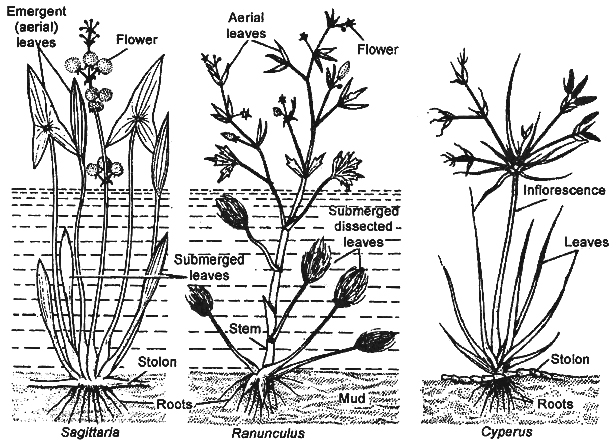
Morphological adaptations
Root:
1. Roots are either completely absent (e.g., Salvinia, Wolffia, Ceratophyllum) or poorly developed (e.g., Hydrilla).
2. Root pockets are present as balancing organs in Azolla, Eichhornia, Lemna, Pistia etc. instead of root cap.
3. Some hydrophytes have floating roots in addition to normal adventitious roots which provide buoyancy e.g., Jussiaea repens.
Stem:
1. Long, slender, spongy and flexible e.g., Potamogeton and Hydrilla.
2. It may float horizontally on the surface of water e.g., Azolla or may form offset as in Eichhornia or may be a rhizome e.g., Nymphaea.
Leaves:
1. Long, slender, delicate petioles with floating leaves e.g., Nymphaea.
2. Petiole may be swollen and spongy e.g., Eichhornia.
3. Submered hydrophytes have thin, long ribbon shaped leaves (e.g., Vallisneria) or finely dissected leaves e.g., Ceratophylum.
4. Leaves of floating hydrophytes are large, entire and flat. These are often coated with wax e.g., Nymphaea or covered with hairs e.g., Salvinia.
5. Emergent hydrophytes show heterophylly i.e. leaves below the water are long, narrow, and dissected and those outside the water are entire and broad e.g., Ranunculus aquatilis, Umnophilla heterophylla, Sagittaria sagitifolia.
Anatomical adaptations
1. Presence of large air spaces and aerenchyma.
2. Mechanical tissue i.e. sclerenchyma is either poorly developed or absent. In Typha, pith is sclerenchymatous.
3. Vascular tissue specially xylem is poorly developed.
4. Cuticle is absent.
5. Stomata are absent or vestigeal in submerged hydrophytes. Floating leaves are epistomatic and emergent leaves are isostomatic.
6. Epidermis is always single layered.
7. Mesophyll is uniform.
2. Mesophytes
Plants growing in places of moderate water supply. These plants cannot live for a long time either in water saturated or in moisture deficient soil. e.g., garden plants and crops.
3. Xerophytes
Plants growing in places of deficient water supply. These plants grow in deserts or on rocks, e.g., Opuntia, Aloe, Agave, Casuarina, Calotropis, Muehlenbeckia, etc.
Types of xerophytes :
(A) On the basis of nature of soil and cause of unavailability of water:
(a) Physical xerophytes grow in soils which are physically dry (due to shortage of water) e.g. Opuntia, Casuarina, Ruscus, Muehlenbeckia (Cocoloba) etc.
(b) Physiological xerophytes grow in soils having sufficient water which is not available due to high salt concentration (salinity) or very low temperature.
(B) On the basis of life cycle and water storage:
(a) Ephemerals: Short living, brief life span (6-8 weeks), escape dry season by disappearing leaving their seeds; hence, not true xerophytes, so are called drought evaders and drought escapers e.g. Cassiatora, Tribulus.
(b) Succulents (fleshy xerophytes) : Absorb large quantities of water during rainy season and store it in different body parts; suffer only externally; hence drought avoiding or drought resistant xerophytes.
(i) Stem succulents (chylocauly) : e.g., Opuntia, Euphorbia antiquorum, E. splendens,
E. tirucalli, Cereus.
(ii) Leaf succulents (chylophyllous) : e.g., Aloe, Agave, Begonia, Bryophyllum.
(iii) Root succulents (chylorhizous) : e.g., Asparagus, Ceiba parviflora.
(c) Non-succulents : Drought endurers, true xerophytes; can withstand long drought periods (perennial non succulents) e.g., Casuarina, Zizyphus, Nerium, Acacia, Capparis.
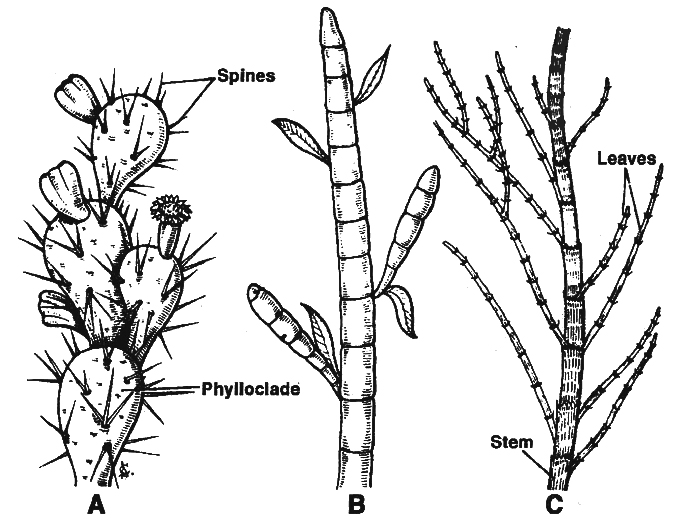
Fig. : A. Phylloclade of Opuntia, B. Phylloclade of Muehlenbeckia , C. Casuarina
Morphological adaptations
Root:
1. Roots are well developed, profusely branched and extensively spread.
2. Roots are deep (phreatophytes).
Stem:
1. It is generally hard and woody with thick bark.
2. Mostly covered with hairs, wax, silica.
3. Some plants may show modification of stem into leaf like structure called phylloclade e.g. Opuntia; while in Ruscus and Asparagus the stem is modified into cladode.
Leaves: are modified in the following ways.
(a) Sclerophyllous: Stiff and hard leaves e.g., Banksia, Dasilirion.
(b) Trichophyllous: Leaves covered with hair e.g., Nerium, Calotropis.
(c) Microphyllous : Small, fleshy leaves e.g., Capparis.
Leaves of xerophytes are generally caducous e.g., Euphorbia or may be completely absent e.g., Capparis aphylla. Leaves of grasses get rolled to reduce transpiration e.g., Agropyron, Ammophila.
Anatomical adaptations
1. Presence of thick cuticle on leaf and stem epidermis.
2. Presence of waxy layer on the epidermis of leaves.
3. Stomatal frequency is reduced.
4. Sunken stomata are present.
5. Hairs are present on the leaf epidermis and substomatal chamber.
6. Intercellular spaces are only few and small.
7. Mechanical tissue i.e., collenchyma and sclerenchyma are well developed.
8. Epidermis may be multiple.
9. Water storage tissue is present.
10. Vascular tissues are present in large amount.
4. Halophytes
Plants growing in saline soil.
Morphological characters
Root: Mangrooves have specialized roots called pneumatophores which are negatively geotropic. These are modified tap roots which have pneumathodes for gaseous exchange.
Stem : Mostly succulent or fleshy.
Leaves: Evergreen, thin, leathery.
Anatomical characters
1. Presence of thick cuticle on stem.
2. Stem hypodermis is multilayered, thick walled.
3. H-shaped specules are present in the stem cortex to provide mechanical support.
4. Pericycle is sclerenchymatous, 3-4 layered.
5. Vascular tissue is well developed
6. Upper and lower leaf epidermis is thickly cuticularized.
7. Sunken stomata are present only in the lower leaf epidermis.
populations
- Books Name
- A TEXT OF BIOLOGY - CLASS XII
- Publication
- ACME SMART PUBLICATION
- Course
- CBSE Class 12
- Subject
- Biology
POPULATIONS
(i) Deme: Local population (population living in a specific area).
(ii) Metapopulation : Whole set of local populations connected by dispersing individuals.
(iii) For the purpose of ecological studies, a group of individuals resulting from asexual reproduction is also considered as population.
Population attributes / group attributes
Some characters are unique to the group and are not characteristic of the individuals forming it, like an organism born and dies, and has age, but it does not have a birth rate, death rate and age ratio.
These population characters can be best expressed by statistical methods, some important characters are:
1. Population Density
The number of individuals per unit area, like millions of Spirogyra filaments in a pond, or 200 plants of Parthenium in an area.
This can also be expressed as "The population biomass per unit area or volume" when we have to count a large number of organisms (like grasses) or to find out the role of a single huge banyan tree in an area.
Relative density is a good measure of finding out the total density of fishes in a lake by counting the number of fishes caught per trap.

 Tiger census in India is based upon pug marks and fecal pellets which indirectly estimates population size.
Tiger census in India is based upon pug marks and fecal pellets which indirectly estimates population size.
2. Age Ratio Pyramids
Age Pyramlds : An age pyramid is a graphic representation of proportion of various age groups of a population. There are three types of age pyramids -triangular, bell-shaped and urn-shaped.
(a) Triangular : It is graphic representation of a young or growing population and has a very high proportion of pre-reproductive individuals.
(b) Bell-Shaped: The pyramid is bell-like with pre-reproductive individuals being only marginally more than the reproductive individuals. Population is said to be mature or stable.
(c) Urn-Shaped : It has small number of pre-reproductive individuals followed by a large number of reproductive individuals. Such a population shows negative growth.

3. Population Growth
Some attributes of population are used to estimate its growth, as population size may fluctuate in a given habitat during a given period due to change in four basic processes, namely
(i) Natality: Birth rate, inherent ability of a population to increase and refers to number of births during a given period in the population that are added to initial density.
The per individual change in a population due to natality can be estimated by using ![]()

Where, Nn = New individuals produced
N = Initial population
t = Change in time
(ii) Mortality: Death rate, number of individuals dying in a population in a given period.
(iii) Immigration : One way permanent inward movement of the individuals of same species into a habitat with existing population. This may help to speed up the growth or prevents extinction of a smaller population. In plants, it is equivalent to settlement of disseminules.
(iv) Emigration : One way permanent outward movement of number of individuals from a population to other habitat area, hence reducing the size of local population. Plants are fixed, so do not show emigration.
By these population characters the density of a population (N) at time t can be expressed after a period of time t + 1 as
N(t + 1) = Nt + [(B + I) -(D + E)]
Where; B = Number of birth, I = Number of immigrants, D = Number of deaths and
E = Number of emigrants
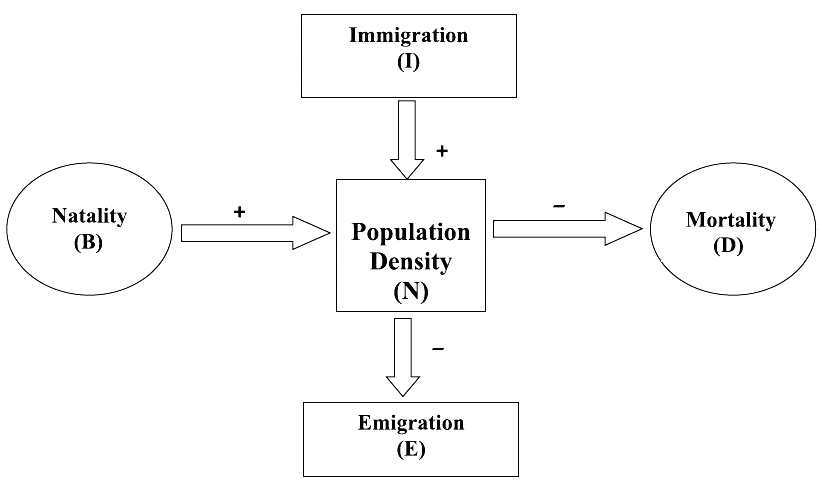
So, it can be concluded that births and deaths are most important factors influencing population density and other two are specialised cases.
4. Growth Models
Biotic Potential and Environmental Resistance: Biotic potential is the maximum or potential natality.
The sum of environmental factors that limits the population size is called environmental resistance.
Environmental resistance rises with the rise in population size.
The influence of environmental resistance over the biotic potential is denoted by (K-N/K).
Carrying Capacity (K) : The maximum number of individuals of a population which can be supported with optimum resources for their survival is called carrying capacity of the environment.
Growth of a population depends upon its biotic potential, death rate and birth rate. Depending upon the amplitude of these three, a population may show :
(a) Exponential growth, and (b) Logistic growth
(a) Exponential growth :
Darwin believed the geometric growth of a population when the resources are unlimited, as each species realises its inherent power to grow.
This intrinsic rate of natural increase is called r.
The value of r is an important parameter to assess impact of environmental factors on population growth.
(i) Any increase or decrease in a population N during time t will be dN/dt = (b - d) × N, where (b = per capita birth rate) and d = per capita death rate. If (b - d) = r, then dN/dt = rN
(ii) The integral form of exponential growth equation will be Nt = N0ert where; Nt = Population density after time t, N0 = population density at time zero, e = the base of natural logarithms (2.71828).
(iii) The magnitude of r was 0.0205 in 1981 for human population in India while it reached 0.0176 in 2001. For Norway rat it is 0.015 and for flour beetles it is 0.12.
(iv) Equation dN/dt = rN describes geometric growth resulting in a J-shape curve. Such population stops abruptly due to environmental resistance, which becomes effective suddenly, or a resource may become depleted. Decline in J-shape population is density triggered e.g., Algal blooms, insect population.
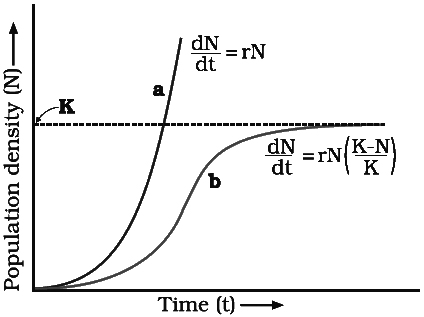
(b) Logistic Growth
This growth form is characterised by function of carrying capacity (K) for a given population, giving it a more realistic form.
Such forms are represented under limited resource conditions where a population finally reaches an asymptote.
This growth form can be described as Verhulst Pearl Logistic Growth and is expressed as  .
.
Since resources for growth for most animal populations are finite and become limiting sooner or later, this plot is more realistic.
Life History Variation : Populations evolve to maximise their reproductive fitness in a given habitat. It includes variation in life history, evolved in relation to the selection pressure imposed by environmental factors in order to achieve the most efficient reproductive strategy.
Some of the strategies are listed below:
(i) Small number of large sized individuals are produced (mammals and birds).
(ii) Larger number of small sized individuals are produced (Oysters and pelagic fishes).
(iii) Some organisms breed once in life time (Bambusa and Pacific salmon fish).
(iv) Some organisms breed many times during their life (mammals and many birds).
5. Population Interactions
The interactions between members of different populations are based upon 3 factors:
(i) Requirement and mode of obtaining food.
(ii) Nature of shelter or space required.
(iii) Habits of the species like aggregation, breeding etc.
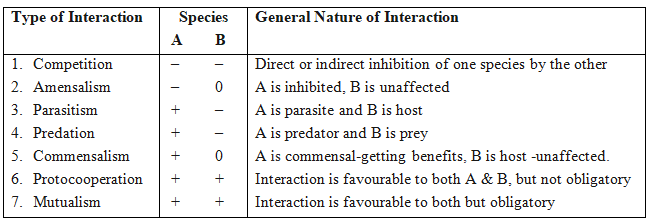
Different population interactions (+, -, 0 for beneficial,
detrimental and neutral respectively).
The various important types of interactions between members of biotic community are described below:
A. Competition
It is a process in which the fitness of one species (measured in terms of its 'r' the intrinsic rate of increase) is significantly lower in the presence of another species.
It is the struggle between two or more organisms for obtaining various requirements for their survival.
It is both intraspecific, i.e., between organisms of the same species and interspecific, i.e., between organisms of different species.
Intraspecific competition is more acute because all organisms of the same species have similar requirements for food, space, light, water, shelter, mate etc.
The interspecific competition occurs when organisms of different species belong to same trophic level or have similar feeding habit e.g., in grassland, severe competition occurs between herbivores like rabbits, deer, bisons etc., as all feed upon grass.
Competition for zoopalnktons between visiting flamingoes and resident fishes in South American lakes.
It may be emphasized that competition is noticed only when required commodity is in short supply.
If grass is in plenty and fulfill the needs of all herbivores of that area, there will be no competition or only little, if at all it occurs.
Carnivorous animals like tigers and leopards compete for the common prey.
In forest, shrubs, herbs and trees compete with one another for water, inorganic nutrients, sunlight and for insects that bring about pollination and for animals that bring about dispersal.
In competition superiority of individual (intraspecific) or superiority of species (interspecific) plays an important role.
No two species can occupy the same ecological niche and live together in a biotic community, this can be further understood by Gause's competitive exclusion principle (1934).
Gause found that if two species of Paramecium namely P caudatum and P aurelia, were grown together in same culture medium, initially both increase in number, but eventually P caudatum population declines and is eliminated by superior species P aurelia.
This shows that if two species are occupying same ecological niche and competing for common resources, then superior type will exclude or eliminate the inferior type of species.
There are some circumstancial evidences which supports exclusion of species due to competition e.g.,
(i) Introduction of goats resulted in exclusion of Abingdon tortoise from Galapagos islands.
(ii) Same interaction occurs between Balanus and Chathamalus on rocky coasts of Scotland (Connell, 1961).
Coexistence :
Species facing competition might evolve mechanism to live in the same niche by changing the feeding time or foraging patterns, i.e., resource partitioning.
If different species coexist inspite of being competitors, it is because they are specialised or adapted differently (different feeding habits) to obtain same resources.
That is why Darwin found that fourteen species of finches coexist in Galapagos islands due to development of different feeding habits.
Several plants grow together by sending roots to various depths.
More examples are cited below to explain coexistence aspect of competition.
(i) Five closely related species of warblers avoid competition by changing foraging pattern (MacArthur).
(ii) "Tribolium-Trifolium" model is best to explain both exclusion and coexistence.
(iii) Habitat diversification can also reduce competition e.g., Tribolium and Oryzaephilum (Crombic, 1947).
Competitive release: There occurs a dramatical increase in population of a less distributed species in a geographical area when its superior competitor is removed experimentally from that area.
Plant and herbivores are more affected than carnivores.
Resource need not to be limiting for competition to occur as feeding efficiency of one species might be reduced due to inhibitory presence of other species. This is called "interference competition".
B. Predation
It is a type of interaction in which the members of one species capture, kill and eat up members of other species.
The species that captures is called predator and the other that is captured is called prey.
Most of the animals except the scavengers (animals eating the dead animals only) are predators.
Even certain plants (e.g., Nepenthes, Utricularia, Dionaea, Drosera) are predators, catching and digesting insects in addition to their autotrophic mode of nutrition.
They are called insectivorous or carnivorous plants.
Prey-predator relationship, like competition, is an interaction of ecological importance.
Prey-predator relationship is utilized by man in biological control of pests.
Opuntia was weeded out in Australia with the help of its natural herbivore called Cactoblastis (Cochineal insect).
Red locust menace was brought under control in Mauritius by Mynah.
Mosquito larvae are eaten by larvicidal fish such as Gambusia (top minnow).
In the rocky intertidal communities of the American pacific coast the starfish Pisaster is an important predator.
Role of predation :
(a) Transfer of energy (in ecological sense herbivores are not very different from predators).
(b) Keeping prey population under control.
(c) Rabbit population in Australia increased tremendously because the land does not have its natural predators. Red faxes in Newzealand became top carnivores due to absence of a natural top carnivore.
(d) Predators help to maintain species diversity in a community as they can reduce the intensity of competition among prey species e.g., Experimental removal of Pisaster (star fish) resulted in extinction of more than 10 species of invertebrates in American Pacific coast.
(e) Term prudent predator (Slobodkin, 1962) explains that predator does not exterminate its prey by overexploitation.
For their defence, prey species have evolved various adaptations, viz
(i) Camouflage e.g., Insects, frogs

(ii) Monarch butterfly is well known for its general unpalatability to its predator birds. This insect is able to sequester the highly toxic glycosides present in milkweeds on which its caterpillar stages feed (Brower et.a/., 1968). There larvae develop on milkweed, providing the protection to plant against herbivory.
(iii) Highly poisonous cardiac glycosides are produced by Calotropis and nicotine, caffeine, quinine, strychnine, opium are other means of chemical defence in plants.
(iv) Association of bull horn Acacia cornigera with Pseudomyrmex ferrugenea (ant) is also against herbivory.
Association of Acacia -Pseudomyrmex and Monarch butterfly -milkweed are examples of coevolution also.
C. Parasitism
It is a relationship between two organisms of different species usually differing in size in which one organism spends a part or whole of its life, on or in the body of other organisms and gets nourishment and shelter from that.
The former organism is termed parasite and the latter as host.
This also depresses the growth rate of host population or may reduce the total size of host population.
Parasites are smaller generally, majority of them are host specific.
High reproductive potential, loss of digestive system and unnecessary sense organs, presence of specific sucking or adhesive organs are some of their characters, but they have poor means of dispersal.
D. Mutualism
It is an obligate association of two organisms in which each derives benefit from the other.
In mutualism, two organisms often live together and can't live separately, the two organisms may be plants, animals or one plant and other animal.
(i) Mutualism between plant and plant e.g., lichen (Alga and Fungus), mycorrhiza (Fungus and roots of higher plants), Rhizobium (N2-fixing bacteria in root nodules of legumes).
(ii) Mutualism between plant and animal e.g. , Green algae Chlorella vulgaris (endosymbiont) in gastrodermal cells of Hydra. Plant pollinator relation sometimes is a one-to-one coevolutionary relation like fig and wasp relation, Ophrys and Colpa relation, Yucca and Pronuba relation.
(iii) Mutualism between animal and animal e.g., Protozoan Trichonympha in gut of termites. Protozoan helps in cellulose digestion and in return gets shelter.
E. Protocooperation
It is a non-obligatory interaction between two organisms of different species, in which both are mutually beneficial to each other, but can easily live separately.
Two birds, namely red-billed ox pecker and yellow-billed ox pecker feed on ticks and other parasites sticking to the skin of black rhinoceros and relieve him of the parasites.
The birds sitting on Rhinoceros for feeding on ticks, etc., also warn the animal of approaching danger.
The birds are not only benefitting the animal, but themselves are benefitted too as the animal is providing food (ticks, etc.) to the birds.
This is an example of protocooperation as the birds have no close association with animal, it just visits him occasionally for feeding.
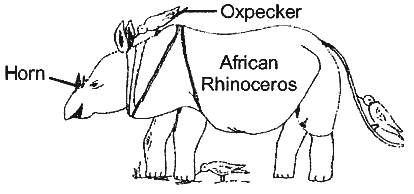
Another example of protocooperation is the relationship between plover bird and the crocodile.
The bird enters the open mouth of the crocodile, feeding on the leeches which are attached to the lining of buccal cavity.
The bird not only is getting benefit from the animal (getting food) but helps the animal in getting rid of leeches which are sucking its blood.
The association between sea-anemone and hermit crab may also be taken as an example of protoco-operation in which sea-anemone is attached to snail's shell.
Sea-anemone is sedentary and can move from one place to another using snail's shell as portable home and is able to procure more food.
The hermit crab is protected from its enemies by the sea-anemone having nematocysts.
F. Commensalism
It is an interaction between two organisms of different species, benefitting only one species, the other species is neither benefitted nor harmed.
The species which is benefitted is termed commensal and the other species is called host.
Examples of commensalism are observed in diverse types of animals and even in plants.
(i) The pilot fish (Remora) always accompanies shark with a purpose of feeding upon small pieces of food falling off when shark is tearing its prey. The fish is not attached to shark at any time.
(ii) Sucker fish is attached to underside of shark, getting a free ride and occasionally detaching itself when the latter is feed upon small pieces of food.
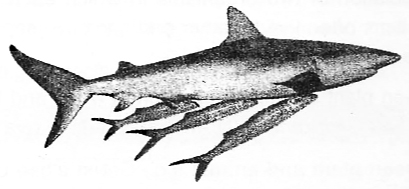
(iii) Jackals and arctic foxes follow lions and seals, respectively for feeding upon left out food pieces by the predators.
(iv) Barnacles (Balanus) live attached to whale's body, not getting any benefit from it except shelter.
(v) Epiphytes are attached to other plants but not getting anything from the host. They are green, thus nutritionally independent and have special hygroscopic roots which can absorb water present in the atmosphere in the form of vapours. They get shelter only from the host. They are able to get proper sunlight too for photosynthesis by growing on higher branches of trees in thick forests.
(vi) Cattle egrets (birds) forage close to where cattles are grazing because the cattles as they move, stir up and flush out from the vegetation insects that otherwise might be difficult for the egrets to find and catch.
(vii) Sea anemone has stinging tentacles that protect clown fish living among them.
G. Amensalism
It is an interaction between two organisms of different species in which one species inhibits the growth of other species by secreting certain chemicals.
This phenomenon of inhibition of growth of one species by the other species through secretion of certain chemicals is also termed allelopathy (in plants), or antibiosis or biological antagonism.
Examples of amensalism are evident in micro-organisms.
Penicillium secretes penicillin, that inhibits the growth of large number of bacteria. Similarly, different species of Streptomyces, an actinomycete, produce wide range of chemicals which inhibit the growth of other bacteria, some of which cause various diseases in human beings.
Such chemicals isolated from these microorganisms are thus, used as antibiotics for curing various diseases caused by bacteria.
Inhibition of growth of one species by organism of other species is observed in higher plants as well.
Roots of black walnut (Juglans nigra), secrete a chemical juglone which is toxic to other plants like apple, alfalfa, etc. Convolvulus arvensis inhibits the growth of wheat.
structure and function of ecosystem
- Books Name
- A TEXT OF BIOLOGY - CLASS XII
- Publication
- ACME SMART PUBLICATION
- Course
- CBSE Class 12
- Subject
- Biology
ECOSYSTEM -STRUCTURE AND FUNCTION
Structure of Ecosystem : The structure of ecosystem depends upon following components :
(i) Species diversity (ii) Species composition
(iii) Life cycle (iv) Stratification
Component of Ecosystem
1. Abiotic components : Consists of non living substances and factors like.
(i) Climatic factors i.e. air, water, light, temperature and precipitation.
(ii) Edaphic factors like soil composition.
(iii) Topographic factors i.e. mountains, slopes.
2. Biotic components : They constitute producers or transducers, consumers and decomposers or micro-consumers or saprotrophs.
Incomplete ecosystem:
An ecosystem lacking one or more structural components e.g., deep sea, freshly formed rain water pond ecosystem.
Functions of Ecosystem :
The functional components of ecosystem are studied with following aspects like
(i) Productivity (ii) Mineral cycling
(iii) Energy flow (iv) Food chain and web
(v) Efficiency (vi) Biotic interrelationships
(vii) Homeostasis (viii) Ecoregulation
Homeostasis in ecosystem :
Ecosystem maintains functional balance or relatively stable state of equilibrium amongst its various components. It is due to
(i) Carrying capacity (ii) Nutrient cycling (iii) Self regulation (iv) Feed back
Stratification
Stratification is the structure or recognizable pattern in spatial arrangement of the members of the communities.
More specifically stratification represent vertical zonation in the community.
For example in grassland communities, there is subterranean floor containing basal portions of the vegetation.
However stratification in a forest community is most complicated where, as many as five vertical subdivisions may be recognised.
These vertical subdivisions are:
(i) Subterranean (ii) Forest floor
(iii) Herbaceous vegetation (iv) Shrubs
(v) Trees
Artificial ecosystem:
These are man-made ecosystems e.g., -Modern agriculture, dams, zoological parks, plantations, aquacultures etc.
Characteristics :
(i) Do not possess self regulatory mechanism
(ii) Have little diversity
(iii) Simple food chain
(iv) High productivity
(v) Little cycling of nutrients
Boundaries of Ecosystems
An ecosystem is generally regarded as a self-sufficient unit and a separate entity.
However, it never operates in isolation.
Boundaries between one ecosystem and another are indistinct and overlapping and all ecosystem on the earth are joined together to form a single global ecosystem known as biosphere.
Some exchange of materials and energy always occurs between different ecosystems through geological, climatic or biological processes.
STRUCTURAL ASPECT OF ECOSYSTEM
The structural aspects deal with the study of number, kinds and distribution of various types of biotic (living organisms) and abiotic (e.g., light, temperature, water, oxygen, carbon, nitrogen, minerals, etc.) components.
(I) Biotic components :
Living organisms, i.e., plants, animals and micro-organisms constitute biotic component of the ecosystem.
1. Producers:
They are green photosynthetic plants that entrap solar energy through chlorophyll to synthesise organic food from inorganic raw materials.
The green plants are thus termed autotrophs as they are capable of synthesizing their own food materials.
They are also termed transducers as they change radiant energy into chemical energy.
The complex organic substances are utilized for building up their bodies and for releasing energy required for various metabolic and physiological activites.
2. Consumers:
They are the animals that are not capable of synthesizing the food materials, but feed upon other organisms or their parts.
They are thus called heterotrophs.
They are also called phagotrophs as they ingest the solid food materials.
The consumers are mainly of two types i.e., herbivores and carnivores.
Herbivores are termed primary consumers as they obtain food directly from plants.
Cattle, deer, goat, rabbit, mouse, grasshopper, etc., are common herbivores in terrestrial ecosystem and crustaceans, molluscs and protozoans are common herbivores in aquatic ecosystems.
Some carnivores (e.g., frog, cat, jackal, fox, some fishes, etc.) feed upon herbivores and thus termed as secondary consumers.
Other carnivores feed upon secondary consumers, not eating the herbivores.
They are termed as tertiary consumers (e.g., wolf, peacock, etc).
Some carnivores are thus eaten by other larger and stronger carnivores.
However, some larger and stronger carnivores (e.g., tiger and lion) never become prey to any animal and act as predators only. They are called top carnivores.
3. Decomposers:
They are saprophytic micro-organisms (bacteria, actinomycetes and fungi) deriving their food material from organic matter present in dead remains of plants and animals.
They secrete digestive enzymes which convert complex organic substances into simpler ones.
A part of the digested organic matter is assimilated by the micro-organisms and the rest is broken down into simpler inorganic compounds for recycling.
They bring about cyclic exchange of materials between biotic community and the environment. They are thus very essential components of an ecosystem.
They are also called reducers as they are capable of degrading the dead organisms.
Some workers differentiated few other categories of living beings amongst the biotic components of an ecosystem.
They are scavengers, detrivores and parasites.
Parasites belong to diverse groups, e.g., bacteria, fungi, protozoans, worms, etc.
Every type of living being can be attacked by parasites.
Detrivores are animals which feed on detritus e.g., termites, earthworm etc.
They are helpful in quick disposal of the dead bodies.
Scavengers are animals that feed on dead or injured animals and they clean the earth of organic garbages e.g., carrion, Marabou storks, Crow, Vultures (Full time scar vengers)
(II) Abiotic Components:
Non-living factors such as temperature, water, light, etc., constitute abiotic components of the ecosystem.
They are mainly of three types, i.e., climatic, topographic and edaphic.
Different abiotic factors in an ecosystem are described below.
1. Temperature: Every organism has specific range to which it is adapted to live. There are some exceptions like prokaryotes and encysted protozoan which can withstand extremes of temperature.
2. Light: It plays, a crucial role in ecosystem as it is sunlight which is the direct or indirect source of energy for all types of living organisms. It is the driving force of an ecosystem.
3. Wind: Wind has more pronounced effect on plants than on animals.
(i) Wind velocity increases the rate of transpiration.
(ii) Wind brings about pollination in most of the gymnosperms and some angiosperms which is essential for seed formation and hence perpetuation of species.
(iii) It brings about dispersal of fruits and seeds, necessary to avoid overcrowding and competition.
(iv) Wind affects the plant and animal populations by causing soil erosion in dry areas.
4. Humidity: It refers to water vapour or moisture content of the atmosphere and affects the water loss from the body surface of terrestrial organisms that occurs through evaporation, perspiration and transpiration.
5. Precipitation: It occurs in different forms like rainfall, dew, hail, snow, etc. Rainfall is the most significant of these and is the main determinant of composition of biotic community.
6. Water: Availability of water in soil, ponds, rivers, lakes, etc., mainly depends upon rainfall which controls the distribution of animals through its effect on water availability.
7. Topography: Topography is the surface behaviour of the earth like slope, altitude, hills, plains, mountain chain, exposure, etc. These factors affect vegetation and consequently animal life indirectly through their effect on rainfall, light intensity, wind velocity, water content in soil, etc. Vegetation on two sides of a hill, one facing the sun and other away, differ because of the difference in environmental conditions, like humidity, light duration, light intensity, rainfall, etc., as two faces of hill receive different amount of solar radiations and wind action. Flora and fauna on the edge of pond and middle of pond and, on or underside of the rock are different for similar reason.
8. Soil: The edaphic factors, i.e., the factors relating to soil such as soil texture (sand, loam or clay), soil pH (acidic or alkaline), soil water, soil aeration, mineral contents of the soil, etc.,determine the distribution of plants and of animals too, which depends upon vegetation.
FUNCTIONAL ASPECT OF ECOSYSTEM
The components of the ecosystem are seen to function as a unit when following aspects are considered.
(A) Productivity
(B) Decomposition
(C) Energy flow
(D) Nutrient cycling
productivity
- Books Name
- A TEXT OF BIOLOGY - CLASS XII
- Publication
- ACME SMART PUBLICATION
- Course
- CBSE Class 12
- Subject
- Biology
Productivity of Ecosystem
The rate of biomass production is called productivity. It is expressed in terms of (gm–2)yr–1 or (k cal m–2) yr1 to compare the productivity of different ecosystems.
(i) Coral reefs, tropical rain forests, sugarcane fields are most productive.
(ii) Deserts and deep sea ecosystems are least productive.
Ecosystem productivity is maintained by the flow of energy derived from the sun.
Energy trapped by plants varies from ecosystem to ecosystem.
Table below shows energy absorption at different levels:
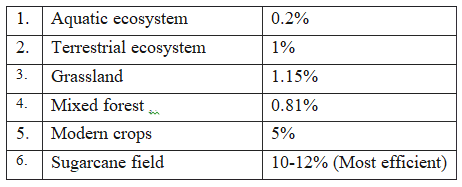
Types of productivity :
(i) Primary Productivity : The rate at which radiant energy is stored by photoautotrophs and chemoautotrophs.
a. Gross Primary Productivity (GPP) : It is the rate of organic matter synthesized by producers per unit area per unit time.
b. Net Primary Productivity. It is the rate of organic matter built up or stored by producers in their bodies per unit time and area. Net productivity is equal to gross primary productivity minus loss due to respiration and other reasons. NPP is the available biomass for the consumption to heterotrophs i.e. herbivores and decomposers.
Net primary productivity = Gross primary productivity – Respiratory loss.
Primary productivity depends on the plant species inhabiting a particular area, availability of nutrients and photosynthetic capacity of plants. This is available to herbivore level.
The annual NPP of whole biosphere is approximately 170 billion tons (dry wt.) of organic matter, despite occupying about 70% of the surface, the productivity of the oceans is only 55 billion tons.ln deep marine habitats, both light and nutrients become limiting. The most limiting nutrient of marine ecosystem is nitrogen.
(ii) Secondary productivity. Rate of increase in energy containing organic matter or biomass by heterotrophs or consumers per unit time and area is known as secondary productivity. It is available to carnivore level.
(iii) Community productivity. It is the rate of net synthesis of built up of organic matter by a community per unit time and area.
(iv) Ecological efficiency/Trophic level efficiency. The percentage of energy converted into biomass by a higher trophic level over the energy of food resources available at the lower trophic level is called ecological efficiency.

decomposition
- Books Name
- A TEXT OF BIOLOGY - CLASS XII
- Publication
- ACME SMART PUBLICATION
- Course
- CBSE Class 12
- Subject
- Biology
Decomposition
It is the process of physical and chemical breakdown of complex organic remains by organisms called decomposers, so as to produce inorganic raw materials (CO2, H2O, minerals, etc.) for recycling.
The major site for decomposition is the upper layer of soil in terrestrial habitats and bottom of water bodies.
Freshly deposited organic matter constitutes raw material and is called litter.
Detritus is degrading dead organic matter and is differentiated into above ground and below ground detritus.
Above ground detritus consists of dried plant parts (leaves, twigs, bark, flowers), excreta and dead remains of animals.
Below ground detritus is also called root detritus, because it is mainly composed of dead roots.
Underground organisms and their excreta also form a part of below ground detritus.
Decomposition Processes
Three types of processes occur simultaneously during decomposition of detritus, viz. fragmentation, leaching and catabolism.
1. Fragmentation of Detritus: Small invertebrate animals called detrivores feed on detritus, e.g., Earthworms, termites. They bring about its fragmentation. A part of detritus eaten by detrivores comes out in highly pulverised state in their faeces. Due to fragmentation during eating and pulverisation in digestive tracts, detritus is changed into fine particles which have a large surface area.
2. Leaching: Part of soluble substances present in the fragmented and decomposing detritus (e.g., sugars, inorganic nutrients) get leached to upper layers of soil by percolating water.
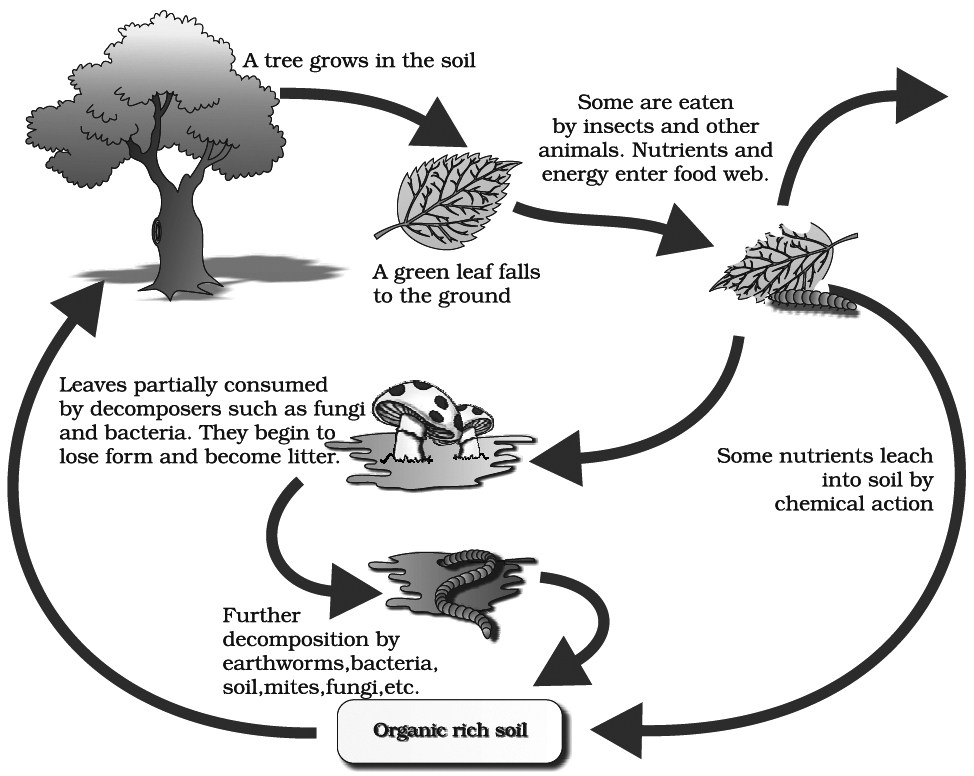
3. Catabolism: It is carried out by saprotrophic bacteria and fungi. They secrete digestive enzymes over the fragmented detritus. The enzymes change complex organic compounds into simple compounds. Inorganic substances are also released in the process.
The rate of catabolic action or breakdown of different complex substances is different.
This differential decomposition produces two substances, humus and inorganic nutrients in processes respectively called humification and mineralisation, which occurs in soil.
(i) Humification. It is the process of partial decomposition of detritus to form humus. Humus is a dark coloured, amorphous, partiaily decomposed organic matter rich in cellulose, lignin, tannins, resin, etc. and is highly resistant against microbial action. It undergoes decomposition at an extremely slow rate. Humus is slightly acidic, colloidal and functions as reservoir of nutrients.
(ii) Mineralisation. It is the release of inorganic substances (e.g., CO2, H2O, minerals) from organic matter during the process of decomposition. They are formed alongwith simple and soluble organic substances when digestive enzymes are poured over organic matter by saprotrophic microbes.
Factors Affecting Decomposition
The rate of decomposition of detritus is controlled by a number of factors.
(i) Chemical Nature of Detritus. Decomposition of detritus is slow if it contains lignin, chitin, tannins (phenolics) and cellulose. It is rapid if detritus possesses more of nitrogenous compounds (like proteins, nucleic acids) and water soluble reserve carbohydrates.
(ii) Soil pH. Detrivores are fewer in acidic soils. Microbial activity is also low in such soils. Therefore, rate of decomposition of organic matter is slow in acidic soils. Partially decomposed organic matter piles up over such soils. Detrivores are abundant in neutral and slightly alkaline soils, while decomposer microbes are rich in neutral and slightly acidic soils.
(iii) Temperature. At a temperature of more than 25°C, decomposers are very active in soils having good moisture and aeration. In humid tropical regions, it does not take more than 3 – 4 months for complete decomposition of detritus. However under low temperature conditions (>10°C) of soils, the rate of decomposition is very slow even if moisture and aeration are optimum.
(iv) Moisture. An optimum moisture helps in quicker decomposition of detritus. Reduction in moisture reduces the rate of decomposition as in areas of prolonged dryness like tropical deserts where, otherwise, the temperature is quite high. Excessive moisture also impedes decomposition. Temperature and soil moisture are the most important climatic factors that regulate decomposition through their effects on the activities of soil microbes.
(v) Aeration. It is required for activity of decomposers and detrivores. A reduced aeration will slow down the process of decomposition.
energy flow
- Books Name
- A TEXT OF BIOLOGY - CLASS XII
- Publication
- ACME SMART PUBLICATION
- Course
- CBSE Class 12
- Subject
- Biology
Energy Flow
Flow of incident energy is shown below
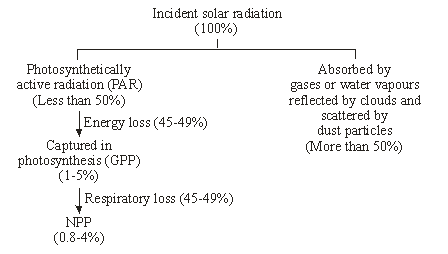
 It means plant capture only 2-10% of the PAR and this small amount of energy sustains the entire living world. All organisms depends upon plants (directly or indirectly) for energy.
It means plant capture only 2-10% of the PAR and this small amount of energy sustains the entire living world. All organisms depends upon plants (directly or indirectly) for energy.
Food Chain
It is a sequence of living organisms due to interdependence in which one organism consumes another.
Trophic Level :
Organisms occupy a place in the natural surroundings or in a community, according to their feeding relationship with other organism.
Every position is called trophic level.
It is based on the source of their nutrition.
The ultimate source of energy used by all living organisms is the sunlight which is entrapped by green plants, and utilized for the synthesis of complex organic substances (carbohydrates) during photosynthesis.
The energy trapped in organic substances by autotrophs is passed on to different living organisms through food.
Exchange of both energy and materials thus occurs through food.
The sequence of populations or organisms or trophic levels in an ecosystem through which food and its contained energy flows constitutes a food chain.
The number of trophic levels in a food chain is equal to the number of steps involving the transfer of food from one organism to the other.
Decomposers are not included in food chain as they operate at all trophic levels.
1. Producers: They are autotrophs, synthesizing complex organic substances from simple inorganic substances like CO2 and H2O during photosynthesis. The sunlight provides the energy for the process, the solar energy is converted into chemical energy and is stored in different complex organic substances like carbohydrates, proteins, lipids, etc.
2. Consumers: They are heterotrophic organisms incapable of synthesizing their own food. They depend upon plants (producers) for their food requirement directly or indirectly. The consumers are of different types:
(i) Primary consumers: They are herbivores which feed upon plants or plant products, e.g., rabbit, deer, field mouse, cow, elephant, small fish, tadpoles, several insects, zooplanktons like Paramecium, Daphnia, etc. These are called Key industry animals as they convert plant matter into animal matter.
(ii) Secondary consumers : They do not feed upon plants directly; instead feed upon herbivores, so are primary carnivores e.g., fox, jackal, frog, fish, several birds, etc.
(iii) Tertiary consumers: They are larger camivores which feed upon smaller carnivores e.g., wolf feeding upon fox, snake feeding on frog. These carnivores may also become prey to still larger carnivores. The latter are termed top carnivores e.g., tiger, lion, shark, crocodile, eagle, etc. A food chain may vary in length but usually consists of 4 or 5 steps or trophic levels. A few common food chains are given below :
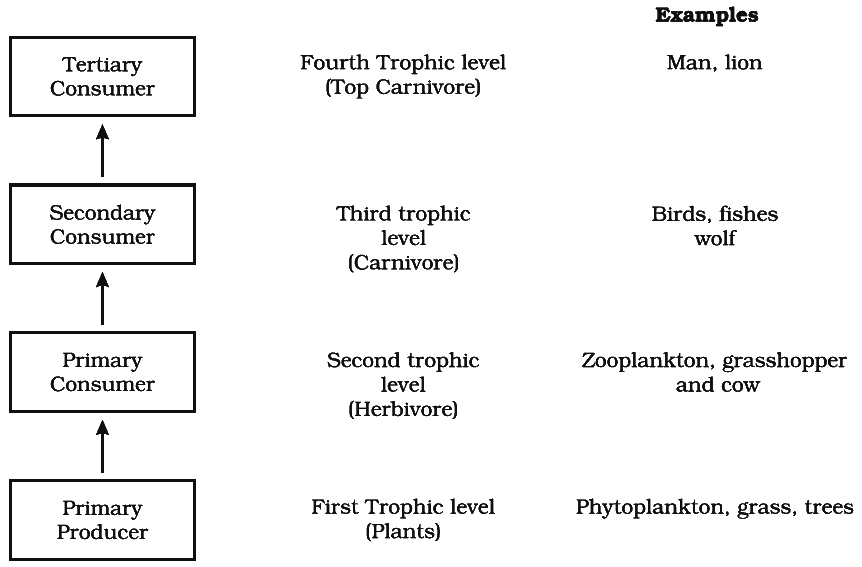
Types of Food Chain
(i) Grazing Food Chain (GFC)/predator food chain
(a) Major conduit for energy flow in aquatic ecosystems.
(b) Always begins with producers
(c) Sun is the only source of energy
(d) Size of organisms commonly increase at higher trophic levels
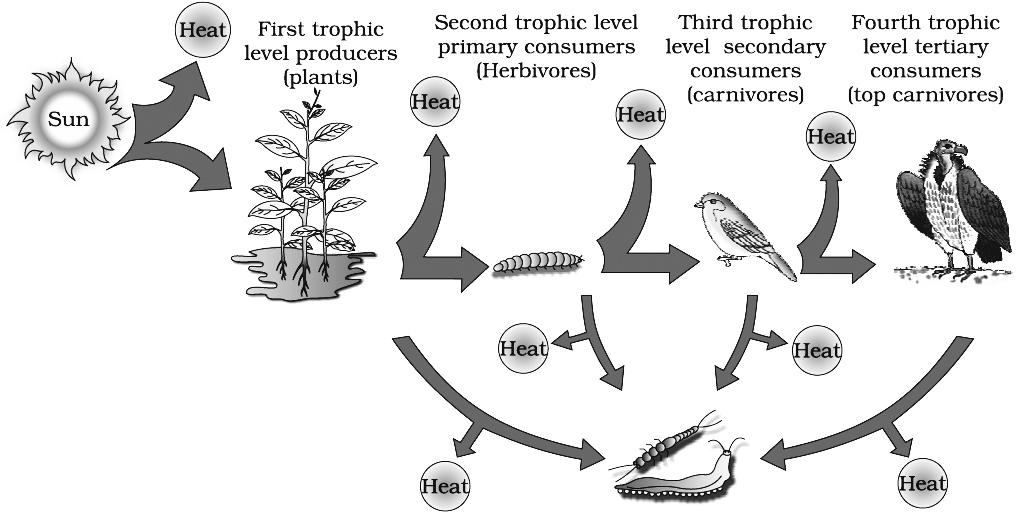
(ii) Detritus Food Chain (DFC)
Death of an organism is the begining of DFC.
(a) In terrestrial ecosystems, a much larger fraction of energy flows through the DFC than through the GFC.
(b) Source of energy is detritus not sun.
(c) Composed of a long chain of detritus eating organisms (detritivores)
(d) In some ecosystems (e.g., Tropical rain forest) more energy flows in this chain than grazing food chain.
(e) DFC may be connected with the GFC at some levels, as some of the organisms of DFC are prey to certain GFC animals and in a natural ecosystem, some organisms like cockroaches, crows etc. are omnivores.
(iii) Parasitic food chain/Auxiliary food chain
Size of the organisms finally reduces at higher trophic level (parasite).
e.g., Tree herbivore birds lices and bugs.
Terrestrial food chains
1. Grass Rabbit Cat Wolf Tiger
2. Grass Grasshopper Frog Snake Peacock Falcon.
3. Vegetation Insect Predator bird Hawk.
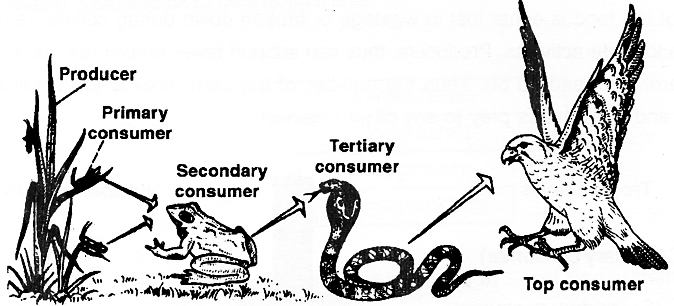
3. Secondary consumer-Frog 4. Tertiary consumer-Snake 5. Quaternary top consumer-Eagle.
Aquatic food chains
1. Phytoplanktons Zooplanktons Crustaceans Predator insects Small fish Large fish.
2. Phytoplanktons Zooplanktons Crustaceans Predator insects Kingfisher Stork.
Food web
In ecosystem, linear food chains as shown above seldom exist, because every organism has alternate source of food.
An animal may have preference for a particular prey, but if the latter has a small population, it may feed upon some other prey.
Single animal may be eaten by different animals and thus different food chains get interconnected and one animal may be a link in more than one food chain.
The network of interconnected food chains at different trophic levels in a biotic community is termed food web.
Occurence of food webs provides stability to ecosystem.
Food webs operate because of taste preference for particular food and unavailability of food.
One animal may feed upon organism of ever different trophic level like -Snakes may feed upon mice (herbivore) and frogs (carnivore), jackals are both carnivores and scavengers.
Only 10% of the gross productivity of producers is entrapped by herbivores for their body building.
Similarly 10% of the herbivore productivity is available for raising productivity of primary carnivores.
Higher carnivores are also able to retain only 10% of energy present in primary carnivores.
It is called 10% law (Lindemann, 1942).
It is due to this fact, the number of trophic levels in the GFC is restricted as the energy transfer follows this law.
Respiratory loss gradually increases in successive trophic levels. It is 20%, 30% and 60% respectively at producer, consumer and top carnivore level.
Standing State or Standing Quality: Amount of all the inorganic substances present in an ecosystem per unit area at a given time.
Standing Crop: Amount of living material present in different trophic levels at a given time. It is commonly expressed as the number of organisms per unit area.
ecological pyramids
- Books Name
- A TEXT OF BIOLOGY - CLASS XII
- Publication
- ACME SMART PUBLICATION
- Course
- CBSE Class 12
- Subject
- Biology
ECOLOGICAL PYRAMIDS
An ecological pyramid is the graphic representation of, trophic levels of a food chain.
Ecological pyramids were developed by Charles Elton (1927) and are, therefore, also called Eltonian pyramids.
Three types of ecological pyramids are recognized, viz., (i) pyramid of number, (ii) pyramid of biomass, and (iii) pyramid of energy, giving graphic representation to three important parameters at different trophic levels in food chain respectively, number of individuals, amount of biomass and amount of energy.
(i) Pyramid of number:
In most ecosystems, the number of producers is maximum.
During transfer of food at any trophic level, only 10% of the food present in one trophic level becomes part of the next trophic level.
90% of the food is either lost in wastage or broken down during cellular respiration for providing energy for various life activities.
Producers, thus can support fewer herbivores and herbivores can support still fewer carnivores and so on.
Thus the number of top carnivores is too small to support any other trophic level and don't act as prey to any other organism.
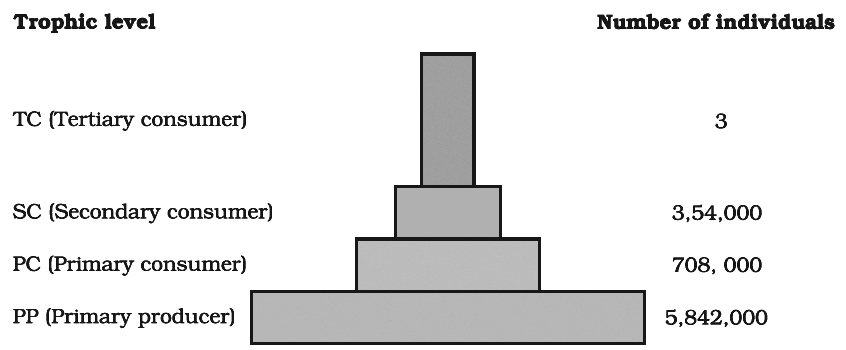
(For example, only three top-carnivores are supported in an
ecosystem based on production of nearly 6 millions plants)
Pyramid of numbers, though upright in most cases, like a pond or a grassland but may not be so always.
In some cases it may be inverted, i.e., the number of the organisms at each successive trophic level is higher than that in preceeding one and the size decreases gradually at each successive level; e.g., a large-sized tree (producer) may support and provide nourishment to several birds (herbivores).
The number of ectoparasites like mites, ticks, lices, -bugs etc., dependent upon birds for nourishment is much larger than birds.
The number thus increases at each successive level.
The pyramid of number may become spindle-shaped for a tree as herbivorous birds are usually eaten by eagle or falcon.
The number of eagles is much less than that of birds feeding upon tree.
The number of organisms thus increases at lower trophic levels and finally decreases at higher trophic levels.
(ii) Pyramid of biomass :
Biomass is the amount of living matter (expressed as weight) at any particular trophic level at a given time.
Pyramid of biomass in terrestrial ecosystems is usually upright.
For upright pyramid, total biomass of plants (producers) in a specific area is more than that of herbivores (primary consumers) and it gradually decreases at each successive trophic level.
It is least in top carnivores. It is upright for tree and grassland ecosystems.
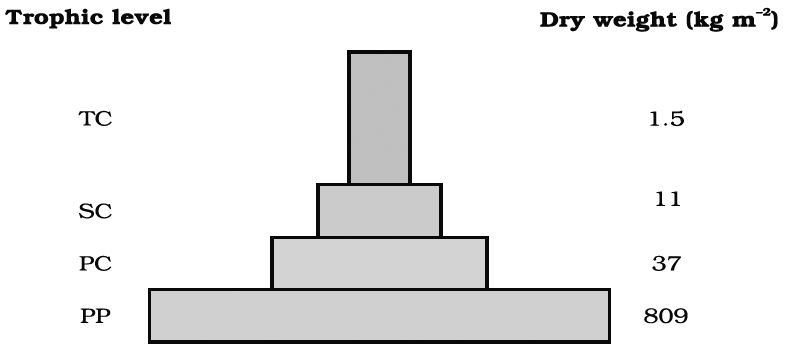
In aquatic ecosystem, the pyramid of biomass may be inverted, e.g., biomass of zooplanktons is higher than that of phytoplanktons as life span of former is longer and the latter multiply much faster though having shorter life span.
A number of generations of phytoplanktons may thus be consumed by single generation of zooplanktons.
Biomass of fish may still be larger as fish are larger in size with longer life span and a number of generations of zooplanktons can be consumed by fishes.
However during transfer, only 10% of the biomass of one generation is passed on to next trophic level.
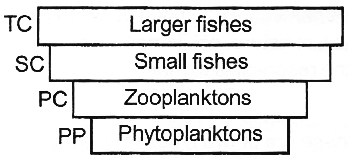
(iii) Pyramid of energy:
The pyramid ofenergy is always upright because the flow of energy is unidirectional from producer to consumer level.
The energy content is maximum in producers.
The energy decreases at each trophic level of food chain, as part of the energy is lost as heat and major part of energy is liberated during respiration for use in various activities.
Only 10% of the energy of previous trophic level is received by next trophic level, as proposed by 10 per cent law of Lindeman (1942).
Just to illustrate 1,000 calories of solar energy is needed to produce 10 calories of energy stored in a plant (if plants trap 1 % solar energy).
Herbivores, feeding upon plant, will retain 1 cal of available stored energy and carnivores feeding upon them will gain only 0.1 cal of usable energy.
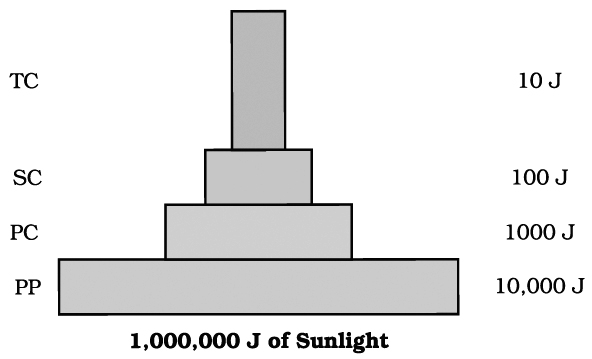
only 1 % of the energy in the sunlight available to them into NPP
Limitations of ecological pyramid
(i) It does not take into account the same species belonging to 2 or more trophic levels, e.g., insectivorous plants.
(ii) It assumes a simple food chain and does not accommodate a food web.
(iii) Saprophytes, decomposers, microbes and detrivores are not given any place in ecological pyramids.
Ecological succession
- Books Name
- A TEXT OF BIOLOGY - CLASS XII
- Publication
- ACME SMART PUBLICATION
- Course
- CBSE Class 12
- Subject
- Biology
ECOLOGICAL SUCCESSION (BY HULT)
Biotic community is seldom static.
Its composition changes with time due to interactions between biotic and abiotic components.
This change is orderly and sequential, parallel with the changes in the physical environment.
These changes lead finally to a community that is in near equilibrium with the environment and is called climax community.
Such gradual and fairly predictable changes in the species composition of a given area are collectively called ecological succession.
During succession, some species colonise an area and their populations become more numerous, whereas populations of other species decline and even disappear.
The first biotic community that develops in a bare area is termed as pioneer community, e.g., lichens on bare rock.
The pioneer community is followed by a specific orderly sequence of series of plant communities called transitional communities or seral communities.
The entire series of communities is known as sere.
The last community in biotic succession which is relatively stable and in harmony with environment of that area is termed' as climax community.
It is also called as climatic climax.
All successional processes leads to a similar mesic climax.
Succession is hence a process that starts where no living organisms are there.
Types of Biotic Succession
(A) Depending upon the nature of habitat of its start, it is of two types, i.e., xerosere, starting on terrestrial habitat and hydrosere, starting on aquatic habitat. Xerosere is further of different types, i.e., lithoserestarting on barren rock and psammosere-starting on sand, halosere-in salt marshes (i.e., in a physiologically dry soil).
(B) Depending upon the type of nudity of the area, it is of two types:
(i) Primary succession. It starts at barren area, never having vegetation of any type. Cooled volcanic lava, sand dunes, igneous rocks, newly exposed sea or newly submerged terrestrial habitats in water, etc., are the areas where primary succession starts. It is very difficult for the pioneer community to get established in these areas and thus it takes a very long time.
(ii) Secondary succession. It starts at the habitats which become barren secondarily by the destruction of earlier vegetation under the influence of natural calamaties like forest fire, volcanic eruptions, earthquakes, landslides, floods, etc., or due to overgrazing and leaving the crop fields uncultivated for a long period. Such habitats are fertile, rich in organic matter and even occupied by certain organisms. Secondary succession, thus, starts quickly and climax community is established in a short span.
(C) Autogenic and Allogenic Succession : When a community replaces the other due to the modification of the environment by the community itself (internal factors) the succession is called autogenic. On the contrary, when a community replaces the other, largely due to the forces other than the effects of communities on the environment, the succession is said to be allogenic.
(D) Autotrophic and Heterotrophic Succession : Autotrophic succession is characterised by early dominance of autotrophic organisms and begins in predominantly inorganic environment. On the contrary, heterotrophic succession is characterised by early dominance of heterotrophs and begins in a predominantly organic environment.
Process of Succession
Major steps in a primary autotrophic succession are as follows :
1. Nudation: Exposure of an area.
2. Migration: The process of dispersal of seeds, spores and other structure of propagation of the species to bare area is known as migration.
3. Germination: It occurs when conditions are favourable.
4. Ecesis: Successful germination of propagules and its establishment in a bare area is known as ecesis.
5. Colonisation and Aggregation: After ecesis, the individuals of the species increase in number as the result of reproduction.
6. Competition and Co-action : Due to limited resources, species show both inter and intraspecific competition. This results into elimination of unsuitable and weaker plants.
7. Invasion: Various other types of plants try to establish in the spaces left by the elimination of previous plants due to competition.
8. Reaction: The newly arrived plants interrupt with the existing ones. As the result of reaction, environment is modified and becomes unsuitable for the existing community which sooner or later is replaced by another community.
9. Stabilisation: The process when the final climax community becomes more or less stabilised for a longer period of time and it can maintain itself in equilibrium with the climate of the area. As compared to transitional communities, the climax community has larger size of individuals, complex organization, complex food chains and food webs, more efficient energy use and more nutrient conservation.
Succession on bare rock
Succession starting on bare rock is termed lithosere. The various seral stage in lithosere are as follows.
1. Lichen stage.
The pioneer lichens on such habitats are usually crustose lichens, e.g., Graphis, Rhizocarpon.
The propagules of these lichens settle and get established on wet rock surface soon after rainfall.
They can tolerate desiccation and high temperature.
The acidic substance produced by lichens corrodes the rock surface forming small depressions and release minerals needed for the growth of lichens.
The dead and decaying organic matter of the lichens along with sand particles, brought by wind, to get collected in depressions and forms a little bit of soil by mixing with weathered rock particles.
The habitat becomes suitable for foliose lichens like Parmelia.
Foliose lichens compete with crustose lichens and slowly replace the latter due to their larger size.
They increase shading of rocks, more accumulation of organic matter and formation of larger depressions.
This accelerates the process of soil formation and makes the habitat more suitable for next seral stage, the moss stage.
2. Moss stage.
Due to interaction of foliose lichens, the habitat becomes suitable for hardy mosses (e.g., Tortula, Grimmia) to grow.
Mosses, being larger in size and having gregarious habit, shade the lichens and replace them.
Their rhizoids can penetrate deeper.
Growth of mosses leads to accumulation of more soil and organic matter which can retain moisture for a longer span and soon the habitat is occupied by moisture loving mosses (e.g., Hypnum, Bryum).
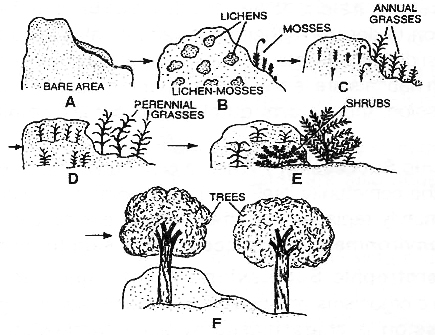
2. Annual grass stage.
During rainy season, the compact mat formed by mosses on weathered rock retain sufficient moisture and the habitat thus becomes suitable for germination of seeds of annual grasses and hardy herbs, e.g., Aristida, Poa, Eleusine, etc.
Their roots penetrate deeper and cause more weathering of rocks.
They replace mosses, grow for a couple of months and their death and decay results in increased organic matter.
This mixes with weathered rock particles to form soil and thus process of soil formation continues.
3. Perennial grass stage.
Due to increasing moisture and soil in rock crevices, annual grasses are replaced by perennial grasses.
These grasses like Heteropogon, Cymbopogon, etc., spread very fast due to the presence of runners and rhizomes.
4. Shrub stage.
The habitat occupied by perennial grasses soon become suitable for invasion of xerophytic shrubs like Zizyphus, Rubus, Rhus, Capparis,etc.
These shrubs soon get established in such habitats, replacing the perennial grasses.
As shrubs are larger in size, their roots penetrate deeper, causing more fragmentation of rock and hence more accumulation of soil.
5. Climax stage.
Shrubs are soon replaced by hardy trees.
Soon the atmosphere becomes more moist due to large amount of water transpired by large sized plants and ultimately the community, which is relatively more stable, occupies the habitat.
This is termed climax community.
The nature of climax community is determined by the climate of that area.
Succession in aquatic habitat
The succession starting in aquatic habitat like freshly formed pond is termed hydrosere.
The various seral stages are as follows:
1. Plankton stage.
The pioneers of hydrosere are the phytoplanktons, the minute microscopic autotrophic organisms like diatoms, unicellular, colonial or filamentous green algae and blue green algae (cyanobacteria).
The spores of these organisms reach the newiy formed pond through wind or animals.
They multiply rapidly.
The pond water containing large number of phytoplanktons becomes suitable habitat for zooplanktons which feed upon phytoplanktons, thus maintaining the balance.
The organic matter formed by death and decay of planktons, particulary zooplanktons mixes with clay and silt at the bottom of pond to form soft mud.
The habitat becomes suitable for the growth of next stage.
2. Submerged stage.
With the formation of soft mud at the bottom of pond, the habitat becomes suitable for the growth of anchored and submerged plants like Hydrilla, Najas, Potamogeton, etc.
They are anchored in mud and form dense growth.
More silt gets deposited around plants.
The accumulated silt along with decomposition of organic matter formed by decay of submerged plants makes the substrate fertile and raises the bottom level.
3. Floating stage.
In the pond, where the water becomes shallow, anchored plants with leaves floating (e.g., Nelumbo, Nuphar, Nymphaea), start growing and replace the plants of submerged stage which migrate to deeper waters in a pond.
These plants have subterranean stems like rhizomes and corms.
With the growth of these plants, water becomes richer in minerals and organic matter and the habitat becomes suitable for free floating plants like Lemna,Azolla, Spirodela, Wolffia, Eichhornia, etc.
The bottom level is further raised due to growth of free floating plants and accumulation of dead and decaying remains of these plants.
Water becomes much shallower at the periphery of pond.
It becomes almost a marshy habitat.
4. Reed swamp stage.
The periphery of the pond, where the water is very shallow due to interaction of free floating stage, becomes suitable for the growth of amphibious plants like Typha, Sagittaria, Phragmites, Scirpus etc.
These plants lose large quantity of water during transpiration and produce large amount of organic matter.
5. Sedge or marsh meadow stage.
The peripheral area of pond built up by plants of reed swamp stage is invaded by Cyperus, Carex (Sedge), Juncus and grasses like Themeda and Dichanthium and herbs like Campanula, Caltha, Polygonum, etc.
6. Scrub/Woodland stage.
The peripheral area of the pond occupied by marsh meadow stage is invaded by shrubs which can grow in water-logged soil and tolerate bright sunlight e.g., Cornus (Dogwood), Cephalanthus (button brush).
This further invite invasion of trees capable of bearing bright sunlight and water logging e.g., Populus (cottonwood), Alnus (Alder).
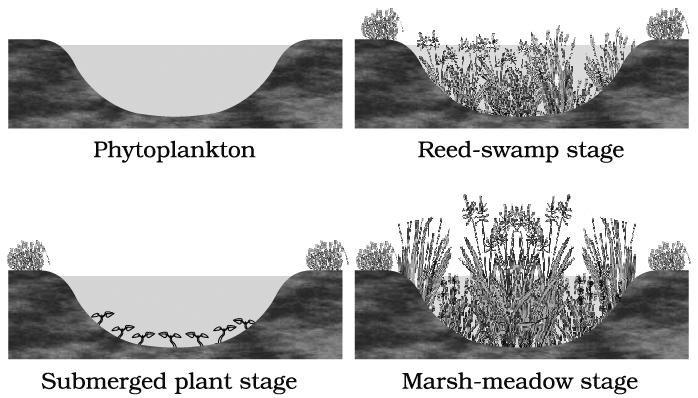
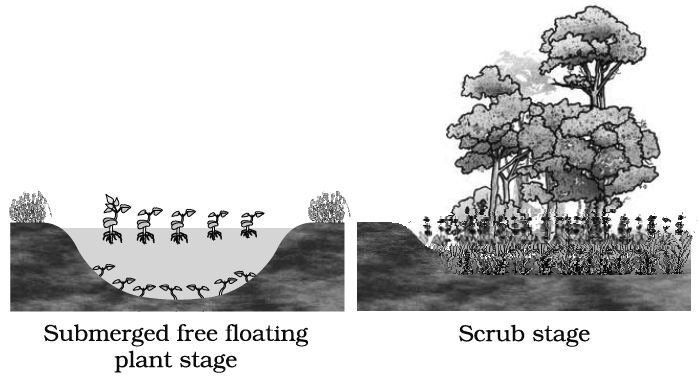
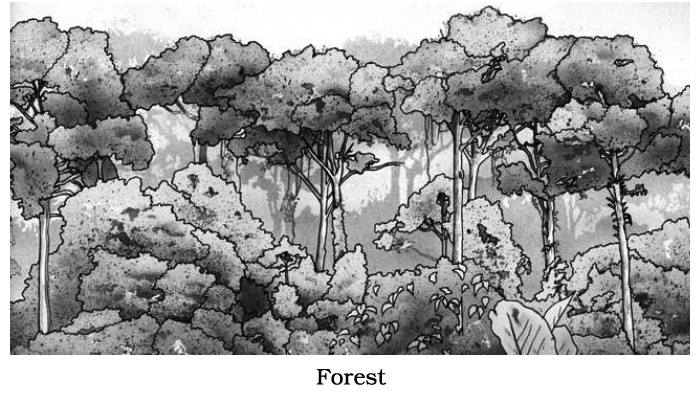
7. Climax Forest.
The woodland stage trees are replaced by new trees which grow to greater heights.
The nature of climax community is determined by climate, e.g., rain forest in moist tropical area and mixed coniferous or deciduous forest in temperate area.
Mixed tropical forest include trees like Quercus (oak), Ulmus (elm), Acer (maple) and gymnosperms like Abies (fir), Taxus (yew) and Picea (spruce).
Major trends during ecological succession
The major structural and functional attributes of ecological succession are:
(i) Increase in species diversity.
(ii) Increase in structural complexity.
(iii) Increase in organic matter.
(iv) Decrease in net community production.
(v) Food chain relationship becomes complex.
(vi) Niche become specific and narrower.
(vii) Stability increases.
(viii) More immobilization of nutrients (mineral nutrients fixed in biota).
(ix) Increased energy efficiency
Nutrient cycle
- Books Name
- A TEXT OF BIOLOGY - CLASS XII
- Publication
- ACME SMART PUBLICATION
- Course
- CBSE Class 12
- Subject
- Biology
Nutrient Cycling
The essential elements or inorganic substances are provided by earth and are required by organisms for their body building and metabolism, so they are called biogenetic nutrients or bio-geochemicals.
All the three subdivisions of the earth contribute these elements as such or in the form of compounds.
However, as the earth is a closed system for matter, the supply of biogenetic nutrients is finite or limited.
It is estimated that amount of living matter (made up of biogenetic nutrients) contained in all the past and present organisms is several times more than the total mass of earth.
This is possible only if biogenetic nutrients do not remain locked up in the body of organisms but are released, during excretion and after death, back into the nonliving world so that they can be used again and again.
Circulation or exchange of biogenetic nutrients between the living and the nonliving components is called cycling of matter or biogeochemical cycling (at global scale).
However, the whole of biogenetic nutrients are not always in circulation.
The nutrients occur in two states-reservoir pool and cycling pool.
(i) Reservoir pool is the reservoir of biogenetic nutrients from which they are very slowly transferred to the cycling pool, e.g., metal phosphates, nitrogen gas of the atmosphere.
(ii) Cycling Pool is the pool of biogenetic nutrients which are repeatedly exchanged between the biotic and abiotic components of the biosphere.
Environmental factors, e.g., soil, moisture, pH, temperature etc. regulate the rate of release of nutrients into the atmosphere.
The function of the reservoir is to meet with the deficit which occurs due to imbalance in the rate of influx and efflux.
Bio-geochemical cycles: These are of two types (1) Gaseous cycle (2) Sedimentary cycle
1. In gaseous cycles, materials involved in circulation are gases. Four most abundant elements present in living organisms, i.e., C(CO2), H (water vapours), O and N have predominantly gaseous cycles. The main reservoir pool for gaseous cycles is atmosphere or hydrosphere (water). Gaseous cycles are quick and are relatively perfect systems as the elements remain in circulation more or less uniformly.
2. In sedimentary cycles, biogenetic materials involved in circulation are non-gaseous. The reservoir pool for these cycles is lithosphere, e.g., phosphorus, calcium, sulphur. Recycling of sulphur involves both gaseous and sedimentary phase (mixed type). Sedimentary cycles are very slow and are less perfect systems as the elements may get locked and go out of circulation for longer duration .
Different biogeochemical cycles are discussed below:
1. The Carbon Cycle:
Carbon is constituent of almost all organic compounds of the cell such as carbohydrates, proteins, lipids, enzymes, nucleic acids, hormones, etc., and thus may be considered basis of life.
Carbon constitutes 49% of dry weight of organisms and is next only to water.
Infact, 71 % of total global carbon is found dissolved in oceans.
This oceanic reservoir regulates the amount of CO2 in atmosphere.
According to an estimate 4 × 1013 kg of carbon is fixed in the biosphere through photosynthesis annually.
Carbon in the atmosphere is present as CO2, in hydrosphere as dissolved CO2 or carbonic acid or bicarbonates and in lithosphere as fossil fuels or carbonates and graphite in rocks.
Carbon present in lithosphere is not readily available, as it becomes available to the living world only when it is either burnt or changed chemically.
There is however, regular exchange of carbon between atmosphere and hydrosphere and is readily available to the living world in the form of free or dissolved carbon dioxide.
Carbon passes into living components mainly during photosynthesis in the form of CO2 by autotrophs, but atmosphere and hydrosphere do not get depleted of their carbon content because of its return through two major processes: (i) Biological-respiration by living organisms and decomposition of organic matter. (ii) Non-biological-combustion of carbon containing fuel that releases CO2 in the atmosphere.
Human activities have significantly influenced the carbon cycle.
Rapid deforestation and massive burning of fossil fuel for energy and transport have significantly increased the rate of release of CO2 into the atmosphere.
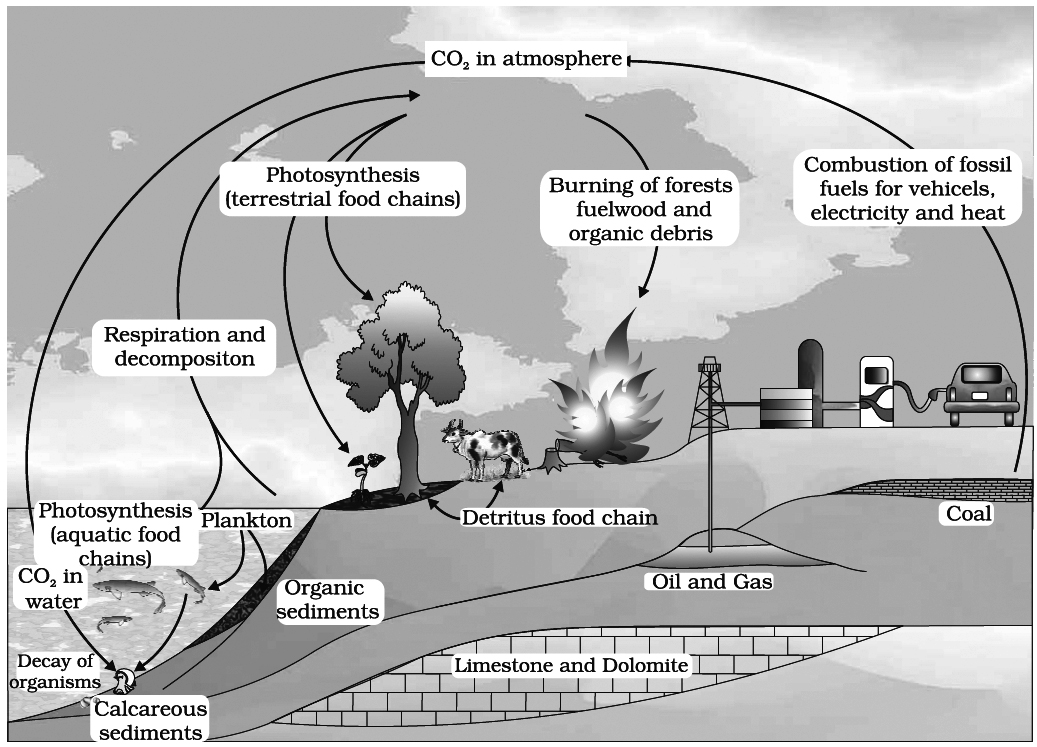
2. The Oxygen Cycle :
Oxygen is constituent of important biomolecules in the cell and is also required for respiration in aerobes.
It is present in natural gaseous form (molecular O2) in atmosphere and constitutes about 21% of the air. In combined form it is component of CO2, water and number of oxidised salts.
Terrestrial organisms take oxygen directly from the air and aquatic organisms take oxygen either from water present in it, in diffused or dissolved state or directly from the atmosphere to be used in respiration.
It is returned to the atmosphere in the form of CO2 and H2O.
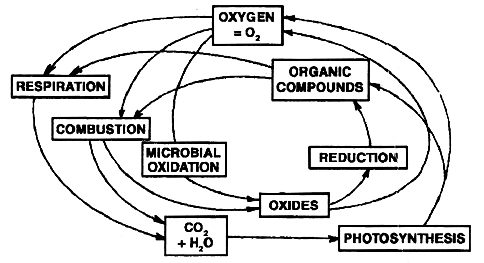
Carbon dioxide and water produced during respiration are used by plants during photosynthesis and molecular oxygen is released into the atmosphere for reuse in respiration.
The oxygen in the atmosphere thus remains in state of natural dynamic equilibrium.
Oxygen is also added to the atmosphere in terms of carbon dioxide, water, sulphur dioxide, nitrogen oxides, etc., during burning or combustion of wood, coal, petroleum, natural gases.
Oxides are also produced during microbial oxidation. Chemical or biological oxidation of oxides releases molecular oxygen.
3. The Nitrogen Cycle :
Nitrogen is component of amino acids, proteins, enzymes, nucleic acids and nucleotides, which are essential structural and functional components of living organisms.
Main source of nitrogen is air, as about 3/5 of the total air is molecular nitrogen (N2).
Sufficient required amount of nitrites and nitrates are made available to the plants through a number of processes involving microorganisms either from air or from organic nitrogen locked up in dead remains of living organisms.
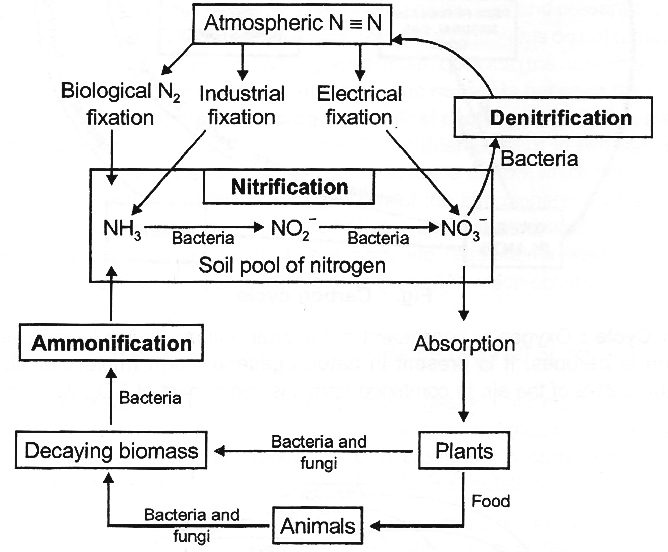
(a) Nitrogen fixation. The conversion of molecular nitrogen into nitrogenous compounds like ammonium salts or oxides of nitrogen is termed nitrogen fixation, which is of three types:
(i) Biological nitrogen fixation
(ii) Atmospheric nitrogen fixation
(iii) Industrial nitrogen fixation
(b) Decay and decomposition of dead remains of living organisms and of their excretory products.
Plants mainly absorb nitrogen in the form of nitrate ions which are reduced to NH3 in plant cells.
NH3 is used up in synthesis of amino acids.
Animals synthesize proteins and other nitrogenous compounds from amino acids obtained through digestion of plant proteins.
During protein metabolism, a number of nitrogenous waste products like ammonia, urea and uric acid are produced which are excreted and nitrogen present in them is recycled.
A bulk of organic nitrogen remains locked up in plants and animals.
The nitrogen present in dead remains of plants and animals in the form of organic compounds is converted into amino acids by a number of saprophytic micro-organisms.
Anaerobic breakdown of proteins is termed putrefaction.
Amino acids are converted into ammonium salts by ammonifying bacteria (Bacillus sp.) and some fungi.
Some ammonium salts are directly absorbed by plants.
However, most of these are converted into nitrites by nitrifying bacteria as plants prefer absorption of these in comparison to ammonium salts.
Ammonium salts are converted into nitrites by Nitrosomonas and Nitrococcus and nitrites are converted into nitrates by Nitrobacter, Nitrocystis and Penicillium species.
Some nitrates and nitrites in the soil are lost through leaching and precipitation and become constituent of rocks, going out of cycle.
This nitrogen is slowly released for recycling in nature after an interval of millions of years during weathering of these rocks only when these get exposed.
Some nitrogen present in nitrates is released to the atmosphere as molecular nitrogen by certain denitrifying bacteria (e.g., Thiobacillus denitrificans, Pseudomonas aeruginosa) in water logged soils or other areas having anaerobic environment.
These utilize O2 of the nitrates for their requirement and thus N2 is released in molecular form and escapes in the atmosphere in gaseous state.
4. The Water Cycle:
Water is the only substance on the surface of earth that exists in all the three states of matter.
Water is essential for photosynthesis and above all O2 of the atmosphere is derived from photolysis of water during photosynthesis, which is absolutely essential for the existence of animal life.
Water or hydrological cycle is made up of two overlapping cycles-the larger global cycle, not involving living organisms and the smaller local or biological water cycle, involving exchange between environment and living organisms.
(i) Global water cycle. Water is continuously lost from oceans, lakes, rivers and moist soil through evaporation. Clouds are formed by cooling and condensation of water vapours. The clouds move along the land over long distances, get cooled and precipitate as rain, snow or hail. Rain water may directly fall into ocean and may return to the atmosphere again through evaporation.
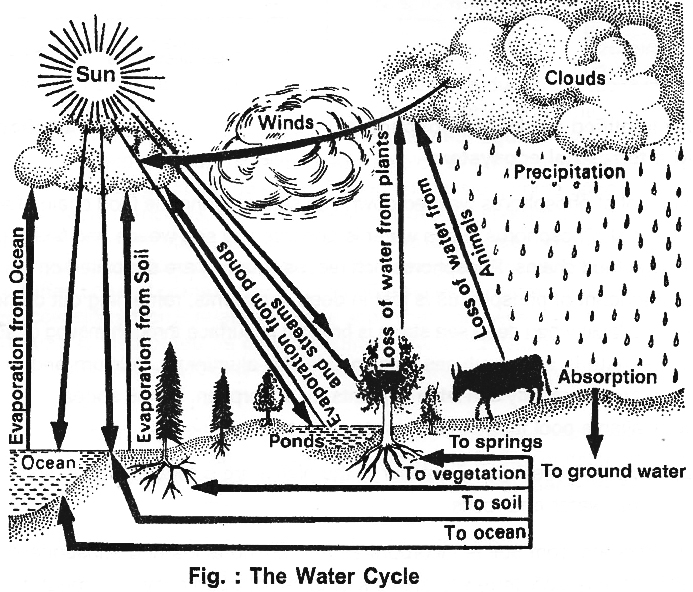
(ii) Local or biological cycle. It involves the entry of water into living organisms and its return to the atmosphere.
5. Phosphorus cycle:
Phosphorus has a natural reservoir in rocks as phosphates.
There is no respiratory release of phosphorus into atmosphere.
Atmospheric inputs of phosphorus through rainfall are much smaller than carbon inputs and gaseous exchange of phosphorus between organisms and environment are negligible.
Phosphorus present in insoluble form in soil is converted into soluble form by chemicals secretions of microorganisms and plant roots.
Dissolved phosphate is absorbed by plants and is used to built organic compounds like phospholipids, nucleotides, nucleic acids, etc.
Phosphorus moves from plants to animals of different trophic levels in ecosystem through food chains.
The phosphorus present in plants and animals (organic form) is returned to the soil (inorganic form) through decomposition of excreta of animals and dead remains of plants and animals by micro-organisms; to be reused by plants.
The phosphorus present in bones and teeth of animals is resistent to decay and thus remain out of the cycle for a long time.
Some amount of phosphorus washed down into sea, entering the food chain of aquatic ecosystem comes back to the soil.
Phosphorus in sea water is absorbed by sea weeds and finally passes into fish and seabirds through food chains.
Phosphorus rich faeces (guano) are deposited on land by sea-birds.
However, significant amount of phosphorus is lost in deep sediments, remaining out of the cycle for a long time.
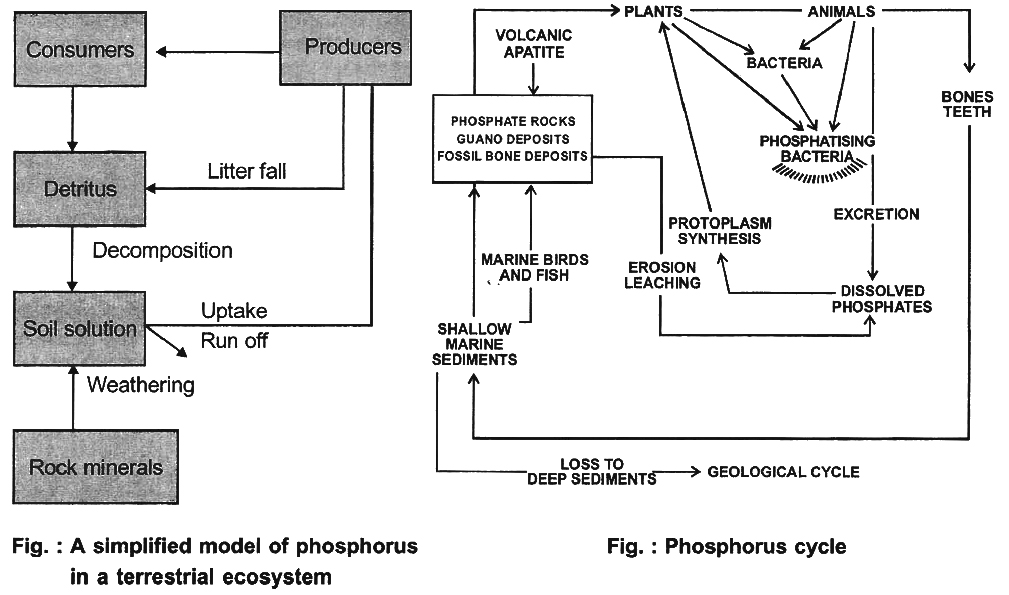
It becomes available when deep sea strata is brought to surface through mining or some natural disturbances.
Some phosphate in soil combines with metals like aluminium, calcium and iron to form their insoluble salts which are not readily available to plants for absorption.
It thus appears that phosphorus is being lost from the available pool faster than it is returned to it.
6. Sulphur cycle:
Main source of sulphur to the plants are sulphates and to some extent elemental sulphur present in soil, water and rocks.
Sulphur absorbed from soil is incorporated into amino acids and subsequently into proteins by plants.
Organic sulphur is transferred to animals of different trophic levels through food chains.
Some animals may get sulphur from water as well.
Organic sulphur present in dead remains of plants and animals and animal excreta is converted into sulphates during decomposition by bacteria and fungi under aerobic conditions which are added to the soil and water for reuse by plants.
SO2 is also released into atmosphere through combustion of fossil fuels.
It gets dissolved in water to form H2SO4 during rainfall which combines with certain metals in soil to form sulphates.
Some bacteria (e.g., Beggiatoa) and fungi convert H2S and element sulphur into sulphates which are recycled through plants in the biosphere.
Rocks may also be erroded by wind and the materials including sulphur are blown into air as dust.
These materials are transferred to soil during rain.
Sulphates are also added to the soil and air by volcanic erruptions.
Sulphates from the rocks are also brought to the soil by rain water running over them.
Some sulphates seep into the soil and others reach ponds and lakes or carried by rivers to sea.
In sea, it may get deposited in sedimentary rocks and move out of the cycle.
It may get back into cycle through food chains or geological disturbances.
Ecosystem services
- Books Name
- A TEXT OF BIOLOGY - CLASS XII
- Publication
- ACME SMART PUBLICATION
- Course
- CBSE Class 12
- Subject
- Biology
ECOSYSTEM SERVICES
The products of ecosystem processes e.g. healthy forest ecosystems purify air and water, mitigate droughts and floods, cycle nutrients, generate fertile soils, provide wildlife habitat, maintain biodiversity, pollinate crops, provide storage site for carbon and also provide aesthetic, cultural and spiritual values.
– Researchers like Robert Constanza et. al., have put an average price tag of US $ 33 trillion a year on these fundamental ecological services (i.e. nearly twice the value of a global GNP -US $ 18 trillion).
– Out of total cost, soil formation accounts for about 50%, recreation and nutrient cycling less than 10% each, climate regulation and habitat for wildlife are about 6% each.
Some Important Definitions
1. Ecosystem: Sum total of interactions between living and non-living components which is capable of independent existence.
2. Stratification: Vertical distribution of different species occupying different levels in the community.
3. Gross primary productivity: Rate of organic matter synthesized by producers per unit area per unit time.
4. Net primary productivity: Rate of organic matter built up or stored by producers in their bodies per unit time and area.
5. Secondary productivity: Rate of increase in energy containing organic matter or biomass by heterotrophs or consumers per unit time and area.
6. Community productivity: Rate of net synthesis of built up of organic matter by a community per unit time and area.
7. Ecological efficiency: Percentage of energy converted into biomass by a higher trophic level over the energy of food resources available at the lower trophic level.
8. Decomposition: Breakdown of complex organic matter into inorganic substances with the help of decomposers.
9. Humification: Process of formation of humus from detritus.
10. Mineralisation: Release of inorganic substances from organic matter during the process of decomposition.
11. Food chain: Sequence of living organisms due to interdependence in which one organism consumes another.
12. Standing state: Amount of all the inorganic substances present in an ecosystem per unit area at a given time.
13. Standing crop: Amount of living material present in different trophic levels at a given time.
14. Ecological pyramid: Graphic representation of trophic levels of a food chain.
15. Nutrient cycling: Movement of nutrient elements through the various components of an ecosystem.
16. Ecological succession: Gradual and fairly predictable changes in the species composition of a given area.
Biodiversity
- Books Name
- A TEXT OF BIOLOGY - CLASS XII
- Publication
- ACME SMART PUBLICATION
- Course
- CBSE Class 12
- Subject
- Biology
BIODIVERSITY
Immense diversity (heterogenity) occurs at all levels of biological organisation. Three most important of them are:
(i) Genetic Diversity :
Genetic diversity refers to the variation of genes within species.
The differences could be in alleles (different variants of same genes), in entire genes or in chromosomal structures.
The genetic diversity enables a population to adapt to its environment and to respond to natural selection.
If a species has more genetic diversity, it can adapt better to the changed environmental conditions.
Lower diversity in a species leads to uniformity, as in the case with large monocultures of genetically similar crop plants.
This has advantage when increased crop production is a consideration, but can be a problem when an insect or a fungal disease attacks the field and possess a threat to the whole crop.
The total genetic diversity of a community will be greater if there are many species, as compared to a situation where there are only a few species.
Genetic diversity within a species often increases with environmental variability.
(a) It is measure of variety in genetic information contained in the organism e.g., virus = 10-150 genes, Mycoplasma = 450-700 genes, Oryza sativa = 32,000-50000 genes etc. India has >50,000 genetically different strains of rice and 1000 varieties of mango. The genetic variation shown by the medicinal plant Rauwolfia vomitoria growing in different Himalayan ranges might be in terms of the potency and concentration of the active chemical (reserpine).
(b) It enables a population to adopt to its environment.
(c) It helps in formation of ecotype.
(d) It plays a key role in process of speciation.
(e) It maintains diversity at community level.
(ii) Species Diversity
It is the variety of species within a region e.g., Western ghats are more diverse than eastern ghats, w.r.t. amphibians.
(a) Species diversity is product of species richness and species evenness.
(b) Species richness is the number of species present within a unit area.
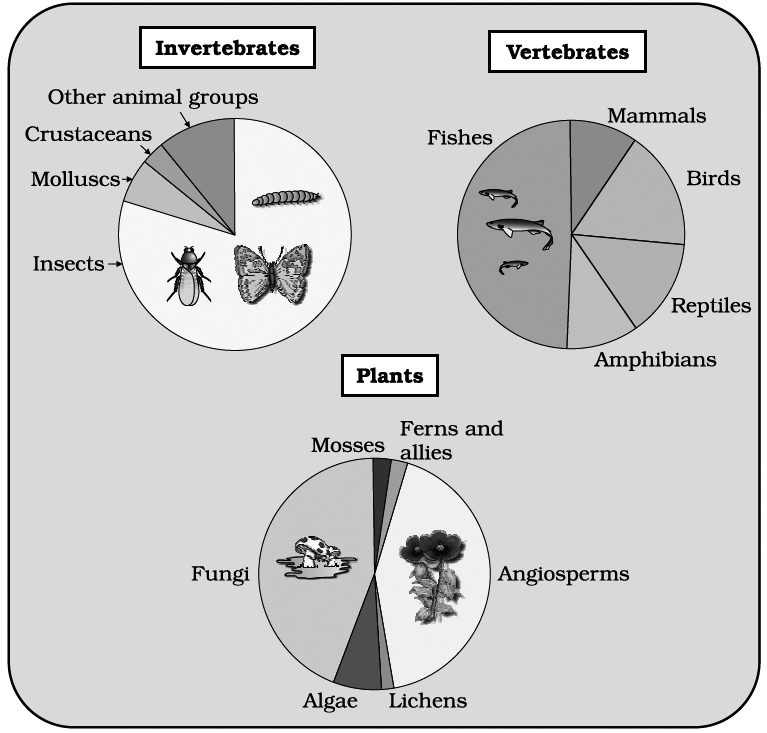
(c) Species evenness or species equitability is the proportionate number of individuals of different species (taxonomic groups). Communities where species are represented by more or less equal number of individuals exhibit evenness. Others where one or more species have more individuals than others show dominance or uneveness.
(d) Maximum / taxonomic diversity occurs where species of taxonomically different groups occur in almost equal abundance.
(iii) Community or Ecosystem Diversity
Diversity at the level of community and ecosystem has three perspectives.
Alpha diversity () refers to the diversity of organisms sharing the same community or habitat.
It is also called local diversity and is diversity within a community.
The rate of replacement of species along a gradient of habitats or communities is called beta diversity ().
It is calculated by dividing by diversity and is diversity between two communities.
Diversity of the habitats over the total landscape or geographical area is called gamma diversity (), also called regional diversity.
It represents the total richness of species in all the habitats found within a region, geographical area or landscape. e.g., India is more diverse than Norway.
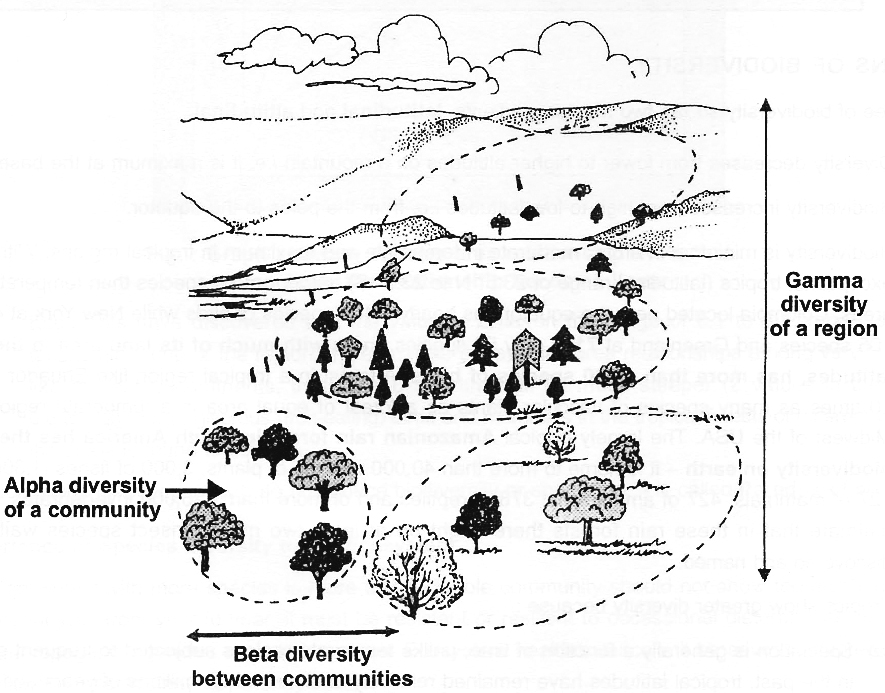
India, is endowed with a rich diversity of the biogeographical regions due to varying physical conditions and species groupings.
Wild life institute of india has divided the country into ten biogeographical regions.
Among the 10 biogeographical regions, Deccan peninsula has the most extensive coverage of the Indian landmass (42%).
The most biodiversity-rich zones, Western Ghats and north-east, account for 4 and 5.2% of the geographical area, respectively.
Each biogeographical zone has several habitats, biotic communities and ecosystems.
A large number of species found in these zones are endemic or exclusive to India.
About 33% of the flowering plants recorded in India are endemic to our country.
Indian region is also notable for endemic fauna.
The endemics are concentrated mainly in North-East, Western Ghats, North-West Himalayas and Andaman and Nicobar Islands.
A very high number of amphibian species are endemic to Western Ghats.
PATTERNS OF BIODIVERSITY
Degree of biodiversity shows two master gradients, latitudinal and altitudinal.
(i) Diversity decreases from lower to higher altitudes on a mountain i.e. it is maximum at the base.
(ii) Biodiversity increases from high to low latitudes i.e. from the poles to the equator.
(iii) Biodiversity is minimum in arctic, moderate in temperate and maximum in tropical regions. With very few exceptions, tropics (latitudinal range of 23.5º N to 23.5º S) harbour more species than temperate or polar areas. Colombia located near the equator has nearly 1,400 species of birds while New York at 41º N has 105 species and Greenland at 71º N only 56 species. India with much of its land area in the tropical latitudes, has more than 1,200 species of birds. A forest in a tropical region like Equador has up to 10 times as many species of vascular plants as a forest of equal area in a temperate region like the Midwest of the USA. The largely tropical Amazonian rain forest in South America has the greatest biodiversity on earth -it is home to more than 40,000 species of plants, 3,000 of fishes, 1,300 of birds, 427 of mammals, 427 of amphibians, 378 of reptiles and of more than 1,25,000 invertebrates. Scientists estimate that in these rain forests there might be at least two million insect species waiting to be discovered and named.
(iv) Tropics show greater diversity because :
(a) Speciation is generally a function of time, unlike temperate regions subjected to frequent glaciations in the past, tropical latitudes have remained relatively undisturbed for millions of years and thus, had a long evolutionary time for species diversification,
(b) Tropical environment is less seasonal, relatively more constant and predictable, and can promote niche specialisation and lead to a greater species diversity.
(c) There is more solar energy available in the tropics, which contributes higher productivity; this in turn might contribute indirectly to greater diversity.
(v) Species-area relationships: Alexander von Humboldt observed that within a region species richness increases with increasing explored area, but only up to a limit. In fact, the relation between species richness and area for a wide variety of taxa (angiosperm plants, birds, bats, freshwater fishes) turns out to be a rectangular hyperbola.
The relationship is a straight line described by the equation
log S = log C + Z log A
where
S = Species richness, A = Area, Z = Slope of the line (regression coefficient), C = Y-intercept.
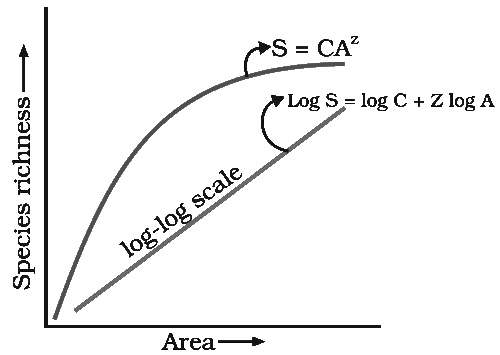
Note that on log scale the relationship becomes linear
Fig. : Graph showing species area relationship.Note that on log scale the relationship becomes linear
Ecologists have discovered that the value of Z lies in the range of 0.1 to 0.2, regardless of the taxonomic group or the region. If we analyse the species-area relationships among very large areas like the entire continents, the slope of the line will be much steeper (Z values in the range of 0.6 to 1.2). For frugivorous (fruit-eating) birds and mammals in the tropical forests of different continents, the slope is found to be 1.15.
(vi) Conditions favouring growth do not induce biodiversity or speciation, it is called Paradox of enrichment.
Importance of Species Diversity to the Ecosystem
1. Community with more species is more stable. Stable community should not show too much variation in productivity from year to year; it must be resistant or resilient to occassional disturbances by natural or anthropogenic agencies and alien species. Ecosystem health/balance will be severly affected if species extinction (particularly key stone) occurs.
2. Results of David Tilman's long term ecosystem experiments using outdoor plots.
(a) Plots with more species showed less year to year variation in total biomass.
(b) Increased diversity contributed to higher productivity.
3. Rivet popper hypothesis (by Paul Ehrlich)

LOSS OF BIODIVERSITY
(i) IUCN red list documents extinctions of 784 species [including 338 vertebrates, 359 invertebrates and 87 plants] in the last 500 years.
(ii) Some recent extinctions -Dodo (Mauritius), Quagga (Africa), Thylacine (Australia), Steller's sea cow (Russia), and three subspecies (Bali, Javan, Caspian) of tiger.
(iii) 27 species have been disappeared in last 20 years.
(iv) Presently 12% birds sp., 23% of all mammals, 32% of all amphibians, and 31% of all gymnosperms in the world are facing the threat of extinction (more than 15,500 species).
(v) Sixth extinction is 100-1000 times more faster.
(vi) This may lead to decline in plant production, lowered resistance, increased variability in ecosystem processes e.g., pest and disease cycle.
(vii) The colonisation of tropical pacific islands by humans is said to have led to the extinction of > 2,000 species of native birds.
Causes of Biodiversity Loss
The process of extinction has been rather rapid during the last one hundred years because of increasing exploitation of wild life by man, who is gradually emerging as major evolutionary force. About 10% of the living species are threatened with extinction.
The factors contributing to extinction of species are discussed below:
1. Destruction of habitats:
Habitat destruction is the most serious threat to the wild life.
It is primary cause of extinction.
The most dramatic examples of habitat loss come from tropical rain forests. Once covering >14% of the earth's land surface, these now cover no more than 6%.
The Amazon rain forest (lungs of the planet) harbouring probably millions of species is being cut and cleared for cultivating soyabeans or for conservation to grasslands for raising beef cattle.
These are destroyed by many human activities as explained below :
(i) Deforestation: Deforestation deprives the wild life of its cover and food because of destruction of wild plants. It reduces the area of their free movement that retards the reproductive capacity of certain animals like rhino, tiger, etc.
(ii) Developmental work: The various developmental works like roads, railways, industries, mines, human settlements, dams, harbours, reservoirs, pastures, croplands, plantations etc. have reduced the natural habitats of wild life.
(iii) Habitat fragmentation: Large habitats are broken into small fragments. It reduces core area and increase edge area. Mammals and birds requiring large territories and migratory animals are badly affected.
2. Overexploitation:
Hunting of animals for food, safety and pleasure has been in practice ever since the appearance of man.
Large scale destruction of wild life occurred with use of fire as a means of hunting.
Excessive hunting has caused the disappearance of cheetah, the fastest mammal of India and dodo (Oidus ineptus), a unique bird of Mauritius.
Dodo of Mauritius, Pessenger pigeon, Stellers sea cow and Tasmanian wolf have become extinct due to overexploitation.
Heath Hen disappeared due to both hunting and habitat destruction.
3. Introduction of exotic species:
Exotic (alien) species on becoming invasive is considered another potent factor for extinction of species.
Examples of some exotic species:
Water Hyacinth (Eichhornia crassipes), Lantana (Lantana camara), Congress grass (Parthenium hysterophorus), Nile perch, Eupatorium (Eupatorium odoratum) and African catfish (Clarias gariepinus).
The native species are adversely affected by intentional or chance introduction of exotic species.
The Nile perch introduced into lake victoria in east Africa led eventually to the extinction of >200 species of cichlid fish in the lake.
The recent illegal introduction of the African catfish Clarias gariepinus for aquaculture purposes is posing a threat to the indigenous catfishes in our rivers.
4. Coextinction of coevolved species, which are related in a obligatory way e.g., plant-pollinator insect mutualism.
Habitat loss and fragmentation, Over-exploitation, Alien species invasions and Coextinction are 4 major causes of biodiversity losses (The Evil Quartet).
Susceptibility to Extinction
Species more susceptible to extinction have following population characteristics.
(i) Large body size (e.g., Rhinoceros, Lion)
(ii) Small population size and low reproductive rate (e.g., Giant Panda, Blue Whale).
(iii) High trophic level in food chain (e.g., Bald Eagle, Bengal Tiger).
(iv) Fixed habitat and migratory routes (e.g., Whooping Crane, Blue Whale).
Conservation of biodiversity
- Books Name
- A TEXT OF BIOLOGY - CLASS XII
- Publication
- ACME SMART PUBLICATION
- Course
- CBSE Class 12
- Subject
- Biology
BIODIVERSITY CONSERVATION
(A) Why should we conserve biodiversity? There are many reasons (all equally important) to conserve biodiversity.
These reasons can be grouped into three categories :
(a) The narrowly utilitarian aspect : Economic importance
(i) Pinus, Abies and Boswellia are major source of paper.
(ii) Pine resin is obtained from Pinus while damar from Shorea robusta.
(iii) Gums: Kuteera gum (Stericulia urens), Bengal Kino gum (Butea monosperma), salar (Boswellia serrata), safed dhaora (Anogeissus latifolia) , gum arabic (Acacia senegal) etc.
(iv) Tannin sources: Uncaria (leaves and young branches), Acacia (bark), Juglans (bark), Caesalpinia (wood and fruits).
(v) Important dyes are: Cutch / Kattha (heartwood of Acacia catechu), henna (leaves of Lawsonia inermis), haematoxylon (heartwood of Haematoxylon campechianum).
(vi) Plants can also be used to manufacture innumerable synthetic products, called botanochemicals.
Some Important Drugs
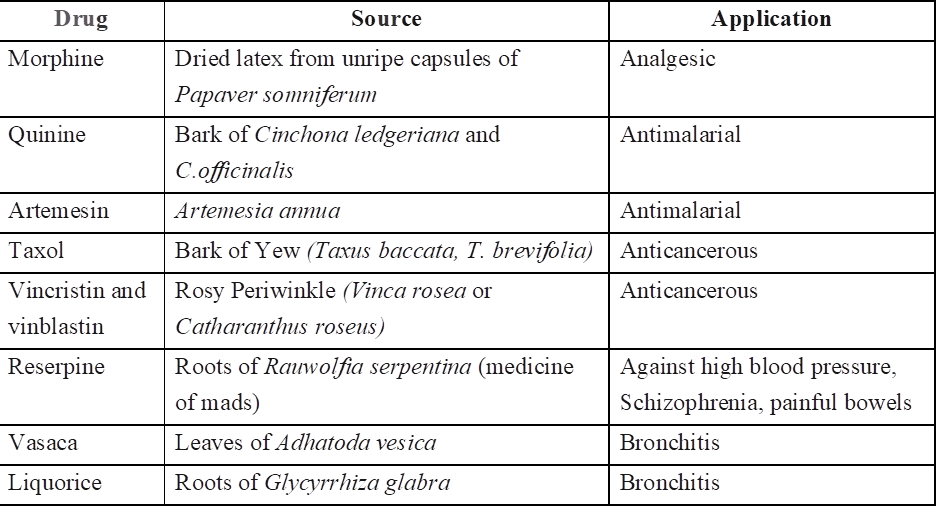
More than 25% of the drugs currently sold in the market worldwide are derived from plants and 25,000 species of plants, contribute to the traditional medicines used by the natives.
(vii) Bioprospecting: Exploring molecular, genetic and species level diversity for products of economic importance.
(b) Broadly utilitarian aspect: Ecosystem services are important, that nature provides.
(i) Amazon forest is estimated to produce 20% of the total 02 in the earth's atmosphere through photosynthesis.
(ii) Pollination -essential for seeds, fruits.
(iii) Flood and erosion control
(iv) Aesthetic pleasures
(c) Ethical aspect: Every species has an intrinsic value, so we have a moral duty to care for their well being.
(B) How do we conserve biodiversity?
1. Concept of Threatened Species The International Union of Conservation of Nature and Natural Resources (IUCN) has classified the rare species of plants and animals into different categories for the purpose of conservation. The classification is based on :
(i) The distribution of species in past and present.
(ii) The decline in number of populations in course of time.
(iii) The abundance and quality of natural habitat.
(iv) The biology and potential value of the species.
The IUCN Red List Categories
The IUCN Red List is a catalogue of taxa that are facing the risk of extinction.
It is important to understand that the Red List aims to impart information about the urgency and scale of conservation problems to the public and policy makers.
The uses of the Red List are :
(i) Developing awareness about the importance of threatened biodiversity.
(ii) Identification and documentation of endangered species.
(iii) Providing a global index of the decline of biodiversity.
(iv) Defining conservation priorities at the local level and guiding conservation action.
The World Conservation Union (formerly known as IUCN) has recognised eight Red List Categories of species: Extinct, Extinct in the Wild, Critically Endangered, Endangered, Vulnerable, Lower Risk, Data Deficient, and Not Evaluated.
List of endangered plants in India include orchids (especially Blue Vanda) , most of tree ferns, pitcher plant (Nepenthes khasiana), Podophyllum, etc.
The IUCN Red list Categories
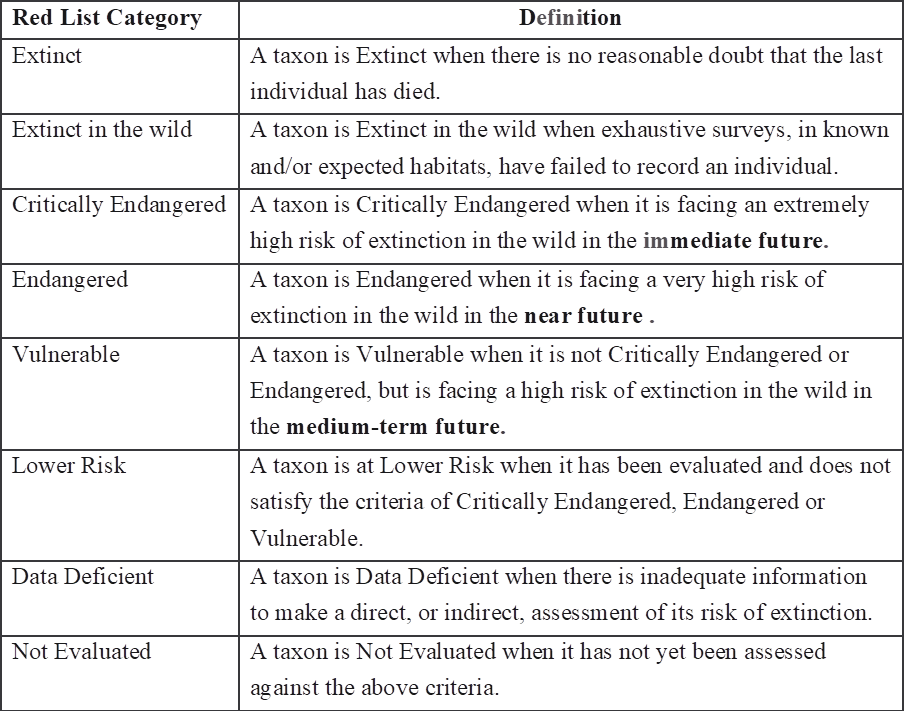
Examples of threatened species in India

2. Conservation Strategies
Some of the steps proposed to protect the existing species of the wild life are discussed below:
(i) The threatened species should be given preference over others in conservation.
(ii) The national protection programmes in different countries should be coordinated with the international programmes, particularly the biosphere reserve programme of the UNESCO's Man and the Biosphere Programme (MAB). The international network of biosphere reserve programme aims to conserve and use the diversity of living organisms for the present and the future within natural ecosystems.
(iii) Every country should set up national parks and sanctuaries to protect wild life and to ensure its multiplication.
(iv) Hunting should be regulated. It should be banned during breeding season of the animals. Killing of young animals should be prohibited.
3. There are two basic strategies of biodiversity conservation, in-situ (on-site) and ex-situ (off-site).
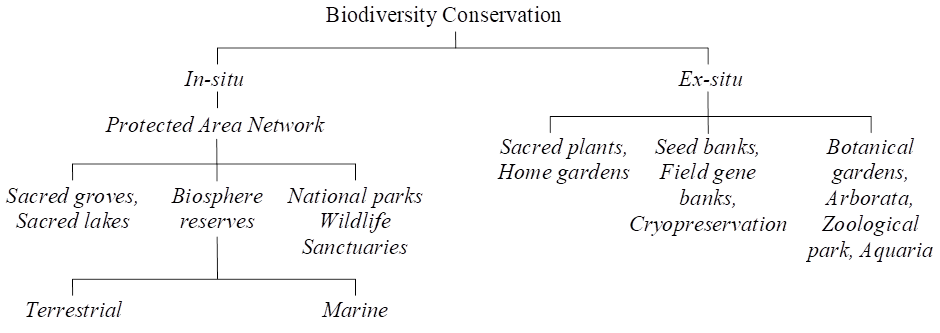
(A) In-situ (on site) Conservation Strategies
The in-situ strategies emphasise protection of total ecosystems. The in situ approach includes protection of a group of typical ecosystems through a network of protected areas.
Protected Areas: These are areas on land and/or sea, especially dedicated to the protection and maintenance of biological diversity, and of natural and associated cultural resources. These are managed through legal or other effective means. Examples of protected areas are National Parks and Wildlife Sanctuaries. The earliest national parks, the Yellowstone in USA and the Royal near Sydney, Australia, were chosen because of their scenic beauty and recreational values. India has (90 National Parks and 448 Wildlife Sanctuaries), covering 4.7% of the land surface, as against 10% internationally suggested norm. The Jim Corbett National Park was the first National Park established in India.
Some of the main benefits of protected areas are :
(i) Maintaining viable populations of all native species and subspecies;
(ii) Maintaining the number and distribution of communities and habitats, and conserving the genetic diversity of all the present species;
(iii) Preventing man-made introductions of alien species; and
(iv) Making it possible for species to shift in response to environmental changes.
Biosphere Reserves: Biosphere reserves are a special category of protected areas of land and/or coastal environments, wherein tribal people are an integral component of the system. These are representative examples of natural biomes and contain unique biological communities. The concept of Biosphere Reserves was launched in 1975 as a part of UNESCO's Man and Biosphere Programme, dealing with the conservation of ecosystems and the genetic resources contained therein. There are 14 biosphere reserves in India. A Biosphere Reserve consists of core, buffer and transition zones. The natural or core zone comprises an undisturbed and legally protected ecosystem. The buffer zone surrounds the core area, and is managed to accommodate a greater research and educational activities. The transition zone, the outermost part of the Biosphere Reserve, is an area of active cooperation between reserve management and the local people, wherein activities like settlements, cropping, forestry, recreation and other economic uses continues in harmony with conservation goals.
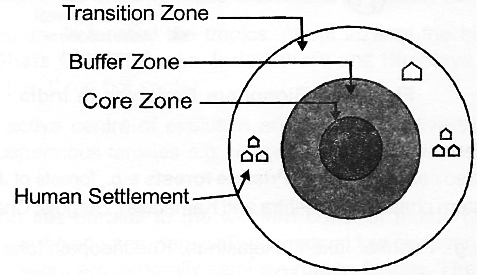
The main functions of biosphere reserves are :
(i) Conservation
(ii) Development
(iii) Scientific research, monitoring and education
A traditional strategy for the protection of biodiversity has been in practice in India and some other Asian countries in the form of sacred forests. In India, sacred forests are located in several parts e.g., Karnataka, Maharashtra, Kerala, Meghalaya etc. and are serving as refuge for a number of rare, endangered and endemic taxa. Similarly, several water bodies (e.g., Khecheopalri lake in Sikkim) have been declared sacred by the people, leading to protection of aquatic flora and fauna.
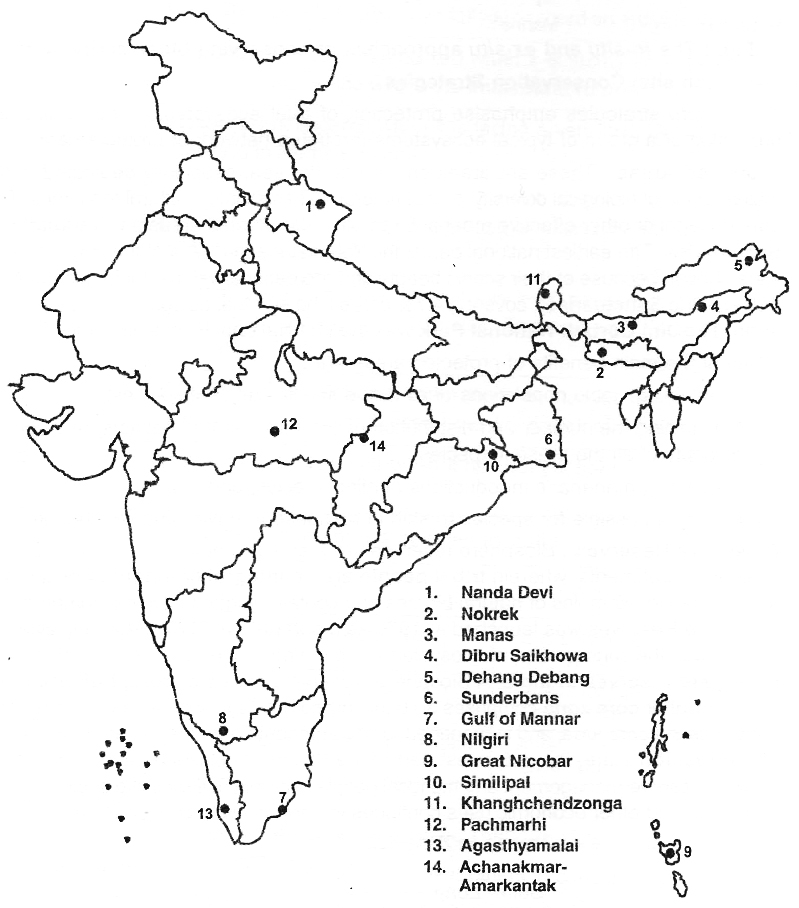
Sacred grooves
(i) Sacred forests: also called Islands of Pristine forests e.g., forests of Jaintia &Khasi (Meghalaya), Aravalli (Rajasthan), Westem ghats (Maharashtra and Karnataka), Surguja, Chanda and Bastar area (M.P.).
(ii) Sacred lakes: e.g., Pushkar lake in Rajasthan, Khecheopalri lake in Sikkim.
(iii) Sacred plants are Ocimum sanctum (Tulsi), Elaeocarpus floribundus, Ficus religiosa etc.
(B) Ex-situ (off site) Conservation Strategies
The ex-situ conservation strategies include botanical gardens, zoos, gene, pollen, seed, seedling, tissue culture and DNA banks.
Seed gene banks are the easiest way to store germplasm of wild and cultivated plants at low temperature in cold rooms.
Preservation of genetic resources is carried out in field gene banks under normal growing conditions.
In vitro conservation, especially by cryopreservation in liquid nitrogen at a temperature of -196°C, is particularly useful for conserving vegetatively propagated crops like potato.
Cryopreservation is the storage of material at ultra-low temperature either by very rapid cooling (used for storing seeds), or by gradual cooling and simultaneous dehydration at low temperature (used for tissue culture).
The material can be stored for a long period of time in compact, low maintenance refrigeration units.
Botanical gardens and arboreta may also have seed banks, tissue culture facilities and other ex-situ technologies. Many of the zoos are conducting captive breeding programmes.
HOT SPOTS OF BIODIVERSITY
Norman Myers developed the concept of hot spots in 1988 to designate priority areas for in-situ conservation.
The hot spots are the richest and the most threatened reservoirs of plant and animal life on earth.
The key criteria for determining a hot spot are:
(i) Number of endemic species i.e. the species which are found in a restricted area only.
(ii) Degree of threat, which is measured in terms of habitat loss.
Initially 25 terrestrial hot spots have been identified globally.
But now the number is raised to 34 with an area of less than 2%.
The number of species they collectively harbour is extremely high and strict protection of these hot spots could reduce the ongoing mass extinctions by almost 30%.
As many as 16 hot spots are in located the tropics.
About 20% of the human population lives in the hotspot regions.
Western Ghats and Sri Lanka, Indo-Burma and Himalaya cover our country's exceptionally high biodiversity regions (i.e. three hot spots).
Eastern Himalaya is an active centre of evolution and has a rich diversity of flowering plants, their occur numerous primitive angiospermous families e.g., Magnoliaceae, Winteraceae and primitive genera of plants, like Magnolia and Betula.
The Western Ghat region lies parallel to the western coast of Indian peninsula for almost 1600 km, in Maharashtra, Karnataka, Tamil Nadu and Kerala.
The forests at low elevation are mostly evergreen, while those found at 500-1500 meter height are generally semi-evergreen forests.
The Agasthyamalai hills, the Silent Valley and the new Amambalam Reserve, are the main centres of diversity.
The historic convention on Biological Diversity (The Earth Summit) held in Rio de Janeiro in 1992, called upon all nations to take appropriate measures for conservation of biodiversity and sustainable utilisation of its benefits.
In a follow-up, The World Summit on sustainable development held in 2002 in Johannesburg, South Africa, where 190 countries pledged their commitment to achieve, a significant reduction in the current rate of biodiversity loss of global, regional and local levels by 2010.
Some Important Definitions
1. Genetic diversity : A single species might show high diversity at the genetic level over its distributional range.
2. Species diversity: The diversity at the species level.
3. Community or ecosystem diversity: It is diversity at community and ecosystem levels.
4. Alpha diversity () : Refers to the diversity of organisms sharing the same community or habitat.
5. Beta diversity () : The rate of replacement of species along a gradient of habitats or communities.
6. Gamma diversity () : Diversity of the habitats over the total landscape or geographical area.
7. Endemism: Species confined to that region and not found anywhere else.
8. In situ conservation (on site) : It is conservation and protection of the whole ecosystem and its biodiversity at all levels in order to protect the threatened species.
9. Ex situ conservation (off site) : It is conservation of selected rare plants/animals in places outside their natural homes.
10. Paradox of enrichment: Conditions favouring growth do not induce biodiversity or speciation.
11. Critically Endangered : When a taxon is facing an extremely high risk of extinction in the wild in the immediate future.
12. Endangered: When a taxon is facing a very high risk of extinction in the wild in the near future.
13. Vulnerable: When a taxon is not critically endangered or endangered but is facing a high risk of extinction in the wild in the medium term future.
14. Biosphere reserves: A special category of protected areas of land and/or coastal environments, wherein tribal people are an integral component of the system.
15. Hot spots: These are areas of high endemism and very high levels of species richness.
16. National parks: These are areas reserved for wildlife where the latter is able to obtain all the required natural resources and habitats.
17. Sanctuaries: These are tracts of land with or without a lake where animals are protected from all types of exploitation and habitat disturbance.
18. Cryopreservation: In vitro conservation in which tissue, organs, embryos, seed etc. are stored at very low temperature of -196°C (temperature of liquid nitrogen).
Air pollution and control
- Books Name
- A TEXT OF BIOLOGY - CLASS XII
- Publication
- ACME SMART PUBLICATION
- Course
- CBSE Class 12
- Subject
- Biology
Kinds of Pollution
(a) On the basis of origin : It is of two types
(i) Natural Pollution : Pollution caused by natural phenomena like emission of large quantity of toxic gases and particulate matter by volcanoes, landslides, forest fires, marsh gas, U.V. rays etc.
(ii) Anthropogenic Pollution : It is man made pollution caused by human activities like noise, automobiles, pesticides, industries etc. Its magnitude is quite less as compared to Natural Pollution. Anthropogenic pollution can be personal (smoking), community level (thermal power plant) or occupational (flour mill dust). For example; 0.05% of atmospheric pollution is man made while 99.95% is natural pollution.
(b) On the basis of physical nature: It may be gaseous, dust, thermal, noise or radioactive pollution depending on physical nature of pollutants.
(c) On the basis of part of environment: Pollution may be broadly classified as air, water and soil pollution.
(d) On the basis of emission: Pollution is classified as :
(i) Point source: Pollution is being emitted from a single point or definite source. e.g. municipal sewer passing into water body.
(ii) Non point source: Pollution is being emitted from a large area. e.g., agricultural run off
(iii) Area source: Whole area like mining area is producing pollution. e.g., mining area, industrial complex.
Classification of Pollutants
1. Based upon their natural disposal, pollutants are of two types:
(i) Biodegradable pollutants: These are easily decomposable wastes by natural processes and also by some artificial methods which include microbial action and radiations. Domestic sewage is the main pollutant of this category.
(ii) Non-degradable pollutants: These are generally not degraded or degraded at a very slow pace by the natural biological processes. e.g., aluminium cans, mercurial salts, long chain phenolic chemicals, DDT, arsenic salts of heavy metals, glass, tin containers, radioactive materials and plastics. These not only accumulate but often get biologically magnified.
2. According to their existence in nature, the pollutants may be quantitative or qualitative.
(i) Qualitative pollutants: They are pollutants which do not normally occur in the environment but are passed into it through human activity e.g., DDT and other pesticides, fungicides, herbicides, etc.
(ii) Quantitative pollutants: They become pollutants only when their concentration reaches beyond a critical value in the environment e.g., CO, CO2, nitrogen oxides.
3. On the basis of form of pollutants in which these persist after their release into the environment, these are again of two types:
(i) Primary pollutants: These are emitted directly in the environment from some definite sources such as particles of metals, carbon, DDT, tar, resin, pollen, fungi, bacteria, silicates, plastics, sulphur compounds in the form of SO2, SO3, H2S; carbon compounds in the form of CO, CO2; nitrogen compounds (NOx).
(ii) Secondary pollutants: These are formed by the reactions of primary pollutants in the environment e.g., a photochemical reaction occurs in the presence of bright sunlight between nitrogen oxide and waste hydrocarbons to form peroxyacetyl nitrate (PAN), Ozone (O3) etc.
AIR OR ATMOSPHERIC POLLUTION
It is defined as occurrence or presence of any material or gas in the air in such a concentration which is harmful to man, vegetation, animals and their environment.
With the gradual increase in the number of industries and automobiles, air pollution has now reached menacing proportions in big cities and industrial centres.
I. Causes / sources of air pollution
Various sources of atmospheric pollution are as follows :
1. Fossil fuels and fibres: Incomplete and complete combustion of the carbon contents of fossil fuel wood and charcoal produce carbon monoxide and carbon dioxide alongwith sulphur dioxide.
2. Emission from vehicles : Emission from automobiles, locomotives, aircrafts and exhausts in cities constitutes the major part of the total air pollution.
3. Industries: Industries add various harmful gases like CO, CO2, SO2, H2S, NO, hydrocarbons and small particles of dust, carbon, metals, radioactive materials etc. to the atmosphere.
4. Natural sources: Volcanic eruptions, forest fires, natural organic and inorganic decays, marsh gases, pollen grains of flowers, fungal spores, etc.
5. Metallurgical processing
II. Common air pollutants and their effects
These are basically of two types i.e. gaseous materials, particulate matter.
1. Gaseous Materials :
(a) Carbon monooxide : It is a product of incomplete combustion of fossil fuels (charcoal, coal mines). 50% emissions are contributed from automobiles. It produces COHb (carboxyhemoglobin) and reduces O2 carrying capacity of blood, resulting in giddiness, decreased vision, headache, cardiovascular malfunction and asphyxia.
(b) Hydrocarbons (HCs) or Volatile organic carbons (VOCs) : They are produced naturally (e.g., CH4) or due to incomplete combustion as unburnt discharges. These may lead to produce secondary pollutants, when combines with NOx Benzene and HCHO are carcinogenic and causes irritation of eyes and mucous membrane and causes bronchial constriction. HCHO released from newly formed carpets lead to indoor pollution.
(c) SO2: It is produced during combustion of sulphur containing fossil fuels, smelting of ore and from oil refineries. It causes eye irritation, severe respiratory problems, inhibits ET8 in plants. Also responsible for classical smog (London smog or sulphurous smog) acid rains and stone cancer. SO2 causes phaeophytization in lichens. So their absence is indicator of SO2 pollution. This may cause discolouration and deterioration of buildings, sculptures (yellowning of Taj Mahal is reported to be caused by SO2 pollution released by Mathura oil refinery).
(d) Nitrogen oxides (NOx) : Mainly produced during combustion of fossil fuels at high temperature in automobile engines (mainly NO and NO2). Nitrogen oxides cause the brown air that leads to heart and lung problems.
Secondary Air Pollutants:
Formed through a reaction between primary pollutants and often are more toxic.
Oxides of nitrogen reacts with hydrocarbons in presence of sunlight to produce PAN and O3.
In trophosphere the O3 is a chemical weed and can cause eye irritations and sometimes prove fatal, while PAN can have damaging effect on eyes and may induce respiratory distress. It can inhibit ETS in chloroplast and may results in silvering or glazing of leaves.
Smog : Opaque or dark fog having smoke, dust, water vapours and gases.
Acid Rain
The term was given by Robert Augus.
It is rainfall with a pH of less than 5.65. It is due to oxides of sulphur and nitrogen.
There are two types of acid deposition -wet and dry deposition.
About half of the acidity in the atmosphere is transferred to earth through dry deposition.
65% acid rain is due to SO2 emission, 30% due to nitrogen oxides and 5% due to release of hydrogen chloride from chemical industries.
Acid rain damages foliage and growing points of plants and causes leaching of essential minerals of soil.
It corrodes metals, marble, painted surface, slate, stone etc.
This phenomenon is called stone leprosy.
2. Particulate Matter:
These are added into the air by industries automobiles and by many operations like blasting, drilling, crushing, grinding, mixing etc.
These pollutants may be either solid or liquid particles. It is differentiated into Settleable ( 10 µm, settles out in less than one day) and Suspended ( 10 µm) remaining in air for weeks.
Some particulate matters are given below:
(a) Aerosols. These are the vapour chemicals in the form of fluorocarbons, chlorofluorocarbons, oxides of sulphur and nitrogen released into the air with force by the emission of jet and supersonic aeroplane emissions. Fog is an aerosol of water droplets in air. Aerosols are also used as disinfectants, in refrigeration and in the formation of certain solid plastic foams.
(b) Smoke. Similar to dust but consists of visible suspension of carbon and other particles given off by burning and smouldering organic matter. Smog is a combination of smoke, chemical fumes and fog. It remains suspended for many days and envelops the entire industrial area like a thick blanket due to stagnant air. It produces respiratory problems in humans such as asthma and bronchitis. Smoke does not allow a clear view of nature's beauty. The power stations throw out large amount of fly ashes (fine particulate matter passed out alongwith gases during burning of coal).
(c) Dust and mist. Dust (more than 1µm), Mist (more than 1 µm but liquid). These releases from industries and may cause a variety of diseases like, cotton dust produces lung fibrosis called byssinosis. Lung fibrosis produced in other industries includes asbestosis (in asbestos industry), silicosis (stone grinders), siderosis (iron mill), coal miners pneumoconiosis, flour mill pneumoconiosis etc. Manganese poisoning has been reported in welders.
(d) Pollen, spores, cysts and bacteria. Air borne organic constituent like pollens, spores, cysts, fungi, bacteria, fur, etc. may cause allergic reactions, bronchial asthma, emphysema, T.B. and lung cancer. The number increases in certain seasons. Skin allergy and asthma like diseases are very common from Parthenium plant in India. The hay fever from pollen allergy is very common.
III. Control of air pollution
1. Separation of pollutants from harmless gases
(i) Control equipments in industries such as gravity settling tanks, cyclone collectors, remove and precipitate large and small pollutant particles and thus, minimise the air pollution. Electrostatic precipitators are used in thermal power plants. These can remove over 99% particulate matter present in the exhaust from a thermal power plant.
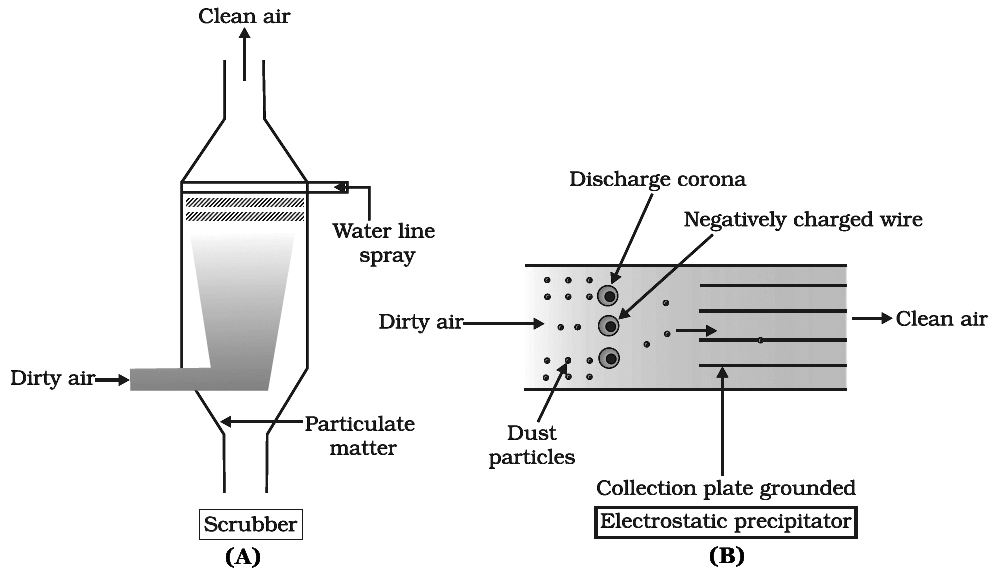
It has electrode wires that are maintained at several thousand volts, which produce a corona that releases electrons.
These electrons attach to dust particles giving them a net negative charge.
The collecting plates are grounded and attract the charged dust particles.
The velocity of air between the plates must be low enough to allow the dust to fall.
A scrubber can remove gases like sulphur dioxide.
In a scrubber, the exhaust is passed through a spray of water or lime.
Recently we have realised the dangers of particulate matter that are very very small and are not removed by these precipitators.
According to Central Pollution Control Board (CPCB), particulate size 2.5 micrometers or less in diameter are responsible for causing the greatest harm to human health.
These fine particulates can be inhaled deep into the lungs and can cause breathing and respiratory symptoms, irritation, inflammations and damage to the lungs and premature deaths.
Catalytic converter have expensive metals, namely platinum, palladium, rhodium and can convert NOx to nitrogen and CO to CO2.
(ii) Controlling Vehicular Air Pollution -A Case Study of Delhi :
(a) Delhi leads the country in its levels of air-pollution -it has more cars than the states of Gujarat and West Bengal put together. In the 1990s, Delhi ranked fourth among the 41 most polluted cities of the world. Air pollution problems in Delhi became so serious that a public interest litigation (PIL) was filed in the Supreme Court of India. After being censured, the government was asked to take, within a specified time period, appropriate measures, including switching over the entire fleet of public transport, i.e., buses, from diesel to compressed natural gas (CNG). All the buses of Delhi were converted to run on CNG by the end of 2002.
Advantages of CNG
1. CNG burns most efficiently.
2. CNG is cheaper than petrol or diesel.
3. Cannot be siphoned off by thieves and adulterated like petrol or diesel.
4. The main problem that government has faced is the difficulty of laying down pipelines to deliver CNG through distribution points/pumps and ensuring uninterrupted supply.
Use of unleaded petrol, use of low-sulphur petrol and diesel, use of catalytic converters in vehicles, application of stringent pollution-level norms for vehicles, etc. are other steps taken to reduce pollution in Delhi.
(b) Stringent norms for fuels were given in new auto fuel policy for steadily reducing the sulphur and aromatic contents in petrol and diesel fuels. Euro-II norms, for example, stipulates that sulphur be controlled at 350 parts-per-million (ppm) in diesel and 150 ppm in petrol. Aromatic hydrocarbons are to be contained at 42 per cent of the concerned fuel. The goal, according to the road map prepared by Indian Government, is to reduce sulphur to 50 ppm in petrol and diesel and bring down the level to 35 per cent. Vehicle engines will also need to be upgraded.
(c) The Bharat Stage II (equivalent to Euro-II norms), which is currently in place in Delhi, Mumbai, Kolkata, Chennai, Bangalore, Hyderabad, Ahmedabad, Pune, Surat, Kanpur and Agra, will be applicable to all automobiles throughout the country from April 1, 2005. All automobiles and fuelpetrol and diesel -were to have met the Euro-III emission specifications in these 11 cities from April 1, 2005 and have to meet the Euro-IV norms by April 1, 2010. The rest of the country will have Euro-III emission norm compliant automobiles and fuels by 2010.
(d) A substantial fall in CO2 and S02 level has been found in Delhi between 1997 and 2005.
(iii) Height of chimneys in industries should be increased to the highest possible level to reduce smoke pollution at ground level.
(iv) Trees purify the air by consuming CO2 and releasing oxygen. Trees should be grown in all available places. Certain plants like Phaseolus vulgaris, Coleus blumei, Daucus carota and Ficus variegata fix carbon monoxide of the air. Similarly Vilis, Pinus, Juniperus, Pyrus, and Robinia pseudoacacia etc. are capable of metabolising oxides of nitrogen and other gaseous pollutants. These plants certainly help in reducing air pollution to a great extent.
2. Avoidance of Air Pollutants
(a) Industries should be set up at a far off distance from residential areas.
(b) Air pollution boards should enforce emission standards, frame rules and regulation for the control of air pollution.
(c) Firewood, coal and oil should be completely replaced by nuclear power, solar power, tidal power, wind power, natural gas or electricity which do not emit oxides of carbon, sulphur or nitrogen in the air.
(d) Automobile use should be minimised which emits high amount of air pollutants.
(e) Human population growth should be checked which is the major cause of air pollution.
Water pollution and control
- Books Name
- A TEXT OF BIOLOGY - CLASS XII
- Publication
- ACME SMART PUBLICATION
- Course
- CBSE Class 12
- Subject
- Biology
WATER POLLUTION
Water pollution may be defined as any adverse change in composition and condition of the water which tend to lower its quality and cause health hazard or makes it unfit for domestic use.
I. Sources and effects of water pollution
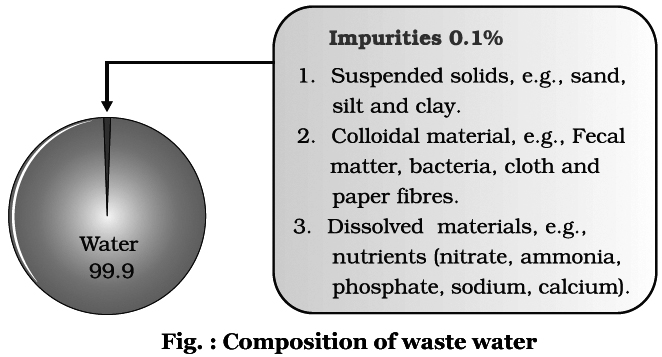
(i) Sewage and domestic wastes.
Nearly 75% of water pollution is due to sewage and domestic wastes.
A mere 0.1 % impurities make domestic sewage unfit for human use (Fig.).
Sewage generally includes biodegradable pollutants like human faecal matter, animal wastes and many dissolved organic compounds e.g., carbohydrates, proteins, fats, urea etc. inorganic salts such as nitrates and phosphates of detergents.
These pollutants under natural processes are rapidly decomposed.
In water, organic wastes provide nutrition for many decomposers like bacteria.
These break down the organic part by using bulk of oxygen and deficiency of oxygen (reduced DO) kills the fishes and other aquatic animals.
Anaerobic bacteria in oxygen deficient water disrupt food chains.
Anaerobic bacteria produce foul smelling gases. These give rise to many other pollutants like H2S, NH3, organic sulphides, methane etc.
These make the water brownish and turbid.
Pollution strength is characterized by its Biochemical oxygen demand (BOD).
BOD is defined as the amount of oxygen (mg) consumed by microbiological action when 1000 ml sample of water containing known amount of oxygen is incubated for 5 days at 20°C in the dark.
A high BOD indicates intense level of biodegradable pollutants.

Water having DO content below 8.0 mg/L is considered as polluted. Heavily polluted waters have DO content below 4.0 mg/L.
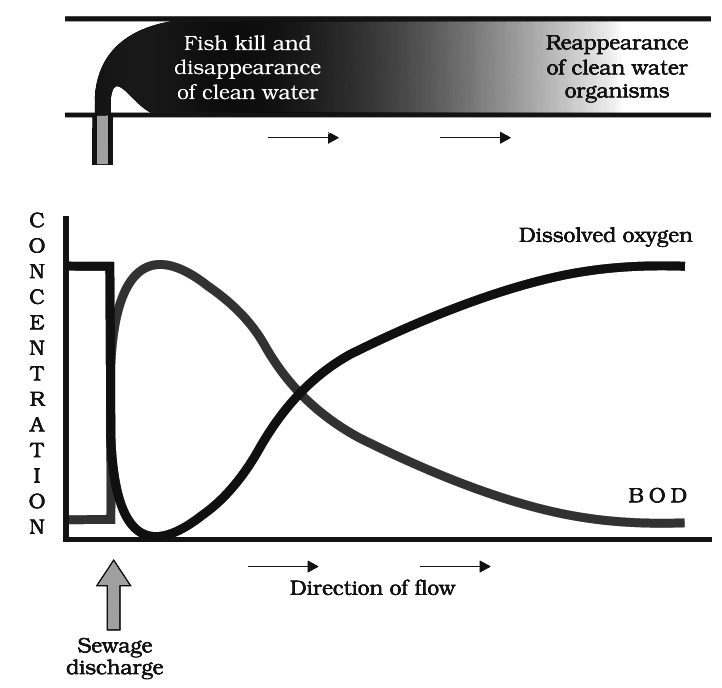
COD (chemical oxygen demand) indicates total O2 requirement by all the O2 consuming pollutant materials (organic and chemical compounds) present in water.
Its value is higher than BOD. Annelid worm Tubifex and some insect larvae act as indicator species for polluted waters.
(ii) Industrial wastes and effluents.
The industrial wastes and their effluents include poisonous materials like acids, alkalies, chromium salts, phenols, cyanides, insecticides, agricultural chemicals, chlorine, ammonia, hydrogen sulphides, salts of heavy metals such as of copper, lead, zinc and mercury.
The water becomes toxic and deoxygenated, so this cannot support aquatic life.
Mercury enters the food chain, kills fish and poisons the remaining fauna, mercury cause minamata disease.
People feeding on these aquatic forms develop numbness of limbs and lips, impairment in speech hearing and vision, meningitis and genetic disorders.
Oils deplete oxygen of water, inhibit plankton growth and photosynthesis.
Sea birds smeared with oil fall sick and die.
Organic phosphates and nitrates enhance growth of algal blooms.
Black foot disease is caused by chronic exposure to arsenic.
(iii) Insecticides and pesticides.
Insecticides are biologically active chemicals are used for pest control.
These include D.D.T., S.H.C., copper sulphate and aldrin etc.
Aquatic microorganisms absorb them in fats and oils.
Fish feeding on these zooplanktons and phytoplanktons further concentrate these pesticides in their tissues.
Birds feeding on these fish concentrate these pesticides still more.
The increased accumulation of these toxic substances in the food chain at higher trophic level is called biological magnification.
Many species of predatory birds like eagles, cormorants, hawks have shown serious adverse effects from this accumulation.
Thinning of egg shells is the major effect.
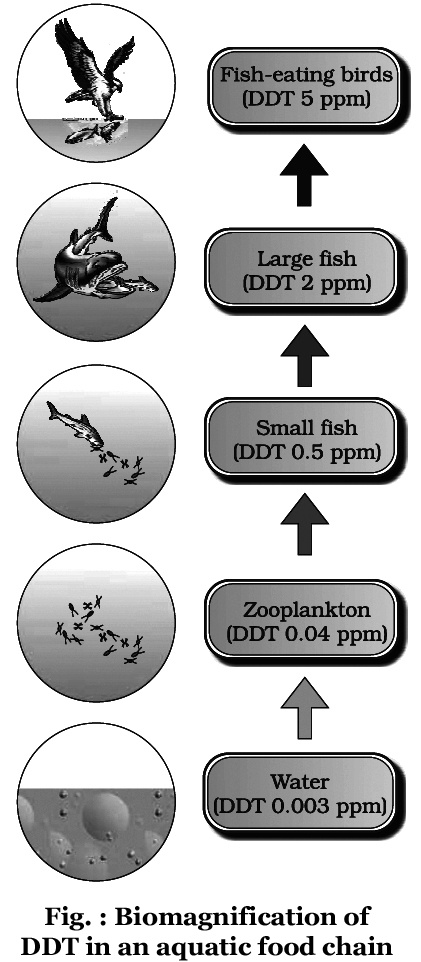
The degree of magnification of insecticides is generally proportional to their persistence and inversely related to their solubility in water.
(iv) Detergents and fertilizers.
Detergents are washing materials in water which cause soapiness.
These form a film around organic waste.
Some of the fertilizers such as nitrates and phosphates are used in agriculture to increase the crops yield reach through irrigation, rainfall and drainage into rivers and ponds where they seriously disturb the aquatic ecosystem.
When such waters are used by animals, the nitrates of polluted water become reduced to toxic nitrites in their body by intestinal bacteria.
The nitrites in the body combine with haemoglobin to cause a serious disease called methaeglobinemia or Blue baby syndrome.
It reduces the oxygen carrying capacity of the blood.
It damages respiratory and vascular systems and sometimes causes suffocation.
Eutrophication The natural aging of a lake by biological enrichment of its water.
In a young lake the water is cold and clear, supporting little life.
With time, streams draining into the lake introduce nutrients such as nitrogen and phosphorus, which encourage the growth of aquatic organisms.
As the lake's fertility increases, plant and animal life burgeons, and organic remains begin to be deposited on the lake bottom.
Over the centuries, as silt and organic debris pile up, the lake grows shallower and warmer, with warm-water organisms supplanting those that thrive in a cold environment.
Marsh plants take root in the shallows and begin to fill in the original lake basin.
Eventually, the lake gives way to large masses of floating plants (bog), finally converting into land.
Pollutants from man's activities like effluents from the industries and homes can radically accelerate the aging process.
This phenomenon has been called Cultural or Accelerated Eutrophication.
Eichhomia crassipes grow abundantly in eutrophic water body.
(v) Siltation.
Excessive agricultural and forestry practices cause soil erosion (removal of top fertile soil) during heavy rain.
The water becomes muddy which fails to support much plant growth due to poor light.
(vi) Thermal pollution.
Heated waste water from power plants and industries, which raises the temperature of water to a harmful level is called thermal pollution.
Thermal pollution speeds up the biodegradation of organic matter which results into ecological imbalance of the rivers and streams.
Warm water holds less oxygen as heat causes deoxygenation in water.
It increases the rate of metabolism and microbial activity.
Many fish and other aquatic animals which are sensitive to temperature changes in water cannot withstand and die.
II. A Case Study of Integrated Waste Water Treatment
Waste water including sewage can be treated in an integrated manner. An example of such an initiative is the town of Arcata (California).
The townspeople created an integrated waste water treatment process within a natural system in collaboration with Humboldt State University.
The cleaning occurs in two stages:
(a) The conventional sedimentation, filtering and chlorine treatments are given. After this stage, but dissolved heavy metals still remain.
(b) The biologists developed a series of six connected marshes over 60 hectares of marshland. Appropriate organisms were seeded into this area, which neutralise, absorb and assimilate the pollutants. Hence, as the water flows through the marshes, it gets purified naturally, marshes also constitute a sanctuary.
Friends of the Arcata Marsh (FOAM) are responsible for the upkeep and safeguarding of this wonderful project.
Ecological sanitation is a sustainable system for handling human excreta, using dry composting toilets. This is a practical, hygienic, efficient and cost-effective solution by which human excreta can be recycled into a resource (as natural fertiliser), which reduces the need for chemical fertilisers. There are working 'EcoSan' toilets in many areas of Kerala and Sri Lanka.
Solid wastes
- Books Name
- A TEXT OF BIOLOGY - CLASS XII
- Publication
- ACME SMART PUBLICATION
- Course
- CBSE Class 12
- Subject
- Biology
Soil pollutants and their effects
Agrochemicals-pesticides and weedicides :
A number of chemicals have been developed to kill a variety of pests in order to improve agriculture, forestry, horticulture and water reservoirs.
The most widely used among them are insecticides.
Most of these insecticides are broad spectrum and affect other animals, man and even plants.
They are, hence, also called biocides.
These include:
(i) Organo insecticides: They include DDT, PCB, Aldrin, BHC (benzene hexachloride) etc. Chlorinated hydrocarbons are toxic. Besides being toxic, these pesticides are both persistent and mobile in the ecosystem. The chlorinated hydrocarbons like DDT results in biological magnification.
Organophosphorus compounds (e.g., malathion, parathion) and organocarbamates are degradable but they influence the nervous system.
(ii) Weedicides (Herbicides) : The weedicides or herbicides are usually metabolic inhibitors which stop photosynthesis and other metabolic activities and hence kill the plants.
2. Industrial wastes:
Both solid and liquid wastes of the industry are dumped over the soil.
The wastes contain a number of toxic chemicals like mercury, copper, zinc, lead, cadmium, cyanides, thiocyanates, chromates, acids, alkalies, organic solvents etc.
3. Mine dust:
It is a major source of poilution in mining areas.
Mine dust not only spreads with wind but also spread over a large area during transportation to purification plants.
4. Fertilizers:
Excessive use of chemical fertilizers causes soil deterioration through the decrease in natural bacterial population (nitrogen fixing, nitrifying, etc.) and destruction of crumb structure.
The salt content of the soil is also bound to increase with continuous use of fertilizers.
Case Study of Organic Farming
Integrated organic farming is a cyclical, zero-waste procedure, where waste products from one process are cycled as nutrients for other processes.
This allows the maximum utilisation of resources and increases the efficiency of production.
Ramesh Chandra Dagar, a farmer in Sonipat, Haryana, is doing just this. He includes bee-keeping, dairy management, water harvesting, composting and agriculture in a chain of processes, which support each other and allow an extremely economical and sustainable venture.
There is no need to use chemical fertilisers for crops, as cattle excreta (dung) are used as manure.
Crop waste is used to create compost, which can be used as a natural fertiliser or can be used to generate natural gas for satisfying the energy needs of the farm.
Enthusiastic about spreading information and help on the practice of integrated organic farming, Dagar has created the Haryana Kisan Welfare Club, with a current membership of 5000 farmers.
Agro-chemicals and their effects
- Books Name
- A TEXT OF BIOLOGY - CLASS XII
- Publication
- ACME SMART PUBLICATION
- Course
- CBSE Class 12
- Subject
- Biology
Agrochemicals-pesticides and weedicides :
A number of chemicals have been developed to kill a variety of pests in order to improve agriculture, forestry, horticulture and water reservoirs.
The most widely used among them are insecticides.
Most of these insecticides are broad spectrum and affect other animals, man and even plants.
They are, hence, also called biocides.
These include:
(i) Organo insecticides: They include DDT, PCB, Aldrin, BHC (benzene hexachloride) etc. Chlorinated hydrocarbons are toxic. Besides being toxic, these pesticides are both persistent and mobile in the ecosystem. The chlorinated hydrocarbons like DDT results in biological magnification.
Organophosphorus compounds (e.g., malathion, parathion) and organocarbamates are degradable but they influence the nervous system.
(ii) Weedicides (Herbicides) : The weedicides or herbicides are usually metabolic inhibitors which stop photosynthesis and other metabolic activities and hence kill the plants.
2. Industrial wastes:
Both solid and liquid wastes of the industry are dumped over the soil.
The wastes contain a number of toxic chemicals like mercury, copper, zinc, lead, cadmium, cyanides, thiocyanates, chromates, acids, alkalies, organic solvents etc.
3. Mine dust:
It is a major source of poilution in mining areas.
Mine dust not only spreads with wind but also spread over a large area during transportation to purification plants.
4. Fertilizers:
Excessive use of chemical fertilizers causes soil deterioration through the decrease in natural bacterial population (nitrogen fixing, nitrifying, etc.) and destruction of crumb structure.
The salt content of the soil is also bound to increase with continuous use of fertilizers.
Case Study of Organic Farming
Integrated organic farming is a cyclical, zero-waste procedure, where waste products from one process are cycled as nutrients for other processes.
This allows the maximum utilisation of resources and increases the efficiency of production.
Ramesh Chandra Dagar, a farmer in Sonipat, Haryana, is doing just this. He includes bee-keeping, dairy management, water harvesting, composting and agriculture in a chain of processes, which support each other and allow an extremely economical and sustainable venture.
There is no need to use chemical fertilisers for crops, as cattle excreta (dung) are used as manure.
Crop waste is used to create compost, which can be used as a natural fertiliser or can be used to generate natural gas for satisfying the energy needs of the farm.
Enthusiastic about spreading information and help on the practice of integrated organic farming, Dagar has created the Haryana Kisan Welfare Club, with a current membership of 5000 farmers.
SOLID WASTE
Solid wastes refer to everything that goes out in trash.
Sanitary landfills were adopted as the substitute for open-burning dumps where in a sanitary landfill, wastes are dumped in a depression or trench after compaction, and covered with dirt everyday.
But these sites are getting filled too and seepage of chemicals, etc., from these landfills pollutes underground water resources.
Anthropogenic solid waste is categorised into three types -(a) bio-degradable, (b) recyclable and (c) the non-biodegradable.
Polyblend, a fine powder of recycled modified plastic, was developed by the company owned by Ahmed Khan in Bangalore.
This mixture is mixed with the bitumen that is used to lay roads.
Blends of Polyblend and bitumen, when used to lay roads, enhanced the bitumen's water repellant properties, and helped to increase road life by a factor of three.
The use of incinerators (burning in presence of O2 at 900-1200°C) other is pyrolysis (anaerobic burning at 16S0°C) is crucial for disposal of hospital waste.
Irreparable computers and other electronic goods are known as electronic wastes (e-wastes). E-wastes are buried in landfills or incinerated.
Over half of the e-wastes generated in the developed world are exported.
Recycling is the only solution for the treatment of e-wastes, provided it is carried out in an environment-friendly manner.
Developing countries like China, India and Pakistan imports over half of the e-waste generated by developed countries for recovery of metals like copper, iron, silicon, nickel and gold.
RADIOACTIVE WASTES
It is physical pollution of air, water and soil with radioactive materials.
Radioactivity is the property of certain elements (radium, thorium, uranium etc.) to spontaneously emit protons (alpha particles), electrons (beta particles) and gamma rays (electromagnetic waves of very short wavelength) by disintegration of their atomic nuclei.
The elements that give radiation are called radioactive elements.
The use of nuclear energy has two very serious inherent problems.
The first is accidental leakage, as occurred in the Three Mile Island and Chernobyl incidents and the second is safe disposal of radioactive wastes.
It causes mutations to occur at a very high rate.
At high doses, nuclear radiation is lethal and at lower doses, it creates various disorders, the most frequent of all being cancer.
It has been recommended that storage of nuclear waste, after sufficient pre-treatment, should be done in suitably shielded containers buried within the rocks, about 500 m deep below the earth's surface.
Production of nuclear weapons involves the tests of nuclear arms.
These tests produce large amount radioactive elements into the environment and make other materials also radioactive. They include strontium-90, cesium-137, iodine-131 and some others.
The radioactive materials are transformed into gases and fine particles which are carried to distant places by wind.
When rain drops, the radioactive particles fall on the ground, it is called fall out.
Strontium-90 accumulates in the bones, replaces calcium and may cause bone cancer and tissue degeneration in most animals and man.
The operation of a nuclear power plant releases large amounts of energy.
This energy is used in large turbines, which produce electricity.
Wastes from atomic reactors also contain radioactive materials.
The biggest problem is the disposal of these radioactive wastes.
If these wastes are not properly disposed off, can harm the living organisms wherever they may be dumped.
NOISE POLLUTION
The quality of our environment is judged, apart from other factors, by the amount of noise present.
Noise has been defined as "unwanted sounds" which is being "dumped" into the atmosphere to disturb the unwilling ears.
It adversely affects our physiological and mental health.
Noise is measured by a sound meter and is expressed in a unit called decibel (dB).
Any value more than 80 dB causes noise pollution.
Noise becomes unbearable at 140 dB.
The quietest sound that man's ear can detect is known as threshold of hearing.
A noise that hurts one's ears and gives headache is called threshold of pain.
The role of sound vibrations is measured in cycles per second (cps) or hertz (Hz).
The ear is potentially liable to damage, if it receives high intensity noise.
Noise in general is a physical form of pollution.
It has no persistent adverse effects on the life supporting systems but, has direct effects on the recipients.
Moderate conversation = 60 dB
Loud conversation = 70 dB
Scooter = 80 dB
Truck / Bus = 90 dB
Jet aeroplane = 150 dB
Rocket = 180 dB
Zone-wise permissible ambient noise levels (acoustic zoning) are given below. (According to central pollution control board)

I. Sources of Noise Pollution
Noise can either be natural like thundering sound or man made. The main sources of man made noise pollution are:
(i) Annoying and damaging sounds of various industries.
(ii) Defence material like rockets, tanks etc.
(iii) Entertainment sources like record players, radios, cassette players, loud speakers etc.
(iv) Transport automobiles and other vehicles such as trucks, buses etc.
II. Effects of Noise Pollution
Noise causes some serious damaging effects which are briefed as follows :
(i) Diminish hearing. Noise damages the ears, causes temporary or permanent noise induced hearing loss, depending upon the intensity and duration of the noise level. It leads to auditory fatigue and may finally lead to deafness. A sudden loud noise of any explosion may damage the tympanic membrane permanently. Sudden noise is more harmful than the continuous one. Factory workers suffer chronic hearing loss after many years of occupational noise exposure.
(ii) It has adverse effects on thinking and coordination of limbs.
(iii) Noise affects verbal communication on which we depend in all kinds of environment.
(iv) Noise increases blood cholesterol level, causes high B.P., digestive spasm, decreased heart output, defective night and colour vision. It impairs the development of nervous system of unborn babies which leads to abnormal behaviour in later life.
Control of Noise Pollution
Noise pollution can be controlled by following measures :
(i) Green muflur scheme. Trees such as Neem and Ashoka absorb sound vibrations to a great extent. Plantation of these trees on both sides of the roads, around silent zones reduces the menace of noise pollution.
(ii) Sound absorbing material should be used for reducing industrial noise.
(iii) Noise producing agencies should be located far away from residential areas. Vehicular traffic should be directed away from the human dwellings, educational institutions and hospitals etc.
(iv) General awareness should be developed among the people to minimize noise pollution in the environment.
GLOBAL ENVIRONMENT CHANGE
CO2, CH4, N2O and CFCs are radiatively active gases and also called green house gases.
The increased amounts of these gases in atmosphere is affecting the global climate and this phenomenon is known as global climatic change.
I. Green House Gases and Global Warming
(i) Term green house effect was coined by Arrhenius.
(ii) Green house gases trap the long wave radiations. A part of this energy is re-radiated back to the surface of earth. The downward flux of long wave radiation by green house gases is called green house flux.
(iii) The phenomenon of keeping the earth warm due to presence of certain radiatively active gases in the atmosphere is called green house effect, without which the average temperature of earth would have been between -18°C to -20°C rather than present average of 15°C.
Relative contribution of different green house gases to global warming
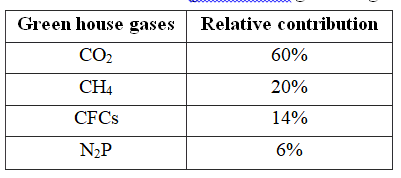
(iv) The excessive increase in concentrations of these gases in the atmosphere would retain more and more of the IR -radiation (long wave radiations), resulting in enhanced green house effect.
(v) CFC is most effective green house gas (effectiveness is 14,000 times more than CO2),
Effects of Green House Gases
(a) CO2 fertilization effect: Increase in atmospheric concentration of CO2 increases productivity of C3 plants and decreases rate of transpiration due to partial stomatal closure.
(b) Possible Effects of Global Warming
(i) Increasing of global temperature (increased 0.6°C, most of it during last 3 decades) and more extreme climatic conditions [EI Nino effect].
(ii) Warming of troposphere and cooling of stratosphere and thermosphere.
(iii) Global warming will push tropics into temperate areas and temperate areas towards pole (shifting of climatic zones) and higher altitudes in mountains resulting into changed species distribution.
(iv) Melting of ice caps.
(v) Rising of sea level, changes in rainfall pattern.
Control measures -Reduced deforestation, cutting down use of fossil fuel, planting trees, slowing down population growth.
II. Ozone Depletion
(i) Ozone layer is present in stratosphere at altitude of 23-25 km (conc. 0.3 ppm) and act as shield against UV radiation.
(ii) Large hole has appeared in ozone shield over Antarctica and smaller one over North pole. (Discovered by Farman 1985).
(iii) Ozone is commonly called as chemical weed, 'Bad' ozone is formed in troposphere that harms plants and animals. Good ozone is found in stratosphere as shield.
(iv) ODS: ozone depleting substances -CFC, CH4, CCl4, halons and N2O causes destruction of O3.
(v) CFC's are most damaging. They release Cl free radicals in stratosphere which destroy O3.
(vi) Thinning of the ozone-layer results in an increase in the UV-B radiation.
(vii) UV -B damages DNA and mutation may occur. It causes aging of skin, damage to skin cells and various types of skin cancers. A high dose of UV-B causes inflammation of cornea called snow blindness.
(viii) Nowadays CFC's are being replaced by Hydro Fluoro Carbons (HFCs).
DEGRADATION BY IMPROPER RESOURCE UTILISATION AND MAINTENANCE
The lowering of quality, fertility and productivity of land by various factors such as salination of soil, soil erosion, desertification, shifting cultivation and developmental activities etc. is called land degradation. It is caused by five main factors :
(i) Developmental activities:
Many developmental activities such as rapid urbanisation, human settlement, mining, construction of roads, dams, canals, railways, airports, playgrounds, industries cause loss of large areas of fertile and productive land.
(ii) Soil erosion:
It is the removal of top, fertile, mineral rich soil layer by water, floods, wind, ocean waves, glaciers, felling of trees, overgrazing on slopes or some arid soils, over cropping and improper farming techniques etc. It occurs in both wet and arid regions. Roots of grasses are excellent binding material and keep the soil intact and free from soil erosion.
(iii) Desertification:
It is the change of fertile soil into a non productive desert soil. It is due to the shifting of sand dunes by strong winds, or by deforestation, soil erosion or overgrazing in lands sparsely covered by grasses. Many deserts in the world are man-made. Afforestation is the only solution to prevent desertification.
(iv) Shifting cultivation:
In many tribal communities of tropical and subtropical regions of Africa and Asia, it is a practice of slashing, cutting down trees, burning the felled trees and raising crops on the ash formed. This practice is called 'Jhum Cultivation' in north east India. This destroys forests and causes soil erosion.
(v) Salination of Soil:
Increase in the concentration of soluble salts in the soil is called salination. Origin or development of saline soil depends upon following factors:
(a) Poor Drainage of Soil: Salts dissolved in irrigation water accumulate on the soil surface due to inadequate drainage especially during flood.
(b) Quality of Irrigation Water: The ground water of arid (dry, barren having not enough rainfall to support vegetation) regions are generally saline in nature. The irrigation water may be itself rich in soluble salts and add to salinity of soils.
(c) Excessive use of basic fertilizers: Excessive use of alkaline fertilizers like sodium nitrate, basic slag, etc may develop alkalinity in soil.
(d) Saline nature of parent rock materials: If soil develops from saline nature of parent rock materials, soil would be saline.
Control of degradation : Degradation can be checked by the following measures :
(i) Reforestation and plantation of grassess can check soil erosion, floods and water logging.
(ii) Crop rotation and mixed cropping improve fertility. It would increase production, which would support large population.
(iii) Salinity of the soil can be checked by providing adequate drainage.
(iv) Desertification can be checked by artificial bunds or covering the area with suitable soil binding vegetation.
DEFORESTATION
It is the conversion of forested areas to non-forested ones. It is estimated that almost 40 per cent forests have been lost in the tropics, compared to only 1 per cent in the temperate region.
At the beginning of the twentieth century, forests covered about 30 per cent of the land of India. By the end of the century, it shrunk to 19.4 per cent, whereas the National Forest Policy (1988) of India has recommended 33 per cent forest cover for the plains and 67 per cent for the hills.
Trees are axed for timber, firewood, cattle ranching and for several other purposes. Slash and burn agriculture, has also contributed to deforestation.
One of the major effects of deforestation is increased carbon dioxide concentration in the atmosphere. It also causes loss of biodiversity due to habitat destruction, disturbs hydrologic cycle, causes soil erosion, and may lead to desertification in extreme cases.
Reforestation is the process of restoring a forest it may also occur naturally in a deforested area.
Case Study of People's Participation in Conservation of Forests
A Bishnoi woman of Khejarli village, Jodhpur, Rajasthan named Amrita Devi showed exemplary courage by hugging a tree.
Amrita Devi Bishnoi Wildlife Protection Award - for individuals or communities from rural areas that have shown extraordinary courage and dedication in protecting wildlife.
Chipko Movement. It is movement which was initially meant for protecting trees but not meant for preservation of environment including habitat and wildlife. Chipko movement was born in March 1974 in Gopeshwar in Chamoli district. The movement has two leaders, Chandi Prasad Bhatt of Gopeshwar and Sunder Lal Bahugana of Silyara in Tehri region. A similar movement was undertaken by Paudurang Hedge in the South. It is known as appiko movement.
Government of India in 1980s has introduced the concept of Joint Forest Management (JFM) so as to work closely with the local communities for protecting and managing forests.
ENVIRONMENTAL LAWS FOR CONTROLLING POLLUTION
Important legislations directed at the protection of environment in India are listed below:
(i) The Environment (Protection) Act, 1986
(ii) The Insecticide Act, 1968
(iii) The Water (Prevention and Control of Pollution) Act, 1974
(iv) The Air (Prevention and Control of Pollution) Act, 1981 (Amended in 1987 to include noise as an air pollutant.)
International Initiatives for Mitigating Global Change
The long-term challenge of stabilising the atmospheric concentrations of greenhouse gases requires that global emissions be significantly lowered than what they are today.
In 1987, many countries signed the Montreal Protocol (effective in 1989) at Montreal (Canada), a landmark international agreement to protect the stratospheric ozone by agreeing to limit the production and use of ozone-depleting substances, phasing out of ozone-depleting substances and helping the developing countries to implement use of alternatives to CFCs.
The United Nations Conference on Environment and Development (UNCED, Earth Summit), held at Rio de Janeiro, Brazil in 1992, established the principles for reducing greenhouse gas emission.
The Kyoto Protocol, approved by a follow-up conference held in Kyoto, Japan, during December 1997, has specified the commitments of different countries to mitigate climate change.
This protocol requires countries to take appropriate measures to reduce their overall greenhouse gas emissions to a level at least 5% below the 1990 level by the commitment period 2008-2012.
Radioactive wastes
- Books Name
- A TEXT OF BIOLOGY - CLASS XII
- Publication
- ACME SMART PUBLICATION
- Course
- CBSE Class 12
- Subject
- Biology
RADIOACTIVE WASTES
It is physical pollution of air, water and soil with radioactive materials.
Radioactivity is the property of certain elements (radium, thorium, uranium etc.) to spontaneously emit protons (alpha particles), electrons (beta particles) and gamma rays (electromagnetic waves of very short wavelength) by disintegration of their atomic nuclei.
The elements that give radiation are called radioactive elements.
The use of nuclear energy has two very serious inherent problems.
The first is accidental leakage, as occurred in the Three Mile Island and Chernobyl incidents and the second is safe disposal of radioactive wastes.
It causes mutations to occur at a very high rate.
At high doses, nuclear radiation is lethal and at lower doses, it creates various disorders, the most frequent of all being cancer.
It has been recommended that storage of nuclear waste, after sufficient pre-treatment, should be done in suitably shielded containers buried within the rocks, about 500 m deep below the earth's surface.
Production of nuclear weapons involves the tests of nuclear arms.
These tests produce large amount radioactive elements into the environment and make other materials also radioactive. They include strontium-90, cesium-137, iodine-131 and some others.
The radioactive materials are transformed into gases and fine particles which are carried to distant places by wind.
When rain drops, the radioactive particles fall on the ground, it is called fall out.
Strontium-90 accumulates in the bones, replaces calcium and may cause bone cancer and tissue degeneration in most animals and man.
The operation of a nuclear power plant releases large amounts of energy.
This energy is used in large turbines, which produce electricity.
Wastes from atomic reactors also contain radioactive materials.
The biggest problem is the disposal of these radioactive wastes.
If these wastes are not properly disposed off, can harm the living organisms wherever they may be dumped.
NOISE POLLUTION
The quality of our environment is judged, apart from other factors, by the amount of noise present.
Noise has been defined as "unwanted sounds" which is being "dumped" into the atmosphere to disturb the unwilling ears.
It adversely affects our physiological and mental health.
Noise is measured by a sound meter and is expressed in a unit called decibel (dB).
Any value more than 80 dB causes noise pollution.
Noise becomes unbearable at 140 dB.
The quietest sound that man's ear can detect is known as threshold of hearing.
A noise that hurts one's ears and gives headache is called threshold of pain.
The role of sound vibrations is measured in cycles per second (cps) or hertz (Hz).
The ear is potentially liable to damage, if it receives high intensity noise.
Noise in general is a physical form of pollution.
It has no persistent adverse effects on the life supporting systems but, has direct effects on the recipients.
Moderate conversation = 60 dB
Loud conversation = 70 dB
Scooter = 80 dB
Truck / Bus = 90 dB
Jet aeroplane = 150 dB
Rocket = 180 dB
Zone-wise permissible ambient noise levels (acoustic zoning) are given below. (According to central pollution control board)

I. Sources of Noise Pollution
Noise can either be natural like thundering sound or man made. The main sources of man made noise pollution are:
(i) Annoying and damaging sounds of various industries.
(ii) Defence material like rockets, tanks etc.
(iii) Entertainment sources like record players, radios, cassette players, loud speakers etc.
(iv) Transport automobiles and other vehicles such as trucks, buses etc.
II. Effects of Noise Pollution
Noise causes some serious damaging effects which are briefed as follows :
(i) Diminish hearing. Noise damages the ears, causes temporary or permanent noise induced hearing loss, depending upon the intensity and duration of the noise level. It leads to auditory fatigue and may finally lead to deafness. A sudden loud noise of any explosion may damage the tympanic membrane permanently. Sudden noise is more harmful than the continuous one. Factory workers suffer chronic hearing loss after many years of occupational noise exposure.
(ii) It has adverse effects on thinking and coordination of limbs.
(iii) Noise affects verbal communication on which we depend in all kinds of environment.
(iv) Noise increases blood cholesterol level, causes high B.P., digestive spasm, decreased heart output, defective night and colour vision. It impairs the development of nervous system of unborn babies which leads to abnormal behaviour in later life.
Control of Noise Pollution
Noise pollution can be controlled by following measures :
(i) Green muflur scheme. Trees such as Neem and Ashoka absorb sound vibrations to a great extent. Plantation of these trees on both sides of the roads, around silent zones reduces the menace of noise pollution.
(ii) Sound absorbing material should be used for reducing industrial noise.
(iii) Noise producing agencies should be located far away from residential areas. Vehicular traffic should be directed away from the human dwellings, educational institutions and hospitals etc.
(iv) General awareness should be developed among the people to minimize noise pollution in the environment.
Greenhouse effects and global warming
- Books Name
- A TEXT OF BIOLOGY - CLASS XII
- Publication
- ACME SMART PUBLICATION
- Course
- CBSE Class 12
- Subject
- Biology
Effects of Green House Gases
(a) CO2 fertilization effect: Increase in atmospheric concentration of CO2 increases productivity of C3 plants and decreases rate of transpiration due to partial stomatal closure.
(b) Possible Effects of Global Warming
(i) Increasing of global temperature (increased 0.6°C, most of it during last 3 decades) and more extreme climatic conditions [EI Nino effect].
(ii) Warming of troposphere and cooling of stratosphere and thermosphere.
(iii) Global warming will push tropics into temperate areas and temperate areas towards pole (shifting of climatic zones) and higher altitudes in mountains resulting into changed species distribution.
(iv) Melting of ice caps.
(v) Rising of sea level, changes in rainfall pattern.
Control measures -Reduced deforestation, cutting down use of fossil fuel, planting trees, slowing down population growth.
GLOBAL ENVIRONMENT CHANGE
CO2, CH4, N2O and CFCs are radiatively active gases and also called green house gases.
The increased amounts of these gases in atmosphere is affecting the global climate and this phenomenon is known as global climatic change.
I. Green House Gases and Global Warming
(i) Term green house effect was coined by Arrhenius.
(ii) Green house gases trap the long wave radiations. A part of this energy is re-radiated back to the surface of earth. The downward flux of long wave radiation by green house gases is called green house flux.
(iii) The phenomenon of keeping the earth warm due to presence of certain radiatively active gases in the atmosphere is called green house effect, without which the average temperature of earth would have been between -18°C to -20°C rather than present average of 15°C.
Relative contribution of different green house gases to global warming

(iv) The excessive increase in concentrations of these gases in the atmosphere would retain more and more of the IR -radiation (long wave radiations), resulting in enhanced green house effect.
(v) CFC is most effective green house gas (effectiveness is 14,000 times more than CO2),
Ozone depletion in the stratosphere
- Books Name
- A TEXT OF BIOLOGY - CLASS XII
- Publication
- ACME SMART PUBLICATION
- Course
- CBSE Class 12
- Subject
- Biology
Ozone Depletion
(i) Ozone layer is present in stratosphere at altitude of 23-25 km (conc. 0.3 ppm) and act as shield against UV radiation.
(ii) Large hole has appeared in ozone shield over Antarctica and smaller one over North pole. (Discovered by Farman 1985).
(iii) Ozone is commonly called as chemical weed, 'Bad' ozone is formed in troposphere that harms plants and animals. Good ozone is found in stratosphere as shield.
(iv) ODS: ozone depleting substances -CFC, CH4, CCl4, halons and N2O causes destruction of O3.
(v) CFC's are most damaging. They release Cl free radicals in stratosphere which destroy O3.
(vi) Thinning of the ozone-layer results in an increase in the UV-B radiation.
(vii) UV -B damages DNA and mutation may occur. It causes aging of skin, damage to skin cells and various types of skin cancers. A high dose of UV-B causes inflammation of cornea called snow blindness.
(viii) Nowadays CFC's are being replaced by Hydro Fluoro Carbons (HFCs).
Degradation by improper resource utilisation
- Books Name
- A TEXT OF BIOLOGY - CLASS XII
- Publication
- ACME SMART PUBLICATION
- Course
- CBSE Class 12
- Subject
- Biology
DEGRADATION BY IMPROPER RESOURCE UTILISATION AND MAINTENANCE
The lowering of quality, fertility and productivity of land by various factors such as salination of soil, soil erosion, desertification, shifting cultivation and developmental activities etc. is called land degradation. It is caused by five main factors :
(i) Developmental activities:
Many developmental activities such as rapid urbanisation, human settlement, mining, construction of roads, dams, canals, railways, airports, playgrounds, industries cause loss of large areas of fertile and productive land.
(ii) Soil erosion:
It is the removal of top, fertile, mineral rich soil layer by water, floods, wind, ocean waves, glaciers, felling of trees, overgrazing on slopes or some arid soils, over cropping and improper farming techniques etc. It occurs in both wet and arid regions. Roots of grasses are excellent binding material and keep the soil intact and free from soil erosion.
(iii) Desertification:
It is the change of fertile soil into a non productive desert soil. It is due to the shifting of sand dunes by strong winds, or by deforestation, soil erosion or overgrazing in lands sparsely covered by grasses. Many deserts in the world are man-made. Afforestation is the only solution to prevent desertification.
(iv) Shifting cultivation:
In many tribal communities of tropical and subtropical regions of Africa and Asia, it is a practice of slashing, cutting down trees, burning the felled trees and raising crops on the ash formed. This practice is called 'Jhum Cultivation' in north east India. This destroys forests and causes soil erosion.
(v) Salination of Soil:
Increase in the concentration of soluble salts in the soil is called salination. Origin or development of saline soil depends upon following factors:
(a) Poor Drainage of Soil: Salts dissolved in irrigation water accumulate on the soil surface due to inadequate drainage especially during flood.
(b) Quality of Irrigation Water: The ground water of arid (dry, barren having not enough rainfall to support vegetation) regions are generally saline in nature. The irrigation water may be itself rich in soluble salts and add to salinity of soils.
(c) Excessive use of basic fertilizers: Excessive use of alkaline fertilizers like sodium nitrate, basic slag, etc may develop alkalinity in soil.
(d) Saline nature of parent rock materials: If soil develops from saline nature of parent rock materials, soil would be saline.
Control of degradation : Degradation can be checked by the following measures :
(i) Reforestation and plantation of grassess can check soil erosion, floods and water logging.
(ii) Crop rotation and mixed cropping improve fertility. It would increase production, which would support large population.
(iii) Salinity of the soil can be checked by providing adequate drainage.
(iv) Desertification can be checked by artificial bunds or covering the area with suitable soil binding vegetation.
Deforestation
- Books Name
- A TEXT OF BIOLOGY - CLASS XII
- Publication
- ACME SMART PUBLICATION
- Course
- CBSE Class 12
- Subject
- Biology
DEFORESTATION
It is the conversion of forested areas to non-forested ones. It is estimated that almost 40 per cent forests have been lost in the tropics, compared to only 1 per cent in the temperate region.
At the beginning of the twentieth century, forests covered about 30 per cent of the land of India. By the end of the century, it shrunk to 19.4 per cent, whereas the National Forest Policy (1988) of India has recommended 33 per cent forest cover for the plains and 67 per cent for the hills.
Trees are axed for timber, firewood, cattle ranching and for several other purposes. Slash and burn agriculture, has also contributed to deforestation.
One of the major effects of deforestation is increased carbon dioxide concentration in the atmosphere. It also causes loss of biodiversity due to habitat destruction, disturbs hydrologic cycle, causes soil erosion, and may lead to desertification in extreme cases.
Reforestation is the process of restoring a forest it may also occur naturally in a deforested area.
Case Study of People's Participation in Conservation of Forests
A Bishnoi woman of Khejarli village, Jodhpur, Rajasthan named Amrita Devi showed exemplary courage by hugging a tree.
Amrita Devi Bishnoi Wildlife Protection Award - for individuals or communities from rural areas that have shown extraordinary courage and dedication in protecting wildlife.
Chipko Movement. It is movement which was initially meant for protecting trees but not meant for preservation of environment including habitat and wildlife. Chipko movement was born in March 1974 in Gopeshwar in Chamoli district. The movement has two leaders, Chandi Prasad Bhatt of Gopeshwar and Sunder Lal Bahugana of Silyara in Tehri region. A similar movement was undertaken by Paudurang Hedge in the South. It is known as appiko movement.
Government of India in 1980s has introduced the concept of Joint Forest Management (JFM) so as to work closely with the local communities for protecting and managing forests.
ENVIRONMENTAL LAWS FOR CONTROLLING POLLUTION
Important legislations directed at the protection of environment in India are listed below:
(i) The Environment (Protection) Act, 1986
(ii) The Insecticide Act, 1968
(iii) The Water (Prevention and Control of Pollution) Act, 1974
(iv) The Air (Prevention and Control of Pollution) Act, 1981 (Amended in 1987 to include noise as an air pollutant.)
International Initiatives for Mitigating Global Change
The long-term challenge of stabilising the atmospheric concentrations of greenhouse gases requires that global emissions be significantly lowered than what they are today.
In 1987, many countries signed the Montreal Protocol (effective in 1989) at Montreal (Canada), a landmark international agreement to protect the stratospheric ozone by agreeing to limit the production and use of ozone-depleting substances, phasing out of ozone-depleting substances and helping the developing countries to implement use of alternatives to CFCs.
The United Nations Conference on Environment and Development (UNCED, Earth Summit), held at Rio de Janeiro, Brazil in 1992, established the principles for reducing greenhouse gas emission.
The Kyoto Protocol, approved by a follow-up conference held in Kyoto, Japan, during December 1997, has specified the commitments of different countries to mitigate climate change.
This protocol requires countries to take appropriate measures to reduce their overall greenhouse gas emissions to a level at least 5% below the 1990 level by the commitment period 2008-2012.

 ACME SMART PUBLICATION
ACME SMART PUBLICATION
